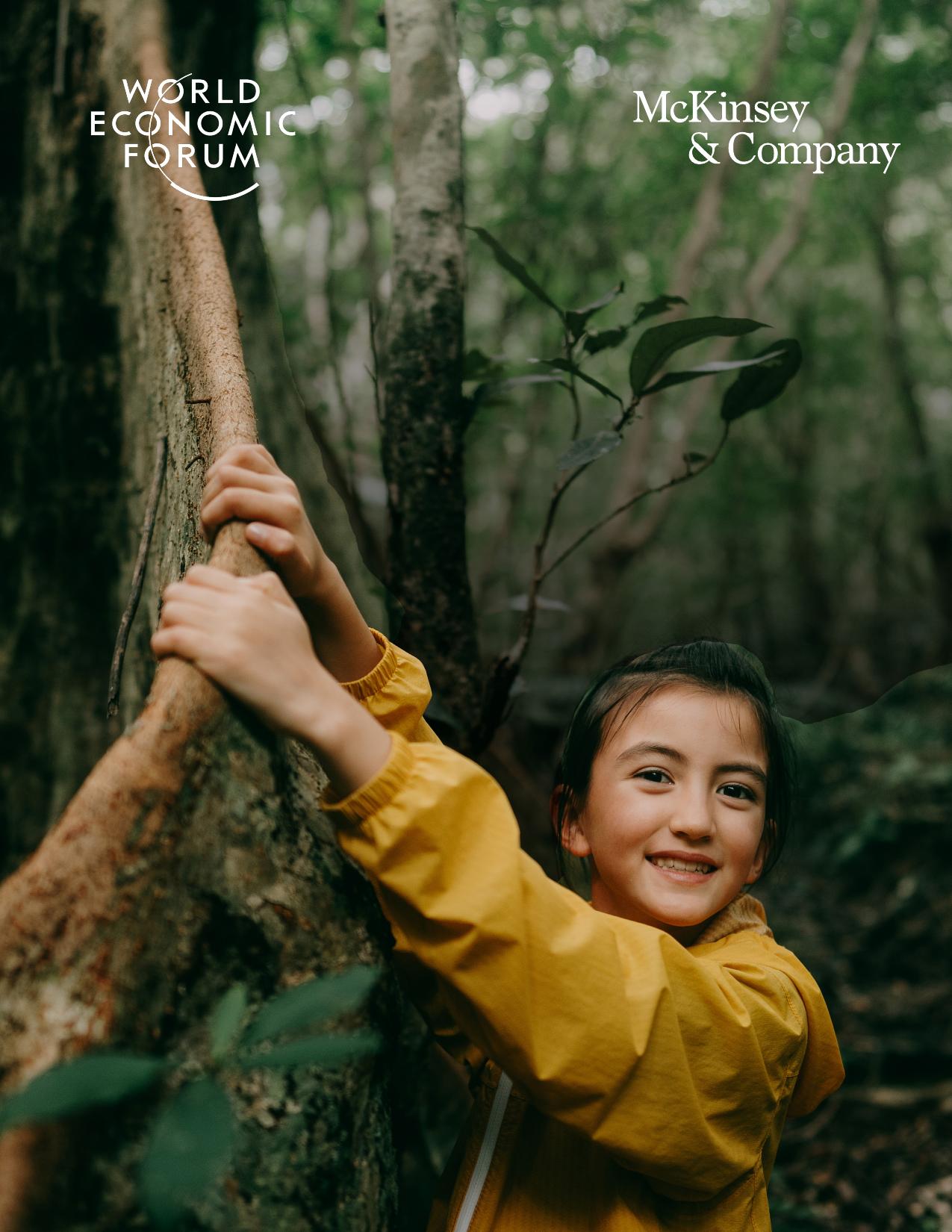incollaborationwithTheroleofpublic–private–philanthropicpartnershipsindrivingclimateandnaturetransitionsNovember2023©GettyImagesTheroleofpublic–private–philanthropicpartnershipsindrivingclimateandnaturetransitionsNovember2023ContentsPrefaceInbriefExecutivesummary1.Howmultistakeholdermodelsareaddressingclimateandnaturetransitions2.Identifyingfocusareassuitedto4Pmodels3.Identifyinghigh-potentialfocusareasfor4Pmodels4.SixdeepdivesintosolutionsforclimateandnatureAppendixA:MethodologyAppendixB:The4PmodelsreviewedBibliographyTheroleofpublic–private–philanthropicpartnershipsindrivingclimateandnaturetransitions1PrefaceThisreportwascreatedbytheWorldEconomicForum(WEF)incollaborationwithMcKinseySustainability.Itispartofagrowingbodyofresearchexaminingwaystoadvanceamoreorderlyclimateandnature-positivetransition.Itfocusesspecificallyonpartnershipsbetweenpublic,private,andphilanthropicactors,or“4Pmodels.”Thesepartnerships,whichoftenalsofeaturesocial-sectoranchorsandexecutors,areanemergingmodeldesignedtoaddressthecomplex,multistakeholderandsystem-levelshiftsrequiredtosupportclimateandnaturetransitions.Creatingthesemodelscanbecomplex,requiringsignificantcollaborativeeffortandalongrunway.Ourresearchaimstosupportthecreation,sustenance,andscalingofthesepartnershipsbyexploringwheretofocustheireffortsandhowtoensuretheirsuccess.ThisresearchwasdirectedbyMcKinseyseniorpartnersHamidSamandariinWashington,DC,andDanielPacthodinNewYork;partnersShallyVenugopalandTracyNowskiinWashington,DC;MekalaKrishnaninBoston;AdamKendallinNairobi;associatepartnerJaredGoodmaninWashington,DC,andconsultantPiersRosholtinNewJersey.TheresearchteamwascomprisedofMayaBerlinger,JackHoskins,LennartJoos,NickKingsmill,DevinLee,FlorisLeijten,EricMaltzer,NomaMoyo,ElizabethRolfes,andMarkusWalther.SeveralMcKinseycolleaguesprovidedvaluableinputandexpertise:RuiChen,CharlieDixon,DukoHopman,JoshuaKatz,JakeWellman,andDeeYang.Theauthorswishtothankthemanyindividualsrepresentingpublic,private,andphilanthropicperspectives,includingsignatoriestotheWorldEconomicForum’sGAEAinitiative,whogenerouslycontributedtheirtime,expertise,andperspectives.SpecialthanksareextendedtoWEFcollaborators,includingLuisAlvarado,JackHurd,YvonneLeung,GimHuayNeo,andRobvanRiet.2Theroleofpublic–private–philanthropicpartnershipsindrivingclimateandnaturetransitionsInbriefPartnershipsbringingtogetherthepublicsector,theprivatesector,andthephilanthropicsectorareincreasinglyemergingtoaddressclimateandnaturechallengessuchastacklingthenet-zerotransition,reducingforestloss,andpromotingbiodiversity.Suchpublic–private–philanthropicpartnerships(4Pmodels)canrequireconsiderableeffortandcommitmenttopulltogetherandusetodeliversuccessfulimpact.Thisresearchtakesacloserlookatexisting4Pmodelsandusesadata-drivenapproachtosuggestaframeworkthatcouldhelpidentifysolutionfocusareaswherea4Pconstructismostneeded,iswellsuited,andjustifiesthecollaborativeeffort.Keyfindingsincludethefollowing:Ascross-sectoralandmultistakeholdercollaborations,4Pmodelsarebynaturewellsuitedtoaddressingcomplexclimateandnaturechallenges.Suchchallengesrequiredeep,system-leveltransformation,whichinturnrequiresanunderstandingoftheneedsandconstraintsofabroadsetofactors,theabilitytobringtheseactorstogetheraroundwell-definedobjectives,thewillingnesstotakealonger-termperspective,thecapacitytorunarobustday-to-dayoperation,andanappetiteforexperimentation.Morethan504Pmodelshaveemergedinthepast20years,showingearlyindicationsofprogressbutalsohighlightingthechallengesofproperlydefining,executing,andscalingsuchpartnerships.Examplesincludeamarineconservationgrantprogramfundedbysavingsfromadebt-for-natureswapintheSeychellesandaUS-government-ledpartnershiptoincreaseenergyaccessandlow-carbongrowthacrosssub-SaharanAfrica.Aframeworkrestingonthreepillars—materiality,suitability,andfeasibility—canhelpidentifyorassesspriorityfocusareasfor4Pmodels.Basedonouranalysisofexistingmodels,weproposeasystematicapproachthathighlightsasetofglobalsolutionfocusareasinwhich4Pmodelsarehighlyrelevant(recognizingthepossibilitythat4Pmodelsmightalsobesuccessfulelsewhere).—Materiality.Bymateriality,wemeanensuringthat4Pmodelsaredirectedtowardareasrepresentingthegreatestsocietalneedsandpotentialforbenefit.Theneedforchangeimpliedbythematerialitycriteriaisnotmerelytiedtothesizeofasolutionorthescaleofresourcesrequired.Materialityfocusesoncountries,systems,andsectorsthathavethelowestcapacitytorespond,greatestneeds,andmosttogainintermsoflivelihoodandwell-beingimpactsthatmayresultfromaddressingplanetarychallenges.—Suitability.Focusingonsuitabilityensuresthatthetypesofsolutionsinwhich4Pmodelsinvesttime,energy,andresourcesarewellmatchedtothestrengthsofthisformofcollaborationandthattheinterestsofallthreetypesofpartnersarealigned.Prioritizingsolutionfocusareasinvolvestwocriteria.Thefirstistoconsiderfocusareasthatarebeyondexploratorydevelopmentbutnotyetatpositiveinflectionpointsinwidescale,commercialadoption.Thesecondistogiveprioritytoareaswherethemodelitselfwillhavehighpotentialforimpact(includingurgencyandsocioeconomicco-benefits),highscalabilitypotential,andadditionalityofaction.—Feasibility.Thefeasibilityofa4Pmodelmustbeassessedatthelevelofthemodelitselfandalignsitsscopewithitsdesiredambitionsandintendedoutcomes.Crucially,a4Pmodel’sfeasibilitywilldependonitshavingascopethatisatoncebroadenoughtobeeffectiveandnarrowenoughtobeachievable.Inaddition,afeasiblemodelcanattractananchorstakeholderwillingtoexperimentwithnewapproaches,havetherightlevelofcapitalandresourcesrelativetoitsambition,andalignthethreesetsofpartnersonquestionsofrisk,return,andimpact.4Theroleofpublic–private–philanthropicpartnershipsindrivingclimateandnaturetransitionsApplyingthisframeworktomorethan130potentialclimateandnaturesolutionsetsandsixglobalsectorshighlights31solutionfocusareasprimedfor4Pactiontoday.Ouranalysisisinformedbyfourofthenineplanetaryboundaries:climatechangemitigation,biodiversityloss,forestcoverloss,andfreshwaterconsumption.1Unsurprisingly,prioritysolutionfocusareasthatemergefromthisanalysisareprimarilyconcentratedinthepowerandtheagricultureandforestrysectorsandinlandconservation.Whileouranalysisprioritizes31focusareas,4Pmodelsmaywellbeeffectivemechanismsoutsidethesefocusareas,particularlywhenconsideredatregionalandnationallevels(ratherthanatthegloballevel),aswellaswithinspecificsectorsandsubsectors.These31solutionfocusareasareassociatedwith30percentofglobalemissionsand30percentoftotallandarea.Thus,effectiveactionby4Pmodelscouldhavesignificantbenefitfortheworld.Toillustratethepotential,wepresentdeepdivesthatexaminesixofthesepriorities:phasingoutcoalpowerinthePhilippines,restoringdegradedmangrovesinIndonesia,improvingpastureandanimalhealthinBrazil,ensuringequitableaccesstoelectrifiedtransportationintheUnitedStates,increasingthemitigationandresiliencyopportunitiesforriceproductioninThailand,andexpandingcleancoolinginIndia.Ananalysisof4Pmodelssuggestsfivelearningsforsuccessfulimplementation.Firstisthevalueofestablishingananchorpartnertoconvenetheothersandassurerobustgovernance.Critically,thisanchorhelpsthepartnershiptakeanoutcomes-focusedviewandprovidesomeofthestart-upcapitalandrunwaytothemultiyearprocessofgettinga4Pmodelofftheground,sustainingaction,andgraduallyachievingimpact.Second,aneffectivestrategicmodelistwo-pronged,combiningopportunisticstrategiestotakeadvantageofmomentswhenpoliticalwillandfundingmomentumcometogetherwithalong-gamestrategythataddressestheinfrastructure,enablingconditions,andbehavioralshiftsneededtosupportlastingchange.Third,buildingonapreexistingmodelwherepossible,ratherthanstartingfromscratch,canleapfrogthestart-upandvalidationprocess.Thisapproachcouldincludeharnessingexistinginitiativesledbyfamilyoffices,corporatefoundations,cityandregionalgovernments,andsmallandmedium-sizeenterprises.Fourth,consideringandcommunicatingthepotentialofclimateandnaturesolutionstoaddressothersustainabledevelopmentgoals(includinghealth,poverty,andequity)cantapawiderpooloffundingandchannelsofimpact.Finally,first-of-their-kind4Pconstructsmayrequiresubstantialresourcesandawell-functioningoperationalmachine,sotheywillneedanadequaterunwaybeforetheyachievesuccess.Thisreportrepresentsapoint-in-timeview,basedontheneedsandrealitiesoftoday.Thesolutionfocusareaswillevolveovertimeandshouldinnowayexcludeotherideasthatalreadyhavemomentumorhighpotentialforimpact.Ouranalysistakesaglobalperspectivegroundedincountryarchetypes;insomegeographiesandmarkets,differentsolutionfocusareasmaybepertinent.Nonetheless,ourhopeisthatthisresearchwillhelpinformthegrowingglobalinterestinharnessing4Pmodelstoaddresssomeofourera’smostpressingchallenges.1WillSteffenetal.,“Planetaryboundaries:Guidinghumandevelopmentonachangingplanet,”Science,January2015,Volume347,Number6223.Theroleofpublic–private–philanthropicpartnershipsindrivingclimateandnaturetransitions56ExecutivesummaryThepressingneedforclimateandnatureactionisincreasinglyfeltacrosstheworld.Inresponse,governmentsandcompanieshavebeenmultiplyingcommitmentsandactionsinareassuchasthenet-zerotransition,biodiversitylossprevention,andbroadernatural-capitalpreservation.2Thesehaveinturnacceleratedthemomentumforpublic–privatepartnershipsthatcombinethepublicsector’sabilitytocreateenablingconditionswiththeprivatesector’sscalingability.Fortheirpart,philanthropiesareincreasinglyturningtheirattentiontoclimateandnature,seeingthemaskeychallengesintheirownrightandasintimatelylinkedtothecoreissuesofequityanddevelopmentthathavelongbeenattheheartoftheiragendas.Wenowseeearlysignsofthepublic,private,andphilanthropicsectors—oftenalongsideabroaderrangeofsocial-sectoractors(includingNGOs,nonprofits,thinktanks,andcommunityorganizations)—embracingsuchpartnershipstotacklesystemicclimateandnaturechallenges.Thesepublic–private–philanthropicpartnerships,or4Pmodels,haveincludedtransactionalfinancing,industry-targetedinitiatives,andwide-rangingknowledge-sharingplatforms.Theyoften(butnotalways)focusonemergingeconomies.Thisreportsuggestsaframeworkforsuchmultistakeholdermodels.Itisbasedonadata-drivenanalysisofmorethan50existingpartnershipsandhundredsofclimateandnaturesolutions,alongsidedozensofexpertinterviews.Itisintendedtohelpensurethattime,energy,andresourcesaredirectedtowardthesolutionareasthatjustifythesignificantcollaborativeeffort4Pmodelsentail.Weidentified31solutionfocusareasamongalmost135globalclimateandnaturesolutionsetsthatareprimedforhighandimmediateimpactthrough4Pmodels.Ouranalysisrevealedthatsolutionareaswithinthepowerandtheagricultureandforestrysectors,aswellasthoseaddressinglandconservation,consistentlydemonstratehighpotentialforimpactacrossmultiplegeographies.Thisshouldnotcomeasasurprise,asthesesectorsarecentraltoclimateandnaturetransitions,havecascadinginfluenceacrossallpartsoftheglobaleconomy,andfeatureproven(butnotyetwidelyadopted)climateandnaturesolutionswithhighsocioeconomicco-benefitsandpotentialforscale.Collectively,weestimatethatthese31identifiedareasgloballyaccountforabout30percentofglobalemissionsand30percentoftotallandarea(Exhibit1).3Thus,effectiveactionby4Pmodelscouldhavesignificantpositiveimpact.Inthisreport,wedivedeeperintosixoftheseidentifiedareasaroundtheglobetoshowcasehowsolutionssuchassupportingenergytransitionsandrestoringmangrovescanbenefitfrom4Pmodels.Thesepartnershipsareevolvingrapidly,andwecontinuetobuildourlibraryofusecasesandhigh-impactsolutionfocusareas.Thisreportseekstobeneitherprescriptivenoracomprehensiveassessment(seesidebar“Scopeandlimitationsofmaterialityandsuitabilityanalysis”).Nevertheless,wehopeitwillcontributetoidentifyingandimplantingthebestwaysfordifferentsocietalactorstocollaborateonessentialquestionsrelatingtothefutureoftheplanet.2McKinseyhaspublishedextensivelyonthesetopics.Recentreportsinclude“Thenet-zerotransition:Whatitwouldcost,whatitcouldbring,”January2022;“Theenergytransition:Aregion-by-regionagendafornear-termaction,”December15,2022;and“Natureinthebalance:Whatcompaniescandotorestorenaturalcapital,”December5,2022.3Theemissionsnumberwascalculatedbasedontheemissionsassociatedwiththerelevantsubsectorinprioritizedgeographies.Forexample,thecalculationforthetransportsolutionfocusareasincludesemissionsfromfuelcombustionincountriesthatarefossilfuelresourceproducers,service-basedeconomies,anddownstream-emissionsmanufacturers(seeAppendixAforcountrydescriptions).Thelandnumberwascalculatedbasedontherelevantlandareacoveredbytheprioritizedhotspots.Theroleofpublic–private–philanthropicpartnershipsindrivingclimateandnaturetransitions7Exhibit1Thirty-onesolutionfocusareasareassociatedwith30percentofglobalemissionsand30percentofgloballandarea.Numberofpotentialsolutionfocusareas,bysolutiontypeandsectorClimatesolutionsNaturesolutionsIndustryPowerTransportAgricultureIndustryAgricultureSupplyandforestry36andforestry242322199Longlistof1potentialsolutionfocusareas32232321148Filteredby1proximitytotippingpoint16Filteredby10117impact414potential12866Filteredby411scalability1266Filteredby331additionality030%30%shareofglobalemissionsassociatedshareofgloballandareaassociatedwiththe18climatesolutionfocusareaswiththe13naturesolutionfocusareaswell-suitedtothe4Pmodelwell-suitedtothe4PmodelMcKinsey&Company8Theroleofpublic–private–philanthropicpartnershipsindrivingclimateandnaturetransitionsScopeandlimitationsofmaterialityandsuitabilityanalysisThisreportpresentsapoint-of-timeviewThisinherentlyrequiressettingthresholdsanalysis,existing4Pmodelsshowthatitof4Pmodelsandtheirareasoffocus,andforthevariouscriteria.Changingthesewouldpassthroughtheremainderofthethesemaychangeovertime.Theglobalthresholds—particularlyasnewinfor-framework.Similarly,4Pmodelsthatfocussolutionfocusareasidentifiedbytheanal-mationbecomesavailable—wouldaffectonearly-stagetechnologiesalsowouldysisarenotmeanttoprecludethepotentialwhichsolutionfocusareasareprioritizednotpassthefirststageofoursuitabilityofnewmodelstosucceed,nortoexclude(seeChapter3foradiscussionofalterna-thresholdbutmayproveviable.otherideasthatalreadyhavemomentum.tiveprioritization).Insomegeographiesandmarkets,thean-Accordingly,thislistofsolutionfocusareasswerswillbedifferent.Rather,thisanalysisMoreover,thisanalysishasbeenorderedisnotmeanttobeexclusionary.Rather,seekstohighlightsolutionareasrequiringsequentially,whichisnotalwayshowideaswhenideasemergeorganically,organiza-urgentinterventionandwhere4Pmodelsareprioritizedintherealworld.Solutiontionscouldtaketheseideasthroughthecouldunlockmajorsystemschange.focusareasthatseemlesssuitedbasedrestoftheframeworktoensureimpact,ononepartoftheframeworkbutmoreparticularlyinareasthatattractsignificantFurther,ourresearchhaslimitationsandsuitedbasedontheremainingcriteriainterestacrossthepublic,private,andcontinuestoevolve,andthisreportshouldcouldstillresultinasuccessful4Pmodel.philanthropicsectors.notbetakenasourfinalwordonthetopic.Forexample,some4PmodelsfocusonForexample,thisanalysisprioritizesthedecarbonizingshipping.Althoughshippinglargestareasfor4Pmodelintervention.didnotpassthefirststageofoursuitabilityClimateandnaturechallengeslendthemselvestomultistakeholdercollaborationSolvingclimateandnaturechallengesentailsdeep,system-leveltransformation.Thisinturnrequiresanunderstandingoftheneedsandconstraintsofabroadanddiversesetofactors,theabilitytobringthoseactorstogethertoaddresswell-definedobjectives,thewillingnesstotakealong-termperspectivethatallowsforactiontodaywithbenefitsinthefuture,thecapacitytorunarobustday-to-dayoperationwithateamwhosedutiesincludeensuringthepartnershipstaysontrackwithitsinitiatives,andanappetiteforexperimentationandrisk-taking.Bytheirverynature,4Pmodelsarewellsuitedtoaddresstheseissues,becausetheybringtogethermanyactors,eachwithdifferentcapabilitiesandstrengths:—Thepublicsectorcanenactpolicies,putinplaceincentives,regulations,andsupportmechanisms,andinvestfundstosupportsolutionsandcreatestableandpositiveenablingconditionsforfurtherinvestments.—Theprivatesector,includingcorporationssupportedbyinvestors,canestablishtherequiredbusinessmodelsandmobilizeresourcestogrowanddeploysolutionsatscale.—Philanthropicsectorscanleveragetheirhigherrisktolerance,longertimehorizons,andknowledgeofintergenerationalandequityissuestoinvestinsolutionsthatarenotyetwidelyadopted.Philanthropiescanalsobringanend-to-endcross-sectoralviewtoenableclosercollaborationacrossactors.—Thebroadersocialsector(forexample,NGOs/non-profitssuchasadvocacyorganizations,thinktanks,andserviceproviders),whenbroughtintothepartnership,canensuresolutionsaredeliveringimpactforallstakeholders,includingwomen,children,indigenouscommunities,andthosewhosevoicesarelessoftenheard.Theroleofpublic–private–philanthropicpartnershipsindrivingclimateandnaturetransitions9Morethan50such4Pmodelswithintheclimateandnaturespacehaveemergedinthelasttwodecades,providingasignofearlyprogressintacklingsomeissuesjointly.TheInitiative20x204Pmodelhasconvened150partnersandaimstochangethedynamicsoflanddegradationinLatinAmericaandtheCaribbeanandadvancedrestorationacrosstheregion.Thepartnershiphascommitted$2.5billionofprivatecapitaltosupportgovernmentcommitmentstoprotectandrestoremorethan50millionhectaresofland.Insub-SaharanAfrica,thedecade-oldPowerAfricadescribesitselfasaUS-government-ledpartnershipthatbringstogetherpoliticalleaders,companies,andfinancialinstitutionstoincreaseenergyaccessandlow-carboneconomicgrowthintheregion.Inthelasttenyears,accordingtoitswebsite,PowerAfricahassupported37.5millionnewconnectionsandhasclosedon14,000megawattsofcleanenergyprojects.The4Pmodel,whilemostoftendeployedinemergingeconomies,canalsobeeffectiveinadvancedeconomies.BreatheLondon,whosepilotwasfundedbytheCleanAirFund,aimstoimproveairqualityinthecityofLondon.CurrentpartnerslistedonitswebsiteincludeBloombergPhilanthropies,Clarity,theMayorofLondon,andtheSocialInnovationPartnership.TheworkfromBreatheLondonandothercitieswillbeexpandedonthroughBreatheCities,aninitiativebetweenBloombergPhilanthropies,C40Cities,andtheCleanAirFundtoimproveairqualityacrosscitiesglobally.4Foralltheirsuccesses,theexamplestodatealsobringtolightthechallengesofproperlydefiningandexecutingsuchpartnerships.Amongtheissuesarethetimeandresourcesinherentinbringingmultiplestakeholderstothetable.Bydesign,4Pmodelsrequiremultipleactorstocometogethersimultaneouslywithalignedinterestsandawillingnesstorolluptheirsleevestoactandexperimentwithnovelapproaches.Many4Pmodelshavetakenyearstogetoffthegroundorfoundithardtomaintainbothfundingandactionmomentumoverthemanyyearsitcantaketoseed4Pmodelactionandseeitsfruits.Thesechallengeshighlighthow4Pmodelsareaneffectivemechanismonlyundertherightconditions.Inthefaceofthehugeclimateandnatureissuesthatmustbeaddressedinthisdecade,4Ppartnershipscanmakeimportantcontributionsbutmustbecarefullytargetedtowheretheyaremostcriticallyrequiredandbestsuited.Materiality,suitability,andfeasibilityprovideaframeworkforevaluatingpriorityareasBasedonthefindingsofouranalysisof4Pmodels,weproposeaframeworktoevaluatethemateriality,suitability,andfeasibilityofsuchpartnershipconcepts(Exhibit2).Materialityandsuitabilityareassessedatthelevelofthesolution4“BreatheCities:Newinitiativetotackleairpollutionincitiesaroundtheworld,”CleanAirFund,June26,2023.Exhibit2Ourframeworkusesthecriteriaofmateriality,suitability,andfeasibilitytoevaluatepublic–private–philanthropicpartnershipmodels.EvaluationframeworkMaterialitySuitabilityFeasibilityIdentifyingindustryandgeographicDeterminingsolutionfocusareasConrmingtheproposedmodelhashotspotswiththehighestreturnonthethatareinproximitytoapositiveamotivatedanchorstakeholder,action,withmeaningfulco-benetsfortippingpoint,withimpactpotential,isappropriatelyscoped,andhasresiliency,livelihoods,andwell-beingscalability,andadditionalityalignmentofexpectationsMcKinsey&Company10Theroleofpublic–private–philanthropicpartnershipsindrivingclimateandnaturetransitionsfocusareaofapotentialpartnership,whilefeasibilityisevaluatedinthecontextofaparticularpartnershipconcept,consideringthegeography,scope,andotherdesignchoicesthepartnershipwouldentail.Materiality:Significantimpactandmeaningfulco-benefitsPrioritizingmaterialityensuresthatany4Pmodels—whichcomewithhightransactioncostsintermsoftime,energy,andfinancialandhumanresourcestoformandrunpartnerships—aredirectedtowardareaswiththegreatestneedandpotentialforpositiveimpactonpeopleandplanet.Ouranalysissuggeststhatthemostcriticaldimensionhereistochoosesolutionfocusareasthathavethehighestreturnontheactionwithmeaningfulco-benefitsforresilience,livelihoods,andwell-being(seeExhibit3,whichshowstheopportunitylevelbycountryarchetypeandsector).Exhibit3Agriculture,forestry,andpoweremergeascriticalacrossbothclimateandnature.ClimatesolutionsLowHighPrioritizedhotspotOpportunitylevelbycountryarchetypeandsectorSectorCountryarchetypePowerTransportAgricultureIndustryBuildingsRemovalsandforestryAgriculture-basedeconomiesForestry-intensivecountriesEmissions-intensiveproducersFossilfuelresourceproducersDownstream-emissionsmanufacturersService-basedeconomiesNaturesolutionsLowHighPrioritizedhotspotSectorOpportunitylevelbynaturethemeandsectorIndustryNaturethemePowerAgricultureN/ASupplyBuildingsForestsN/AandforestryN/AN/AN/AN/AN/ABiodiversityN/AFreshwaterHighdemand,N/AsystemlowsupplyN/AHighdemand,highsupplyLowdemand,lowsupplyLowdemand,highsupplySource:Curtis,etal.(2018);Mair,etal.(2021);Allanetal.(2022);Jungetal.(2021);Strassburgetal.(2020),WRIAqueductGlobalMaps3.0DataMcKinsey&CompanyTheroleofpublic–private–philanthropicpartnershipsindrivingclimateandnaturetransitions11Tomaximizeimpactreturnrelativetoeffort,4Pmodelswouldgainfromfocusingonthemostsignificantclimateandnaturechallengesingeographieswiththelowestcapacitiestoaddressthem.Existing4Pmodelsillustratethisprioritization,with87percentfocusedonemergingeconomies,whichcanbelessablethanadvancedeconomiestodeliversolutionsindependently.Ouranalysisalsosuggeststhatsolutionfocusareasthatspurprogressonco-benefits—includingclimateadaptation,economicdevelopment,andhealth—inadditiontomitigationcouldgiverisetobroadercoalitionsofstakeholdersandbebetterreceivedbylocalcommunities.About40percentofexistingclimateandnature-focused4Pmodels,forexample,referencesocioeconomicco-benefitsintheirmissionstatements,whichreflectsthegrowinginterestofallthreesetsofstakeholdersinfindingsolutionsthataddressbothpeopleandclimateandnaturechallenges.Suitability:MatchingneedstocapabilitiesThesecondpartofourthree-partframeworkissuitability.Focusingonsuitabilityensuresthatthetime,energy,andresourcesinvestedindevelopingandscalingpartnershipsarewellmatchedwiththestrengthsofthisformofcollaborationandwherethepartners’interestsarealigned.Solutionareasthataremostlylikelytoaligncommercialandimpactinterestsacrosseachpartner’sinterestsareareasthathavebeenprovenbutarestillbuildingtowardpositivetippingpointsofadoptionandscale.Suchsolutionareasconstitutethemostcommonexamplesof4Pmodels.Morethan95percentofreviewed4Pmodelsfocusedonrollingoutestablished—butnotnecessarilycommerciallyviable—technologies,ratherthanoninnovating(Exhibits4and5).Thesepartnerships(81percentofthemodelsreviewed)mainlyseektoaddresschallengesbyunlockinginvestment,supportingthecreationofnewmarkets,orboth.Additionalproxiesforsuitabilityincludethecapacityandpotentialtoscaleandreplicateacrossmultiplesectorsandgeographies.Seventy-onepercentof4Pmodelseitherhaveevolvedoraimedattheoutsettohaveamultinationalfocus,enablingthespreadofsuccessfulmodelsandlearningsfromonegeographiccontexttoothers.Exhibit4Morethan90percentofclimatesolutionfocusareasthatwereanalyzedareclosetopositivetippingpoints.PotentialclimatesolutionfocusareasNumberofsolutionfocusareasbysectorIncludesdevelopedbylevelofadoptionandmaturityeconomiesxPowerxTransportxAgriculturexIndustryandforestryNotprioritizedfor4PPrioritizedforPrioritizedfor4Psupportforsupport,tooearlystage4PsupportemergingeconomiesonlyHIGHAdoptionLOWLOWMaturityHIGH1111311216716121112171653261527236Note:“Positivetippingpoint”isdenedasthepointatwhichasolutionbeginstoprecipitatepositivefeedbackloops,virtuouscycles,orthemainstreamingofnewapproaches.Source:IEATechnologyReadinessLevelMcKinsey&CompanyTheroleofpublic–private–philanthropicpartnershipsindrivingclimateandnaturetransitions12Exhibit5Morethan90percentofnaturesolutionfocusareasthatwereanalyzedareclosetopositivetippingpoints.PotentialclimatesolutionfocusareasNumberofsolutionfocusareasbysectorbylevelofadoptionandmaturityxFreshwaterxForestsandxAllsystemssystembiodiversitysystemNotprioritizedfor4PPrioritizedforPrioritizedfor4Psupportforsupport,tooearlystage4PsupportemergingeconomiesonlyHIGHInnovationGrowthMaturingEstablishedAdoptionLOWLOWMaturityHIGH1412521610Note:“Positivetippingpoint”isdenedasthepointatwhichasolutionbeginstoprecipitatepositivefeedbackloops,virtuouscycles,orthemainstreamingofnewapproaches.Solutionfocusareaswererankedbycategory,somaturitycanonlybecomparedbetweencategories.Source:IEATechnologyReadinessLevelMcKinsey&CompanyFeasibility:Anchorpartner,resources,andalignmentThethirdpartoftheframeworkisfeasibility.Oncematerialityandsuitabilityhavebeenestablishedaroundthe4Pmodel’sintendedambition,thefeasibilitylayeroftheframeworkstartstoevaluatewhetherthemodelinconsiderationissetupforsuccess.Threehigh-leveldimensionsoffeasibilityaremostcritical:first,thepresenceofatleastoneanchorpartnerwhoiswillingtoputrealtimeandresourcesintoforminganddrivingthepartnership;second,alignmentofthecapital,governance,andresourcesprovidedbythepartnerswiththescaleofsolution(s)infocus;andthird,formalalignmentacrossallparticipantsonwhatconstitutessuccess,includingacceptanceofassociatedrisk,return,andimpact.Putsimply,thesecriteriabringintoviewwhetherthe4Pmodelwillhaveadequaterunwayandmomentum—andwhetheritisrightsizedtoitsambitions.Onthefirstquestionofanchorstakeholders,ouranalysissuggeststhatatleastonemotivatedactorisneededtoput4Pmodelstogetherand/ordriveaction.Philanthropicactorsplaythisanchorrolefrequentlybutnotexclusively.Theanchormustbewillingtoexperimentwithapproachesandmodelsbeyondwhattheyhavehistoricallyattempted.Forexample,theDriveElectricCampaignemergedfromClimateWorksFoundation’sworkintransportation.Itmadesignificantinvestmenttoconvenekeystakeholders,whichultimatelyledtotheformalizationofthecampaignwithabroadercoalitionofphilanthropicpartners.5Inthecaseoflarger4Pmodels,asocial-sectoractororjointlyestablishedoperatingbodydrivesactionbyleveragingfundingfromthepublic,private,and/orphilanthropicsectoreitherattheoutsetorsoonfollowingthepartnerships’establishment.Often,theanchorisaphilanthropicactor,butthereareexamplesoftheprivatesectortakingthisrole.Forexample,BlackRockistheanchorintheClimateFinancePartnership(CFP),whichaimstoacceleratetheflowofcapitalintoclimate-relatedinvestmentsinemergingmarkets.65“Endingpollutingroadtransportintimetoavoidaclimatecrisis,”TheAudaciousProject,September20,2021.6“ClimateFinancePartnership,”BlackRock,2023.Theroleofpublic–private–philanthropicpartnershipsindrivingclimateandnaturetransitions13Second,partnershipsneedtoensurethatthescaleofcapitalandeffortsmatchesthescaleofimpactandsolutionsathand.Asmaller-scale4Pmodelmaybebettersuitedtoaddressasinglechallengeinaspecificmarket.Forexample,theSeychellesConservationandClimateAdaptationTrust,afundcreatedfromadebt-for-natureswapintheSeychelles,saysthatitsupportsoceanconservationandadaptationthroughthedisbursementoftypicallylessthan$1millioninannualgrants.Thatinitiativeoperatesatamuchsmallerscalethan,forexample,Initiative20x20,whichseekstorestore50millionhectaresoflandinLatinAmericaandtheCaribbeanby2030andhasmorethan85partnersthatrepresentmorethan$3billioninprivateinvestment.7Thethirddimension,thatofalignment,underscorestheneedtoalignonajointdefinitionofsuccessattheoutsetandpreparefortherisk,return,andimpactimplicationsforeachactor.Inthecaseofscalingormanaginglarger4Pmodelsthatfeaturemultiplepartnerswithvaryingobjectivesandtolerances,flexibleparticipationstructurescanhelpaddresspotentialmisalignment.Forexample,theFoodandLandUseCoalitionhasestablishedmultiplecorepartnershipplatformsbutalsonotesonitswebsitethatitwelcomesaffiliateplatformstoencourageadiversityofcollaboratorsandparticipants.Outof134solutionfocusareasanalyzed,31areprimedforimpactthrough4PmodelsThesystematicapproachweuseanalyzed134solutionfocusareasandidentified31oftheseasprimedforimpactthrough4Pmodels.Ouranalysiscoversclimatechangemitigation,biodiversityloss,forestcoverloss,andfreshwaterconsumption—fourplanetaryboundariesforwhichsufficientdataforquantitativecomparisonsexists.8Throughareviewofsixcountryarchetypes(whichwedefined)and18industriesinsixeconomicsectors,weidentified29hotspotsthatmetthematerialityindicatoroffeaturinghigh-needareaswithlowcapacitytomeetthesechallengesandsignificantsocioeconomicco-benefits.Withinthese29hotspots,weidentifiedandevaluated134potentialsolutionsetsforsuitabilitywith4Pmodels.Theseincluded102climatesolutionfocusareasand32naturesolutionfocusareas.Ofthese,31solutionsetswerefoundtohavehighpotentialatagloballevel,primarilyinthepowersector,agricultureandforestrysector,andlandconservationspace.Collectively,thesesolutionfocusareascouldhaveasubstantiveimpact.Weestimatethatthese31areasgloballyaccountforabout30percentofglobalemissionsand30percentoftotallandarea.Successful4Pmodelsrequirecarefulimplementation,applyinglessonslearnedfromexperienceLookingacrosstherangeandvarietyof4Pmodelsalreadyinoperationtoday,weidentifyfivekeylessonsamongothers.First,itisimportanttoestablishananchorstakeholderandrobustgovernance.Formingnovel4Pmodelsinhigh-needgeographiesandsystemswillrequireananchorpartnerwhocantakealong-termviewandprovidesomeofthestart-upcapitalandrunwaytothemultiyearprocessofgettinga4Pmodeloffthegroundandintoactionthroughastrongcentralsecretariatandasetofrobustoperationalprocedures.Second,itisjudicioustoseizethemomentandmomentumofchange.Specificstrategyandresultsframeworksfor4Pmodelsarenotwellestablished,giventhenascencyofthemodelitself,butbroaderbestpracticeentails7“RestoringLatinAmerica’slandscapes,”Initiative20x20,accessedSeptember8,2023.8Fordetailsofourpriorresearchonplanetaryboundaries,see“Natureinthebalance,”December2022;Richardsonetal.,"Earthbeyondsixofnineplanetaryboundaries,"September2023.14Theroleofpublic–private–philanthropicpartnershipsindrivingclimateandnaturetransitionscreatingatwo-prongedstrategicmodel.Oneprongisashorter-termopportunisticstrategythattakesadvantageofmomentswhenpoliticalwillandfundingmomentumcometogether.Theotherisalong-gamestrategyforbuildingtheinfrastructure,enablingconditions,andbehavioralshiftsrequiredtosupportlastingchange.Third,4Pmodelscanbenefitfrombuildingonapreexistingbase.Refining,expanding,orscalingexisting4Pmodelstomeetemergingstrategicprioritiesmaybemoreeffectivethanstartingfromscratch.Theyalsomaybemoreconducivetoharnessingsmallerpocketsoffundingfromnewsourcessuchasfamilyoffices,corporatefoundations,cityandregionalgovernments,andsmallandmedium-sizeenterprises.Fourth,itisvaluabletobuildawidetent.Foraccesstoawiderpooloffundingandchannelsofimpact,4Pmodelsshouldconsiderandcommunicatethepotentialofclimateandnaturesolutionstoaddressothersustainabledevelopmentgoals—forexample,health,povertyreduction,andequity.Thisisnotmerelyamatterofcommunicationbutalsocanaffectboththewhatandthehowofthepartnership.Finally,buildingfirst-of-theirkindconstructsrequiressignificantresources,includingcapitalandinstitutionalcapacity.Notallstructuresmaybecapableofscalingappropriately,sotherightresourcesmustbedeployedtoachieveimpact.ThislessonisparticularlyrelevantfornovelJustEnergyTransitionPartnerships(JETPs),whichhaveattractedsignificantinterestandcapitalaimedattransformingtheglobetowardlow-carbonpathwayswhilepromotinganequitabletransitionforthepeopleaffectedbythispathway.Thusfar,JETPshavemanagedtoenablethedecommissioningofonlyasingleplantresponsiblefor5percentoftheproject’s2035target.Bybuildingonthemosteffectiveelementsofpublic–privatepartnershipmodels,leveragingthedistinctivestrengthsofeachactor,andincorporatingbroaderknowledgeofintergenerationalandequityissues,webelievethat4Pscanindeedmakeasignificantcontributiontotacklingsomeofthemostpressingissuesofourtime.Theroleofpublic–private–philanthropicpartnershipsindrivingclimateandnaturetransitions15Chapter1How4Pmodelsareaddressingclimateandnaturetransitions©GettyImagesMultistakeholdermodelsinvolvingcollaborationsbetweenpublic,private,andphilanthropicpartners(4Pmodels)havebeenformingtoaddresscomplexchallengesacrossindustriesandgeographies,witheachpartnerplayingaspecificrole.Alongwiththerolesofpublic,private,andphilanthropicactors,thebasic4Pmodelfrequentlyinvolvesthebroadersocialsectorbeyondjustphilanthropy—inparticular,thereareoftennot-for-profitorganizationsplayinganimplementingpartnerrole(forexample,NGOsengagedindirectservicedelivery,advocacy,research,andsoon).Thebroadersocialsectorcancontributecomplementarybenefitsbyprovidingexpertiseand/orexecutionandadvocacycapacity.Withorwithoutbroadersocial-sectorinvolvement,a4Pmodel’saimistodrivegreaterimpactthanpossibleifeachofthethreesectorsweretoactinisolation.The4Pmodelbuildsonthemosteffectiveelementsoftwo-waypublic–privatepartnerships(PPPs),whichhavelongbeenusedtoachievesocioeconomicimpacts,includingintheclimateandnaturespaces.PPPsbuildonthepublicsector’scriticalroleincreatingmarket-enablingconditionsfornovelclimateandnaturesolutionsandtheprivatesector’scapacitytofinance,deploy,andscalethesesolutionsthroughtheappropriatebusinessmodels.Forexample,theWorldBankGrouphasdevelopedtheScalingSolarprogram,whichaimstocreateamarketforsolarpowerinrelevantcountriesthroughprivatelyfundedsolarprojects.Thefirstproject,initiallysignedbetweenZambia’sIndustrialDevelopmentCorporationandtheInternationalFinanceCorporation,ledtoacompetitivebiddingprogram.Twosolarpowerplants,adding76megawattsofsolarpower,havenowbeeninoperationsince2019withoneofthelowestsolarpowertariffsinAfrica.9Public–privatepartnershipsareawell-establishedandprovencross-sectoralcollaborationmethodthatoftenshouldnotbereplacedby4Pmodels.Butdependingontheaddedvaluephilanthropycanbringintermsofsuchcriteriaasrisktolerance,equity,flexibility,andsystemsthinking,4PmodelscanexpandontheactivitiesofPPPsandhavegreaterimpact(seesidebar“Conditionsunderwhich4PmodelsmightoutperformPPPs”).9“ActiveEngagements:Zambia,”ScalingSolar,notdated.Conditionsunderwhich4PmodelsmightoutperformPPPsWhenmighta4Pmodeladdvaluerelativetopublic–privatealongerviewwheretheyarecloselyalignedandwellpartnerships?Ouranalysissuggestsfourconditionstoconsiderstructured,includingwithananchorstakeholder.whenevaluatingthe4Poption:—Systemsthinking.Philanthropicorganizationsalready—Risktolerance.Philanthropyhasahigherrisktolerancefocusonintersectionalsystems,withinvestmentsacrossthanothersectors,so4Pmodelscanderiskinvestmentssystemsandstakeholders.Thischaracteristic,whenthatthepublicandprivatesectorswouldnototherwisetakenintoaccount,canbeanadvantageforaddressingsupport.However,thesemodelsshouldbeusedonlyparticularlycomplexchallengesthatlendthemselvestowhenadditionalityisclear.4Pmodels.—Equity.TheinfluenceofboththepublicandphilanthropicBecause4Pmodelsleverageallthreesectors—public,private,sectorscanprioritizedevelopmentoutcomesforandphilanthropic—theycanbemoresuitablethanothertypesmarginalizedandvulnerablegroups,especiallyiftheofpartnershipstoaddressspecificclimateandnaturechalleng-socialsectoralsoisinvolved.es.Interviewswith4Pmodelpractitionershaveidentifiedtheirmodels’uniqueabilitytodevelopnovelfinancingmechanisms,—Flexibility.Thethreesectorsactingtogethercanbemorebuildgreatercapacityatlocallevels,andinfluencepoliticalwillagileinadaptingtodifferentfundingneedsandtakethroughdiverseperspectives.Theroleofpublic–private–philanthropicpartnershipsindrivingclimateandnaturetransitions17Partnersinthe4PmodelplaydistinctrolesWithina4Pmodel,thethreeprimarysectorsandNGOimplementingactorsnaturallytendtoplaydifferentroles.PublicsectorThepublicsectorplaysseveraldistinctroles:creatingconditionsforchange,contributingcapital,andpromotingequityandothernonfinancialreturns.Itisoftenthepartybestsuitedtocreatingtheenablingconditionsrequiredtodeliversystems-levelchange,includingpolicychanges,financialandnonfinancialincentives,marketsignals,andforcingmechanisms(suchasmandates).Thepublicsectoralsotendstobethelargestsourceofconcessionarycapital—intheformofdomesticcapitalorbilateralandmultilateraldevelopmentaid—withlargebudgetaryandfinancialresources,financedthroughtaxrevenuesandsovereigndebt.Moreover,itcanseekoutcomesunconnectedtofinancialreturnsandisdirectedtopromoteequitablesocioeconomicoutcomes.Multilateralorganizationsareabletoworkacrosscountries,whichcouldamplifyscalingpotential.PrivatesectorTheprivatesector,includingcorporationssponsoredbyinvestors,istheagentoffinancialcapital,deployment,andscale.Private-sectoractorscanmovequicklytoallocatecapital,makecapitalinvestments,anddevelopthebusinessandoperatingmodelsrequiredtochangeproductionandconsumptionpatterns.Businessmodelsbroughtbytheprivatesector,ofwhichreturn-seekingcapitaliscore,ensurethelong-termsustainabilityofthemodel.Wheretechnologicalsolutionsarematureenoughandinvestmentshavebeensufficientlyderisked,theprivatesectorcanoftenreplicateanddeploysolutionsacrossindustriesandgeographies,therebyinfluencingglobalvaluechainsatscale.PhilanthropicsectorPhilanthropicactorsarepowerfulconveners,providingneutralforumstobringtogetherstakeholdersthatareunfamiliarorotherwisecompetitivewitheachother.Thesectorisoften(thoughnotalways)comfortablewithlongertimehorizonsandhasstronginsightsintointergenerationalandequityissuescoretoimpact.Moreover,philanthropiccapital—whetherintheformofgrants,firstlosscapital,ortechnicalassistance—cansupportearly-stagetechnologicalinnovationorderisksolutionsreadytoscale,offeringrisk-tolerantconcessionarycapital.Finally,philanthropy’sintersectionalfocusonsystemschangeallowstheseinstitutionstobringtogetherseeminglydisparatesolutionstowardevengreaterimpact.NGOsandotherimplementingpartnersoffercomplementaryresourcestohelp4Pmodelsgrowandscale.Theseorganizationsofferanadditionalforuminwhichstakeholderscanconvene,withmanyalreadyholdingextensivemembershipacrosssectors,oftenamongindividualswhomaynotbewellrepresentedbyexistinggovernmentandprivate-sectorinstitutions.Dependingonthenatureoftheactor,theNGOcommunityholdsextensiveknow-how,technicalandresearchcapabilities,localmarketunderstanding,andadvocacyskillstodirectagendasandsupportarangeofstakeholders.Theseactorswilloftenplayacriticalroleastheday-to-daycoordinatorandexecutorforphilanthropiesin4Pmodels.Someestablished4PmodelsarealreadyreportingprogresstowardobjectivesAmongthepublic–private–philanthropicpartnershipsthathaveemergedinthepasttwodecades,wehaveidentifiedmorethan50showingearlyindicationsofprogressandsharedinterest.Thesepartnershipscorroboratethevalueofsuchcollaborationsonabroadrangeofclimateandnatureissues.Ourresearchanalyzedpubliclyavailabledataaboutmorethan504Pmodels.10Wecategorizedthemodelsintermsofsixprimaryimpactlevers:enablingnext-generationtechnologies,creatingmarkets,targetingpolicybarriers,unlockinginvestment,shiftingbehaviors,andsharingknowledge(Exhibit6;seealsosidebar“Existing4Pmodels:Approaches104Pmodelswereidentifiedthroughinterviewswithrelevantstakeholders,programsfromlargephilanthropiesintheclimateandnaturespace,andpressreleasesaroundpartnershipformationcomingoutoflargeclimateevents(forexample,COP27).Newlyformed4Pmodelsthathaveyettofinalizefullmembershipstructurewereincludedaslongastherehavebeenpublicannouncementsofthepartnership.Thisanalysiswascompletedacrosspubliclyavailabledataonly(includingwebsitesandpressreleases)andwasnotvalidatedwithorganizations.18Theroleofpublic–private–philanthropicpartnershipsindrivingclimateandnaturetransitionsandfocusareas”).Typically,the4Pmodelsutilizeseveraloftheseleversatonce,creatingamultifacetedapproachtochallenges.Forexample,financialleverssuchascreatingmarketsorunlockinginvestmentsmightbecombinedwithdevelopmentofenablingenvironments—say,bytargetingpolicybarriers.Participationin4Pmodelscanalsoexpandthecapabilitiesofthemembersthemselves,includingthroughsharingknowledge.Exhibit6Public–private–philanthropicpartnership(4P)modelscanusemultipleleverstoinitiatechangeacrosssystems.Impactlever4PmodelusingtheleverEnablingnext-BreakthroughEnergyCatalystaimstoacceleratethedeploymentofessentialgenerationtechnologiestechnologiesbyfundingrst-of-a-kindcommercial-scaleenergyprojectsCreatingTropicalForestAlliancesupportstheestablishmentofdeforestation-freesupplychainsmarketsforpalmoil,beef,soy,andpulp/paperTargetingSoutheastAsiaEnergyTransitionPartnershipaimstoacceleratetheenergytransitionpolicybarriersacrossSoutheastAsiabyengagingwithactorsatthelocal,regional,andnationallevel,witheortsacrosspolicy,investment,andtechnologyUnlockinginvestmentClimateFinancePartnershipmobilizesadditionalprivate-sectorfundingforclimatechangemitigationinemergingmarketsthroughablendednancefundShiftingbehaviorsFoodActionAllianceservesasaplatformtomobilizeandcoordinatekeyactors,withthegoaloftransformingthefoodsystemthroughbehaviorchange,policy,andinvestmentsSharingknowledgeIDHFarmtsupportsinvestmentinsmallholderfarmingacrossAfrica,Asia,andLatinAmericathroughbusinessanalyticsandintelligenceservicestomaximizetheimpactofinvestmentsandanassociatedfundtoderisksmallholderinvestmentsMcKinsey&CompanyMany4Pmodelshavealreadystartedtodemonstrateinitialsuccessinmeetingtheirobjectives.Forexample,&Greenisaninvestmentfundthatsupportsdeforestation-freecommodityproductionintropicalforestregions.Primaryfinancialcontributors—throughgrants,redeemablegrants,andloans—includeFMO;theFordFoundation;theGlobalEnvironmentFacility;Norway’sInternationalClimateandForestInitiative;theUKgovernment’sDepartmentforBusiness,Energy,andIndustrialStrategy;11andUnilever.Asof2022,&Green’sinvestmentsprotected3.6millionhectaresofforests,avoidingorsequestering6.6megatonsofcarbondioxideequivalent(CO2e).Thefundalsohasdirectlysupported54,000farmersineffortstoensuremoresustainableproductionofcommodities.4PmodelsusevaryingstrategiestoachievetheirobjectivesDependingontheirobjectives,thesepartnershipstypicallyformaroundatleastthreestrategiesthatreflectdistincttheoriesofchangeandassociatedactions.Thestrategies—financialtransactionsandfunds,sectoralinitiatives,andwide-rangingplatforms—arenotmutuallyexclusive.Rather,theybroadlyrepresenttheimpetusbehindpartnershipformationandtheapproachthateach4Pmodeltakesforimpact.11In2023,thisdepartmentwassplittoformtheDepartmentforBusinessandTrade(DBT),theDepartmentforEnergySecurityandNetZero(DESNZ),andtheDepartmentforScience,InnovationandTechnology(DSIT).ResponsibilityfornationalsecurityandinvestmentpolicyhasgonetotheCabinetOffice.&Green2022AnnualReport,July25,2023.Theroleofpublic–private–philanthropicpartnershipsindrivingclimateandnaturetransitions19Existing4Pmodels:Approachesandfocusareasover,81percentofexisting4PmodelsincludedtwoofthesiximpactleverslistedinExhibit6:unlockinginvestment,creatingAmongthemorethan504Pmodelsreviewed,wesawadiversitymarkets,orboth.Nonetheless,morethanoneinfive4Pmodelsinapproachandtopicalfocus.Giventhatthefocusofouranalysistargetpolicybarriersorshareknowledge,leversthatarecriticalwasonclimateandnature4Pmodels,weanalyzedmainly4Pmodformarketscaling.elsthatfocusedontheseareaswhileacknowledgingthatmanyexistoutsideoftheclimateandnaturespace.In58percentoftheNotably,only4percentof4Pmodelsaimtoenablenext-cases,theorganizationarticulatedclimatechangemitigationasgenerationtechnologies,suchasdirectaircapture.Early-stagetheprincipalobjectiveofthe4P.Inthebalanceofthe4Pmodels,technologiesappeartobelessconduciveto4Pmodels,theprincipalfocuswasonothertopicsthatcontributetoclimateperhapsbecausethelackofnear-termresultsmaynotjustifychangemitigation,suchasmobility,renewableenergygeneration,thetimeandeffortrequiredtosetupa4Pmodel.Despitetheandagriculture.strengthsof4Pmodels,decisionmakersshouldkeepinmindthatsuchmodelsarenotauniversallyeffectivemechanismtoMost4Pmodelsarefocusedonemergingeconomies(87percent)andonregionsratherthanspecificcountries(65percent).More-FinancialtransactionsandfundsFirst,collaborationsacrossallthreesectorsfocusoneitherspecifictransactionsorthecreationofinvestmentfunds.Forexample,SeychellesConservationandClimateAdaptationTrust(SeyCCAT)isa4Pmodelcomprising19partnersacrossthepublic(forexample,GovernmentofSeychelles),private(forexample,StandardChartered),andphilanthropic(forexample,BlueNatureAlliance)sectorstoinvestinoceanstakeholderstogeneratenewlearning,boldaction,andsustainableblueprosperityinSeychelles.Stakeholdershereusuallyconvenetotackleaspecificfinancingortransactionalgap,butinpursuinginnovativeapproaches,theycanestablisharoadmapfordealstobescaledelsewhere(seesidebar“Additionalexamplesof4Pmodels”).SectoralinitiativesOthersectoralinitiativesfocusondirectingresourcesandexpertisetowardmultipleinterventionswithinaspecificsolutionfocusareatoinfluenceamarket.Stakeholdersinthesetypesofpartnershipsoftenformsecretariatstomobilizefunding,coordinateinterventions,improveenablingenvironments,andcreatenewknowledgearoundtheirgoal.PowerAfrica,oneoftheoldest4Pmodelswereviewed(foundedin2013),isaUS-government-ledpartnershipthataimstoincreaseenergyaccessacrosssub-SaharanAfrica,advancinglow-carboneconomicgrowth.Accordingtoitswebsite,itaimstoadd60millionnewelectricityconnectionsand30,000megawattsofnewandcleangenerationcapacity.Thepartnershiphassupported37.5millionnewconnectionsandhasclosedon14,000megawattsofprojects.In2022alone,itmobilized$234millionininvestmentandadvisorysupport,avoiding7.7megatonsofCO2.PowerAfricaworksatthesectorallevelacrossallofsub-SaharanAfrica,workingwithgovernmentstosupportpolicychange,workingwithinvestorstounlockcapital,andhavingabroadrangeoftoolsandknowledgedocumentsthatallpartnersinthesectorcanuse.Wide-rangingplatformsThethirdstrategyinvolveswide-rangingandoftenglobalplatformsfocusedoncoordinatinglarge-scalecommitmentsandbehaviorchangesthroughcatalyticactions,particularlyacrossextensiveprivate-sectormembership.Theseplatformstypicallyforminordertoachieveaspecifictime-boundgoal.Forexample,theGettingtoZeroCoalition20Theroleofpublic–private–philanthropicpartnershipsindrivingclimateandnaturetransitionsAdditionalexamplesof4PmodelsThefollowingmodelsarecollaborationsfocusedonspecific—GlobalEnergyAllianceforPeopleandPlanet(GEAPP)transactionsorfundcreation:focusesonthethreemajortargets—carbonreduction,expandedenergyaccess,andjobcreation—intheenergy—EnduringEarth,acollaborationbyTheNaturesector,throughdevelopingscalablesolutionsthatcanbeConservancy,thePewCharitableTrusts,WWF,andrapidlydeployedacrossemergingmarkets,incorporatingZOMALAB,provideslong-terminvestmentinconservationfinancing,technicalassistance,andsupportingthroughProjectFinanceforPermanence(PFP)initiatives,favorableenablingenvironments.GEAPP’scorecapitalwiththeaimtoprotectatleast600millionhectaresbycontributionof$1.5billioncamefromtheBezosEarth2030whileupholdingtherightsofcommunitiesandFund,IKEAFoundation,andRockefellerFoundation.Atcreatingsustainableeconomicgrowth.1ThisPFPmodelitslaunchinGlasgowatCOP26,GEAPPhadsecuredisaninnovativeapproachthatsupportslonger-termpublic-andprivate-sectorcommitmentsofmorethanfinancing,overcomingakeychallengeoftraditional$10billion.4Besidesbeinga4Pmodel,GEAPPisanactorconservationfinancing.Todate,thepartnerorganizationsinother4Pmodels.inEnduringEarthhaveconserved120millionhectaresacrosssixcountries.Wide-rangingplatformsfocusoncoordinatinglarge-scalecommitmentsandbehaviorchanges,asinthefollowing—Eco.businessFund,initiatedbyConservationInternational,examples:FinanceinMotion,andKFW,supportssustainablepracticesforbothclimatemitigationandadaptation—TheFirstMoversCoalition(FMC)hostedbytheWorldacrossagricultureandagri-processing,fisheryandEconomicForumandfoundedin2021,hasseenearlyaquaculture,forestry,andsustainabletourism.Thefundsuccessesinitsaimstoreduceone-thirdoftheworld’sprovidesdirectinvestments,financingtointermediaries,emissionsthroughhard-to-abatesectorsthatincludeandtechnicalassistanceacrossLatinAmerican,thecommercialtransport,chemicals,andsteel.The85Caribbean,andsub-SaharanAfrica.AsofDecembermembers,asofthetimeofwritingthisreport,have2022,thefund’sinvestmentscontributedto6.3megatonsmade$12billioninpurchasecommitmentsacrossofCO2sequesteredand1.1mega-hectaresoffarmlandtheirrelevantsectorstoadvancegreentechnologies.transitionedtosustainablemanagement.2GovernmentpartnersandimplementationsupportfromBreakthroughEnergyalsoareinvolvedintheeffort.ThefollowingsectoralinitiativesfocusontargetingresourcesFMC’sstructureallowsforcontinuousonboardingofnewandexpertisetoinfluenceamarket:partners,withfivenewprivate-sectorpartnersjoiningin2023todate.5—CleanCoolingCollaborativeisaninitiativeofClimateWorksFoundationtoincreaseaccesstosustainablecoolingfor—MangroveBreakthrough—acallforactionbytheGlobalall.TheCleanCoolingCollaborativesupportsenablingMangroveAlliancewithUNClimateChangeHigh-Levelenvironments,financing,andexpandingtechnologyChampions—unitesstakeholdersunderthesharedgoalaccessforcoolingglobally.Initsfirstphase,from2017ofsecuring15mega-hectaresofmangrovesby2030,ledto2021(astheKigaliCoolingEfficiencyProgram),byacoresetofguidingprinciples.Thealliancehas,astheinitiative’spartnerscommittedtoreductionsofofthetimeofwritingthisreport,31signatories,someof2.4gigatonsofCO2by2050,withadditionalavoidedwhomrepresentlargergroupsofpartners,whocommitemissionsfromcoolingpoliciesandplans.3tothebroaderconservationactionandpotentiallyprovideadditionalfunding.61EnduringEarthwebsite,accessedSeptember11,2023.2Impactreport2022:Conservingbiodiversity,eco.businessFund,July6,2023.3Scalingupcleancoolingforall:KigaliCoolingEfficiencyProgramimpactreport(2017–2021),CleanCoolingCollaborative,August2021.4“GlobalEnergyAllianceforPeopleandPlanet(GEAPP),”RockefellerFoundation,notdated.5“DraxjoinsWorldEconomicForum’sFirstMoversCoalition,”Drax,August29,2023.AfulllistcanbefoundonFirstMoversCoalition’swebsite.6“TheMangroveBreakthrough:Acalltoaction,”GlobalMangroveAlliance,notdated.Theroleofpublic–private–philanthropicpartnershipsindrivingclimateandnaturetransitions21aimstodecarbonizetheglobalshippingsectorby2050,withanintermediategoalofcommerciallyviablezero-emissionsvesselsandfuelsinoperationby2030.Thecoalitionhasmorethan200members,ofwhichmorethan160arefromtheprivatesector.12Partnersinthesekindsofplatformsmayhavevaryingparticipationlevels,butinbandingtogether,theyseektouseadiversesetofactionstowardaboldglobalambition.Settingup4PmodelsinvolvesmultiplechoicesA4Pmodelhasmultiplesetupchoicestomake,includingoperatingmodel,governancemodel,andminimumpartnercontributions.Existing4Pmodelshavefoundavarietyofwaystoorganizethemselves;examplesincludededicatedsecretariats,suchasInitiative20x20andTropicalForestAlliance,andspecificfinancialtransactions,suchastheSeychellesConservationandClimateAdaptationTrustandadebt-for-natureswapinGabon.13Themostcommoninitiatorsof4Pmodelsarephilanthropies;50percentofexisting4Pmodelswereconvenedbyphilanthropiesandassociatedimplementingactors.14Privateactorsaremostlikelytoconvenetransaction-focused4Pmodels,althoughthesehavebeenconvenedbyallthreesectors.CriteriatoconsiderThereisnosinglerightwaytostructurea4Pmodel,butinterviewswith4Pmodelshavehighlightedsomeoperationalcommonalitiesamongsuccessful4Pmodels:—Flexibility.The4Pmodelstructureshouldnotberigid.Partnersneedflexibilitytoactindependentlyasnecessaryandhavemultiplewaysofengagingwiththepartnership(forexample,throughacoreleadershipgroupandworkinggroups).Thisflexibilitycansupportthedurabilityof4Pmodelswhenprioritiesofgovernmentsorotherorganizationschange.—Ongoingengagement.Members’engagementneedstocontinue—and,infact,increase—evenaftergoalsetting,becausethisengagementdrivesrealimpactandsupportsthelongevityofthesepartnerships.Members’engagementinapartnershipalsohelpsorganizationsseparatethemselvesfrominternalpolitics.—Well-definedroles.Therolesforeachofthethreesectorsmustbewelldefined,withtheconveningorganizationofferingclarityonitsrole.—Clearobjectivesandgovernancepractices.Perhapsmostimportantly,settingclearobjectivesandgovernancefromtheoutsetiscriticaltoongoingsuccess.Forexample,theNature-BasedSolutions(NBS)InvestmentPlatform,aninitiativeledbyCapitalforClimate,aimstoscaleupNBSenterprisesandinvestmentsinBrazilacrosshigh-priorityareasandassociatedsupportinginfrastructure,suchascarbonmarkets.15Thispartnershipformedaleadershipgroupafterspendingextensivetimethinkingaboutgovernanceandthevaluepropositionofeachmember.Interviewswithother4Pmodelshaveconfirmedthevalueofthisclearalignmentofscopeupfronttoensureimpact.ChoosingpartnersBytheirverydesign,4Pmodelsrequiremultipleactorstocometogethersimultaneouslywithalignedinterestsandwillingnesstorolluptheirsleevestoact.Choosingtherightpartnersincreaseschancesofsuccess.For4Pmodelsworkingacrosscountries,thekeyistobalancebroad(forexample,multinational)andspecific(forexample,regionalandlocal)partners.Largeorganizationscanprovidecapabilitiesandscale,whichareimportanttodriveimpact.12“GettingtoZeroCoalition,”GlobalMaritimeForum,notdated.13Organizations’websites;“TheNatureConservancyannouncesdebtconversionforoceanconservationinGabon,firsteverinMainlandAfrica,”TheNatureConservancy,newsrelease,August14,2023.1455percentof4Pmodelsconvenedbyimplementingactorsreceivethemajorityoftheirfundingfromphilanthropies.15CapitalforClimatewebsite,accessedAugust30,2023.22Theroleofpublic–private–philanthropicpartnershipsindrivingclimateandnaturetransitionsLocalorganizationscanprovidespecificon-the-groundknowledge.Public-sectorpartnerswillneedtobecommittedtothegoalsofthe4Pmodelandthechangesitmaybring.PlanningforthelongtermSome4Pmodelshavetakenyearstogetoffthegroundorhavefoundithardtomaintainbothfundingandactionmomentumoverthemanyyearsoftenrequiredtobothseedandseethefruitsof4Pmodelaction.Akeydifficultyisthat4Pmodelsoftenentaillargetransactioncosts,inthreeways.First,effectivemanagementofinitiativesgenerallyrequiressomeformalizationofstructure,suchasasecretariat,thatrequiresfunding,usuallyfromphilanthropicstakeholders.Second,effortstorecruit,coordinate,andalignwithorganizationsacrossthesepartnershipsaretime-consuming.Third,eachneworganizationbroughtintothemodelnotonlyincreasesthepotentialforimpactbutalsobringsnewchallengesbyintroducinganewculturetotheinitiative,alongwithanewsetofobjectives,motivations,anddecisionpointsthatmustbeaccountedforinthemanagementofa4Pmodel.Thesecostsarenotunexpectedorunjustifiedforaconsequentialundertaking,buttheundertakingneedstobecommensuratewiththem(seesidebar“Preparealongrunwaytoimpact”).Preparealongrunwaytoimpactgroupthroughanabilitytochangerelativefocusifmemberorganizationshavenewdirectionstheywanttotry.Giventhehighcostsassociatedwith4Pmodelsandthelengthoftimerequiredtogetthemofftheground,partnersOther4Pmodelswillhaveothermethodsforsuccessfulstake-shouldpreparealongrunwaytoimpactbyminimizingcostsholdermanagementandengagement.Butinanycase,4Pandmaintainingpartnerengagement.The4Pmodelsthatmodelsshouldminimizetransactioncostsbymaintainingclearhavedemonstratedlong-termstabilityandsustenancehaverolesandresponsibilitiesfortheirmembers.benefitedfromanagilefundinganddevelopmentmodelthatcontinuallyrealignsacrosstheinterestsofeachactor.Moreover,4PmodelsneedtostrikeabalancebetweenbeingfocusedbroadlyenoughforsignificantimpactbutnarrowlyAnexampleistheFoodandLandUseCoalition(FOLU),whichenoughtoensureeffectiveimplementation.A4Pmodelwithfocusesondevelopingsustainablefoodandlandsystemsanoverlybroadscopemayhavedifficultlypushingforwardthroughcountry-specificplatforms.AccordingtotheFOLUeffectivesolutions.Conversely,a4Pmodelthatistoolimitedinwebsite,itsmodelreducesthecostsofstakeholdermanage-impactmaylosetheinterestofitsparticipants.mentbycalibratingeachmember’scontributionstotheirlevelofinterestandmaintainsengagementamongthestakeholderTheroleofpublic–private–philanthropicpartnershipsindrivingclimateandnaturetransitions23Chapter2Aframeworkforidentifyingfocusareassuitedto4Pmodels©GettyImagesAsinterestinlaunchingnewpartnershipsgrows,asystematicapproachtoidentifyingwhereandhow4Pmodelscanachievesuccesscanbeofuse.Thischapteroutlinesaframeworkintendedtohelpdirecttime,energy,andresourcestowardfocusareasthatarewellsuitedto4Pmodels.Thesameframeworkcanalsohelpdecisionmakersassessandstrengthenideasthatemergeorganically.Theframeworkconsiderseightcriteriathatcollectivelyevaluatethemateriality,suitability,andfeasibilityof4Pmodelconcepts(Exhibit7).Materialityandsuitabilityareassessedatthelevelofthefocusareaofapotentialpartnership,whereasfeasibilityisevaluatedinthecontextofaparticularpartnershipconcept.Thestructureandcriteriaoftheframeworkareintendedtobetimeless,buttheapplicationoftheframeworkistime-bound.Newdatawillbecomeavailable,andtechnologiesandsolutionswillevolveinunexpectedways.Accordingly,theanalysismustberevisitedastimeprogresses,andnewstakeholdersmaywanttoseekguidanceonwhere4Pmodelscoulddriveclimateandnatureaction.Exhibit7Ourframeworkusesthecriteriaofmateriality,suitability,andfeasibilitytoevaluatepublic–private–philanthropicpartnershipmodels.EvaluationframeworkMaterialitySuitabilityFeasibilityIdentifyingindustryandgeographicDeterminingsolutionfocusareasConrmingtheproposedmodelhashotspotswiththehighestreturnonthethatareinproximitytoapositiveamotivatedanchorstakeholder,action,withmeaningfulco-benetsfortippingpoint,withimpactpotential,isappropriatelyscoped,andhasresiliency,livelihoods,andwell-beingscalability,andadditionalityalignmentofexpectationsMcKinsey&CompanyMateriality:Identifyingareaswithsubstantialreturnsonactionandwithco-benefitsPrioritizingmaterialityensuresthatany4Pmodelsaredirectedtowardthehighestpotentialimpactforpeopleandtheplanet.Identifyingthislevelofimpactisimportant,giventhehightransactioncosts(intermsoftime,energy,andfinancialandhumanresources)requiredtoformandrunthesepartnerships.Ouranalysisofcurrent4Pmodelssuggeststhatadefinitionofmaterialityinthiscontextincludestwocriticaldimensions:returnsandco-benefits.HighreturnonactionThefirstdimensionisidentifyingfocusareaswiththehighestreturnontheactionstaken.Inouranalysis,wemeasuredthereturnbasedonthemagnitudeofimpact(forexample,wherethehighestgreenhousegasemissionsareandwillbeinthefuture,wherethegreatestlandcoverlosshastakenplace)andthecapacityoflocalstakeholderstoaddressthisimpact.Returnscantaketheformofmitigationpotential,avoidedlandcoverloss,economicbenefit,andothermeasures.High-return4Pmodelscouldfocusoncountriesandsystemswhereclimateandnaturechallengesaresignificantandcommunitiesaffectedhaveconstrainedcapacitytoaddressthem.Theroleofpublic–private–philanthropicpartnershipsindrivingclimateandnaturetransitions25Thesedimensionsarealreadyvisibleinexisting4Pmodels.Basedonouranalysisofmorethan50climateandnature4Pmodels,87percentofthemincludeemergingeconomiesintheirfocusregions.Morethan95percentfocusonrollingoutestablishedtechnologiesratherthanonupstreaminnovation.Thesepartnershipsoverwhelminglyseektoaddresschallengesbyunlockinginvestment(71percent)and/orsupportingthecreationofnewmarkets(31percent),whichindicatescapacityneeds.16Deliveryofco-benefitsTheseconddimensionisnotingwhere4Pmodelscouldpotentiallygeneratemeaningfulco-benefitsforresilience,livelihoods,andwell-being.Forclimatemitigation,ouranalysisassessedco-benefitsincludingwhetherclimatemitigationactionintherelevantsector(forexample,power,transport)enablesmitigationactionforothersectorsandwhetheritenablesadaptationmeasuressuchasimprovingsoilpropertiesofagroecosystems.Otherco-benefitscanincludeprovidingsupportfornaturalcapital(forexample,water,freshwater,oceans,forests,andbiodiversity),enhancingeconomicdevelopmentorlivelihoodbenefits(includingjobcreation,innovation,businesscostreduction,andeconomicgrowth),orprovidingsocial-developmentbenefitsforhealth,well-being,andequity.Focusareasthatcontributethesetypesofco-benefitscouldgiverisetobroadercoalitionsofstakeholdersandgreaterreceptivitybylocalcommunities.Theyalsohavethepotentialtobetterleverageorexpandexistingeffortsthataimtoaddresspresenteconomicdevelopment,infrastructure,orhealthefforts.Forexample,40percentofexisting4Pmodelsreviewedreferencesocioeconomicco-benefitsintheirmissionstatements,reflectingthegrowinginterestofallthreesectorsinfindingsolutionsthataddressbothpeopleandtheplanet.Suitability:Identifyingfocusareaswherea4PmodelismostlikelytohaveimpactSuitabilitymeansresourcesinvestedindevelopingandscalingpartnershipsarewellmatchedtothestrengthsofa4Pmodel.Twomajordimensionsarecriticalhere:first,proximitytopositiveadoptiontippingpointsand,second,potentialforsuccessthroughimpactrelativetoresourceneeds,scalability,andadditionality.Thefirstdimensionofsuitabilityinvolvesidentifyingthesweetspotbetweenearlyadoptionandpositivetippingpointsinscalewherepublic,private,andphilanthropicinterestsalign.Ingeneral,4Pmodelsarewellsuitedtosupportingproventechnologiesandsolutionsnearthesecriticaltippingpoints—afterpublicfundingorventurecapitalaresoughtbutbeforeothercapitalmarketsarewillingtofundat-scaletechnologiesandsolutions.Byfocusingonareasapproaching(butnottoocloseto)tippingpoints,4Pmodelscanenhancetheirimpactwhilemaximizingtheirtimeandfinancialcommitments.Fortheseconddimensionofpotentialforsuccess,ouranalysisexaminesa4Pmodel’simpactpotential,itsscalability,andadditionality.Impactpotentialisgreatestwhen4Pmodelsfocusonareasthatwillbenefitfromimmediateactionandwheresequentialprogressiscritical,themodelhasaclearimpactperdollarinvested,andthemodelprovidessocioeconomicco-benefits.Scalabilityassesseswhetherindividualinitiativescanscaleupandwhethertheycanbereplicatedacrossmultiplesectors,systems,orregions.Forexample,about45percentofexisting4Pmodelshaveaglobalfocus,andanadditional25percenthaveamultinationalfocus.Ageographicallybroadfocusenablespartnerstospreadsuccessfulmodelsandlearningsfromonegeographiccontexttootherswhileensuringsufficientadjustmentstonewcontexts.Finally,additionalitymeans4Pmodelsareadditive—thatis,theyprovideimpactthatotherpartnersareunabletodoontheirown.16Thesecomponentsadduptomorethan100percentbecausesomeexisting4Pmodelstacklebothchallenges.26Theroleofpublic–private–philanthropicpartnershipsindrivingclimateandnaturetransitionsFeasibility:Assessingiftherightpartners,structure,andalignmentareinplacetodrivetheinitiativeinaspecificsectorandcountrycontextFeasibilitymeans4Pmodelsareestablishedinareaswhereallpartnersaremotivatedtodrivetheissueandaresetupforsuccess.Here,threefactorscanhelpdeterminewhetheraspecific4Pmodelhastherightbuy-in,scope,andpotentialscaletojustifythetimeandresourcesrequiredtostanditup:1.ananchorstakeholderthatismotivatedtodrivethepartnership2.rightsizingthecapital,governance,andresourceseachsectorbrings3.alignedexpectationsonobjectives,strategy,andfoundationalquestionssuchasrisk/returnandparticipationThesefactorsaremeanttoserveasaqualitativeguidetohelpstakeholdersdevelop4Pmodelswiththegreatestpotentialtosucceed.Theycanfacilitatealignmentonpotentialstrategy,operatingmodel,andgovernancestructure.IdentifyingananchorstakeholderBasedonourreviewof4Pmodels,atleastonemotivatedactorisnecessarytoput4Pmodelstogetherandensuretheirlongevity.Inadditiontodedicatingtimeandresourcestothepartnership,theanchormusthaveadeep,multiyearcommitmentandbewillingtoexperimentwithapproachesandmodelsbeyondwhatthisstakeholderhashistoricallyattemptedalone.Intheinitialformationofa4Pmodel,anchorscancomefromanysector,althoughphilanthropyismostfrequentlytheinitialcatalyst.Asa4Pmodelstartstocometogether,anchorsfromeachofthethreesectorsarelikelyimportanttoensurecollectiveaction.Thisrequireseachcorepartnertomakesomeclearminimumcommitmentofwhattheywillbringtothepartnership,whetherfinancial,technical,orother.RightsizingthepartnershipSomerightsizingassessmentisrequiredforeach4Pmodeltoensureitcandeliverrealchangetothefocusareainquestioninaspecificregion.Partnershipsneedtobalancetheambitiontodrivesystemicchangewitharecognitionthattoolargeascopecoulddilutethepartnership’sabilitytodeliveronitsambitions.Asanexample,simultaneouslytransformingpassengertransportationandelectricitygenerationecosystemsinpursuitofemission-freetransportationislikelytoomuchtoexpectonepartnershiptoaccomplishallatonce.Whendefiningthescope,organizationsshouldtakeintoaccounteachpartner’suniquestrengthsandavailableresources.Therequirementsof,forexample,financingatime-boundconservationtransactioncandiffersignificantlyfromthoseneededfortransformingtheroadtransportationsectoracrossseveralcountries.Partnerscanleveragetheirexistingexpertisetoensurethattheresourcesproposedmatchthe4Pmodel’splannedstructureandscale.Thisrightsizingwillinformstrategicchoicesofthepartnership.Forexample,settingupasecretariatorevenanindependentorganizationrequiresdedicatedstaff,time,andadditionalfunding.Asmaller,targeted4Pmodelmaynotrequireanindependentsecretariat,butalargeronelikelywill.Stakeholdersmustthereforeassesswhetherthescaleofthepartnershipwillfundamentallyrequirethededicatedcommitmentofasecretariat,whichhasfurtherimplicationsforthegovernanceofthe4Pmodel.Similarly,capitalcommitmentsarecommonlybutnotnecessarilyrequiredofeachpartner.Ifapartnerisproviding,say,technicalexpertiseinlieuofcapitalcommitments,partnersmustassessiftheremainingentitiescanprovideenoughcapitaltosupportthebroader4Pmodelgoals.Theroleofpublic–private–philanthropicpartnershipsindrivingclimateandnaturetransitions27AligningexpectationsamongthepartnersThepublic,private,andphilanthropicsectorstypicallyoperatewithdifferenttimelines,risktolerance,andexpectationsofreturns(whetherfinancialorsocial).Asuccessful4Pmodelrequireseachpartnertobesatisfiedwiththeoverarchingobjectivesofthepartnership,thestrategy,associatedactionstoachievetheseobjectives,andtheimplicationsofdoingso.Morespecifically,each4Pparticipantshouldbeasclearaspossibleabouttherisk,return,andtimelinetoimpactassociatedwithitsstrategicdirectionandassociatedactions.Whilethephilanthropicandpublicsectorsareoftenthoughtofasmorerisk-tolerantandpatientthantheprivatesector,theseactorsmaynotalwayshavethefinancialabilityandliquidityrequiredtoabsorbrelevantrisks.Allthepartnersshouldalignontheunifiedvisionacrossthesedimensionsforthe4Pmodel.Withoutthisalignment,theindividualswithinthe4Priskspendingtoomuchtimetryingtomakealltheparticipantshappy,ratherthanfocusingondeliveringagainsttheunifiedobjective.Butwhenalignmentisstrongandenduring,a4Pmodelcanoftendrivechangebeyondwhatindividualorganizationsandsectorsareabletoachieve.28Theroleofpublic–private–philanthropicpartnershipsindrivingclimateandnaturetransitionsChapter3Identifyinghigh-potentialfocusareasfor4Pmodels1©GettyImagesUsingtheframeworklaidoutinChapter2,thischapterappliesthematerialityandsuitabilitycriteriatohighlightglobalsolutionfocusareasforpotentialnewpartnershipsacrossclimatemitigationandnature.First,theanalysisconsiders29hotspotsattheintersectionofindustrysectorsandcountryarchetypesforclimateandnaturechallenges.Withinthese29hotspots,weidentify134climateandnaturesolutionfocusareasacrossfourplanetaryboundaries(greenhousegasemissions,freshwaterconsumption,forestloss,andbiodiversityloss)atagloballevelandprioritize31thatarewellsuitedfor4Pmodels.(Fordetailsofourmethodologyandselectionprocess,seesidebar“Ourmethodologyforidentifyingfocusareas”andAppendixA).Thescopeofthischapterincludesthefilteringofsolutionfocusareasforproximitytotippingpoints,impactpotential,scalability,andadditionality.Itexcludesdiscussionoffeasibilitycriteriabecausethesearerelevantandapplicableonlyatthelevelofindividual4Pmodels.Also,wherethechapterdoesnothighlightasolutionfocusareafora4Pmodel,theabsenceofexamplesdoesnotmean4Pmodelsinsuchareascannotbesuccessfulordonotalreadyexist.ResultsofouranalysisformaterialityForourmaterialityanalysis,thefirststepwastoidentifytheregionalandsectoralhotspotsinwhich4Pmodelscouldhavethemostimpactforeachoftheplanetaryboundariesexamined.Thisanalysiswasdoneupfronttohelpnarrowdownsectors,geographies,andcountryarchetypes(forexample,basedonincomeandeconomicmakeup)inwhichamaterialshiftinemissionswouldbehighlybeneficialforpeopleandplanet.Thefollowinganalysishighlightstheuniqueroleoftheenergyandagriculturalsectorsascentraltotacklingbothclimateandnaturechallenges.ThepowersectornotonlyhashighemissionsbutalsoaffectsallothersectorsoftheOurmethodologyforidentifyingfocusareasWefocusonthefourplanetaryboundariesoutsideplanetaryboundaries:climatechange(mitigationonly),biodiversityloss,Ouranalysisselectedthemesbasedonplanetaryboundariesandforestcoverloss,andfreshwaterconsumption.Oftheremainingidentifiedhotspotswheretheintersectionofcountryarchetypesthemes,ozonedepletionwasexcludedasitiscurrentlywithinandindustriespresentedhighopportunities.safeboundarieswithgoodglobalprogressbeingmade.Aerosolpollution,chemicalandplasticpollution,andnutrientpollutionPlanetaryboundarieswereexcludedbecauseoflimiteddataavailability.3Toidentifyabroadersetofthemestofocuson,webuildontheconceptofplanetaryboundaries(ExhibitA),whichwasintroducedHotspotsin2009andmostrecentlyupdatedin2023.OuranalysisusedtheAcrossallcountries,sixsectors,andcriticalnatureareas,we2015update.1ThePlanetaryBoundariesframeworktrackstheabil-prioritized29hotspotscoveringkeysectoralandregionalcom-ityoftheplanet’sresourcesatagivenpointtosustaintheeconomybinationsthatdemonstratedmateriality(16hotspotslinkedtoandsupporthumandevelopment.2Asshownintheexhibit,fourclimatechangemitigation,and13hotspotslinkedtonature).Weboundarieshadbeencrossedin2015,indicatingthatbiodiversitythendrewonawiderangeofliteratureandexpertinterviewstoloss,forestcoverloss,freshwaterconsumption,andclimatechangehadprogressedbeyondthesemeasuresofsustainability.1Ouranalysiswasbasedonthe2015updatetotheplanetaryboundariesandnotupdatedtoreflecttheSeptember2023update,whichwaspublishedduringtheproductionprocessofourreport.Thelateranalysisfoundthatatotalofsixplanetaryboundarieshavebeencrossed.Formoredetailsonthe2023updatetotheplanetaryboundaries,seeKatherineRichardsonetal.,“Earthbeyondsixofnineplanetaryboundaries,”ScienceAdvances,September2023,Volume9,Issue37.2JohanRockströmetal.,“Asafeoperatingspaceforhumanity,”Nature,September2009,Volume461;WillSteffenetal.,“Planetaryboundaries:Guidinghumandevelopmentonachangingplanet,”Science,January2015,Volume347,Number6223;Richardsonetal.,"Earthbeyondsixofnineplanetaryboundaries,"September2023.3Forfurtherdetailsonplanetaryboundaries,seeSteffenetal.,“Planetaryboundaries,”January2015;Richardsonetal.,"Earthbeyondsixofnineplanetaryboundaries,"September2023;and“Natureinthebalance,”McKinsey,2022.Theroleofpublic–private–philanthropicpartnershipsindrivingclimateandnaturetransitions30ExhibitAOuranalysisbuildsonfourofthenineplanetaryboundariesindepth.Currentandprojectedstatusagainstplanetaryboundaries,multiplesbeyondplanetaryboundaryCurrentstate2030projection2050projectionPlanetaryboundaryNutrientClimatechange1pollution54Chemicaland3Freshwaterconsumptionplasticpollution2Excludedfromanalysis1AerosolForestpollutioncoverlossQualitativeanalysisFartherOceanicExcludeddueBiodiversityoutsidesystemstosafeoperatinglossboundaryconditionsOzonedepletion1Mitigationevaluatedquantitatively;adaptationevaluatedqualitatively.Source:ElenaM.Bennettetal.,“Planetaryboundaries:Guidinghumandevelopmentonachangingplanet,”Science,Jan2015,Volume347,Issue6223;NatureintheBalance:Whatcompaniescandotorestorenaturalcapital,McKinsey,Dec2022McKinsey&Companyshouldbeassessed.Amongthesesixdeepdives,weincludetwothatqualitativelyexploreoceanicsystemsandclimateidentify134solutionfocusareasthatcouldbereadyforclimateandadaptation.Thesesixdeepdiveslookatspecificgeographies,natureactionwithinthehotspotsidentified.accountforexistingstakeholdersandinitiativestryingtosolvetheseclimateandnatureproblems,andattempttounderstandToprioritizeglobalsolutionfocusareasthatmaybewellsuitedforwhetherandhow4Pmodelscanunlockclimateandnature4Pmodelconcepts,weappliedthesuitabilitycriteriadescribedinprogress.Chapter2toarriveat31areaswhere4Pmodelscanbeparticularlyeffective.Ofthese31focusareas,weselectedsixtofurtherillus-Forfurtherdetailonthismethodology,seethedescriptionslatertratetheissuesthatneedtobeaddressedandtheopportunitiesinthischapterandinAppendixA.a4Pmodelinaspecificcountrycontextcanbring—thecountrycon-textultimatelybeingthelevelatwhichthefeasibilityof4Pmodels31Theroleofpublic–private–philanthropicpartnershipsindrivingclimateandnaturetransitionseconomythatutilizetheenergyitproduces.Foritspart,theagriculturalsectorplaysadualroleinbothclimateandnaturetransitions,givenitsextensiveuseofnaturalresources.Decisionsaroundlanduse—particularlyasfoodsystemsdeveloptofeedagrowingglobalpopulation—willhaveanoutsizeimpactontheglobalnet-zerotrajectoryandanynaturetransitions.IdentifyingcriticalclimatemitigationhotspotsInthecaseofclimatemitigation,wedefinedsixcountryarchetypesacrosssixmajoreconomicsectorsbasedoncurrentemissions,futureemissions,andresponsecapacityinrelevantgeographies.Suchanarchetypingandsegmentationenablesarecognitionofthefundamentaldifferencesthatexistbetweenvariouscountrieswithoutgoingallthewaytocountry-levelanalysis.Thesixcountryarchetypesareagriculture-basedeconomies,forestry-intensiveeconomies,emissions-intensiveproducers,fossilfuelresourceproducers,downstream-emissionsmanufacturers,andservice-basedeconomies.(Formoredetailsonourmethodologyforclassifyingcountryarchetypes,seeAppendixA.)Foreachcountryarchetype,ouranalysislookedatpotentialopportunitiesbysectors:power,transport,agricultureandforestry,industry,buildings,andremovals.High-opportunitysectors.Theresultinganalysisshowsopportunitieshighlyconcentratedinspecificsectors(Exhibit8).Power,agriculture,andtransportstoodoutastopprioritiesfordecarbonization,giventhegreenhousegasemissionstheygenerate—about50percentoftheglobaltotal.Notallareaswithmomentumfromstakeholderstodayareprioritizedinourframework.Forexample,shippingandaviationdonotemergeashotspotsdespiteattractingsignificantinterestinrecentyearsfrominitiativessuchastheMissionPossiblePartnership.Thesetwosectors,accountingfor4percentofglobalemissions,aredroppedatthegloballevelduetotheirrelativelylowemissions,whicharelikelytoincreaseonlymarginallyinemergingeconomieswhiledecreasinginadvancedeconomies.17Nevertheless,4Pmodelsinthesesectorscanbehighlyimpactfulsolongasmaterialityandsuitabilityareinlinewithobjectivesestablishedatthesectorand/orcountrylevel.Opportunitiesbycountryarchetypes.Thepotentialof4Pmodelstohelpdecarbonizeissignificantincountriescategorizedasemissions-intensiveproducers.Emissionsforthesecountriesareexpectedtogrowinthenear-tomidtermastheyindustrializequickly.However,thesecountriescurrentlyhavelimitedcapacityandincentivetoindustrializeinamoresustainableway.Forexample,Indonesia’spowersectoremissionsareexpectedtopeakonlyinthemid-2020sundera1.5°Cpathwayandevenlaterinthemid-2030sforotherdecarbonizationscenarios.18Today,power,roadtransportation,andtheproductionofcement,iron,andsteelarethebiggestdriversofemissionswithinIndonesiaandotheremissions-intensiveproducercountries.Theothercountryarchetypesthatholdsignificantpotentialfor4Pmodelsaddressingclimatemitigationaretheagriculture-andforestry-intensiveeconomies,whereagricultureorforestryaccountsforasignificantshareofGDPandlocalemployment.InKenya,agriculture—whichaccountsfor33percentofthecountry’sGDPandemploysmorethan40percentofthetotalpopulation—representsthelargestsourceofemissions(70percent),withadditionalopportunitytosequestercarbonthroughagroforestrysystems.19Decarbonizingsuchsectorsisatrickyexercisethatrequiresbalancingtheneedsoflocallivelihoodswiththeglobalbenefitsofmitigatingclimatechange.Whiletheiremissionprofilesaregenerallylowerthanthoseoftheothercountryarchetypes,agriculture-andforestry-basedeconomiesonaveragehavelowerresponsecapacityandareexpectedtoseeariseinemissionsacrosstheboard.Further,sustainablymanagedforestrycanprovidecarbonsinksandsignificantjobcreators.Hence,changingthe17Globalemissionsbysectorin2022:transport,8.0gigatonsofCO2(1.7gigatonsofCO2forshippingandaviation);power,14.6gigatonsofCO2;total,36.8gigatonsofCO2.See“Transport,”inCO2Emissionsin2022,InternationalEnergyAgency,March2023;DavideD’AmbrosioandMaxSchoenfisch,“Electricity,”InternationalEnergyAgency,July11,2023;ElizabethConnelly,“InternationalShipping,”InternationalEnergyAgency,July11,2023;andHyejiKimandJacobTeter,“Aviation,”InternationalEnergyAgency,July11,2023.18“ScalingupclimateactioninIndonesia,”ClimateActionTracker,November25,2019.19“Kenya:Agriculture,foodandwatersecurity,”USAgencyforInternationalDevelopment,May26,2023;TomVolenzoElijah,RachelMakungo,andGeorges-IvoEkosse,"Effectivemainstreamingofagriculturalemissionsintoclimateactionagenda:Thecaseofinstitutionsandsmallholderdairyproductionsystems,WesternKenya,"Atmosphere,November2021,Volume12,Issue1507.Theroleofpublic–private–philanthropicpartnershipsindrivingclimateandnaturetransitions32Exhibit8High-impactsectorsforclimatemitigationarelikelytodierbycountryarchetypes.Opportunitylevelforclimatesolutionsbycountryarchetypeandindustry1LowHighPrioritizedhotspotCountryarchetypeSectorIndustryAgriculture-Forestry-Emissions-FossilfuelDownstream-Service-PowerPowerbasedintensiveintensiveresourceemissionsbasedcountriesproducersproducerseconomieseconomiesmanufacturersTransportRoadAviationShippingRailAgricultureCropsandforestryLivestockIndustryForestsandlanduseCementChemicalsIronandsteelMiningOilandgasWasteOtherBuildingsResidentialRemovalsCommercialTechnicalCDR2Agriculture-Forestry-Emissions-FossilfuelDownstream-Service-basedintensiveintensiveresourceemissionsbasedcountriesproducersproducerseconomieseconomiesmanufacturers1Economicsectorshavebeenprioritizedaccordingtothedegreeofchallenge,toensureadistributionacrosscountryarchetypes,andaccordingtomomentumandexcitementbasedonmultipleinterviewswithexpertsandstakeholdersactingwithinthesesectors.2CO2removal.McKinsey&Company33Theroleofpublic–private–philanthropicpartnershipsindrivingclimateandnaturetransitionstrajectorywillrequireholisticandinclusive4Pmodelinterventionsthatprotectlivelihoodsandensuremoreequitableoutcomeswhileloweringemissions.Suchinterventions,ifdesignedwell,couldhavepositivesecond-orderoutcomes.Forexample,solutionstoincreaseagriculturalefficiencywillimproveyieldsandfoodsecurity,reducecroplosses,increasejobopportunitiesandincomeforlocals,andcurbemissions.Manyofthecountriesintheseagriculture-andforestry-intensiveeconomyarchetypeshavealargeshareofsmallholderfarmerswhocouldrealizesignificantlivelihoodimprovementsfromclimate-focusedinterventions.InEthiopia,forexample,smallholderfarmsaccountformorethan90percentofcultivatedareaandagriculturaloutput,makingtheirinclusioncriticalindecarbonizingthesectorequitably.20Inouranalysis,theroleofa4Pmodelforsomecountryarchetypes—namely,fossilfuelresourceproducers,downstream-emissionsmanufacturers,andservice-basedeconomies—isnotofmajoremphasisbecauseoftheirexistingcapacitytorespond.Manyofthecountriesinthesearchetypeshavematureinstitutionalcapacityandresourcestoallocatetoclimatechangemitigation.However,therearelikelyinstanceswherethe4Pmodelcanbeeffectiveandimpactfulatasub-nationalorlocallevel,especiallyconsideringtheplace-basedinterestsandconnectionsofmanylargefoundationsandfamilyoffices.Forexample,theBezosEarthFundandtheSoutheastAsianCommunityAlliancearefundingcommunity-drivenplanningtoavoidgentrificationaroundLosAngeles’sTaylorYardurbangreenspaceproject.21Philanthropicactorshavealsobeeninvolvedinsectorswithhugemitigationpotentialinthesecountries.Forexample,ClimateWorksFoundationleadstheDriveElectricCampaign,aphilanthropy-led4Pmodelsupporting100percentelectrificationofroadtransportationby2050globallybutwithfocusareasacrosstheUnitedStatesandtheEuropeanUnion.IdentifyingcriticalnaturehotspotsOuranalysisalsoprioritized13naturehotspots,witheightexperiencingdeforestationandbiodiversityloss(Exhibit9);fivearefreshwaterhotspots.Theseeightpresentanopportunityforholisticsolutionstoaddressbothchallengessimultaneously.Insomegeographies,wefoundecosystemsthatareatriskofeitherdeforestationorbiodiversitylossbutnotboth.Forexample,theAmazonisseeingthemostsignificantdeforestationglobally,losingatleast5,110squaremilesin2021,butduetoitssize,itisnotexperiencingthesameratesofbiodiversitylossascountrieslikeMalaysiaandIndonesia.22However,someofthehigh-impactinterventionsidentified—suchasexpandingmarketsforbiodiversityornature-basedcarboncredits—couldbeimplementedintheAmazonorotherareasfacingonlyoneofthechallenges.Inaddition,althoughwelackedsufficientdataforarobustassessmentofoceansandthecryosphere,botharecriticalecosystemsinemissionsreduction.Themaindriversofbiodiversityandforestlossinmostofourprioritizedareasaredeforestationforcropproduction,livestockrearing,andtoprovidefuelforcooking(Exhibit10).Globally,agricultureaffectsmorethan85percentofthe28,000speciesatriskofextinction,andsince1990,about420millionhectaresofforesthavebeenlostthroughconversiontootherlanduses,withagriculturebeingthemaindriver.23Morelandisneededtogrowfoodforincreasingpopulationsandtosupportagrarianeconomicgrowth,especiallyinregionswithlowlevelsofinvestmentinenhancingagriculturalproductivity.Thereisanopportunitytoaddresstheseneedsinanature-positivewaythatgoesbeyondreducingenvironmentalimpactsbutalsorestoresandenhancesnaturalcapital.Forexample,moreresource-efficientcroprotationpracticescouldincreaseyieldsusingrecycledwaterandloweramountsofresources,includingfertilizer,whichinturnboostsnutrientrecyclingandalleviatespressureonalready-depletedwatersources.24Fordiscussionofouranalysisaroundfreshwaterconsumptionandadditionalhotspots,seeAppendixA.20FantuNisraneBacheweandAlemayehuSeyoumTaffesse,“SupplyresponseofsmallholderhouseholdsinEthiopia,”InternationalFoodPolicyResearchInstitute,2018.21“AcceleratingequitablecommunitydevelopmentstrategiesandurbangreeningatTaylorYard,”BezosEarthFund,notdated.22“It’snotjustcoalandoil:Forestsarekeytoclimate,”NationalGeographic,November24,2015.23“Fivedriversofthenaturecrisis,”UNEnvironmentProgramme,September5,2023.24ElizabethHodsondeJaramilloetal.,“Boostnature-positiveproduction,”inScienceandInnovationsforFoodSystemsTransformation,ed.J.vonBraun,K.Afsana,L.O.Fresco,andM.H.A.Hassan,SpringerInternational,2023.Theroleofpublic–private–philanthropicpartnershipsindrivingclimateandnaturetransitions34Exhibit9PrioritizednaturalareasforforestandbiodiversitylossincludeCentralandLatinAmerica,sub-SaharanAfrica,andSouthandSoutheastAsia.BiodiversitylossanddeforestationbyregionHighdeforestationHighbiodiversitylossanddeforestationHighbiodiversitylossIndiaWestAfricaCongoMalaysia,Indonesia,andIndochinaMesoamericaAmazonAtlanticForestEastAfromontaneandSouthernAfricaSource:LouiseMairetal.(2021);Curtisetal.(2018)McKinsey&CompanyExhibit10Cropsandlivestockarethemainsourcesofforestandbiodiversityloss.PrioritizationofhotspotsBiodiversityLowerHigherPrioritizedinthereport,bygeographicarea¹opportunityhotspotForestsopportunityForestsonlyOverlappinghotspots²BiodiversityonlyAmazonCongoForestandbiodiversityhotspotsinthesamelocationSystemsSectorsAtlanticIndo-MalaysiaEastAfro-Meso-IndiaCropsForestchinaandSouthernmontaneamericaAgricultureandforestryIndonesiaAfricaLivestockForestryFacilitiesUrbanmanagement1ExcludesWestAfrica,givenrelativelysmallsizeofregion.2Althoughtheforestandbiodiversityhotspotsareinthesamegeneralgeographicarea,theirlocationsarenotperfectlyidentical.Theforestrydatasetincludesonlyforestedlocationsinaregion,whilethebiodiversitydatasetincludestheentiregeographicareaofaregion.Source:Curtisetal.(2018);Mairetal.(2021);Allanetal.(2022);Jungetal.(2021);Strassburgetal.(2020)35McKinsey&CompanyTheroleofpublic–private–philanthropicpartnershipsindrivingclimateandnaturetransitionsAnalysisforsuitabilityThroughourmaterialityassessment,weidentified134potentialsolutionfocusareasthatseemlikelytodeliverhighreturnsandco-benefits(forthefulllist,seeAppendixA).Forthese,weassessedsuitability,firstintermsofproximitytoatippingpoint,thenimpactperdollarinvested,thenscalability(includingindividualscalingandreplicability),andlast,additionality.IdentifyingsolutionfocusareasclosetocriticaltippingpointsToidentifysolutionareasmostlikelytoshiftintoapositivetippingpoint(thepointatwhichasolutionbeginstoprecipitatepositivefeedbackloops,virtuouscycles,orthemainstreamingofnewapproaches),weworkedwithexpertsandusedrelativemeasuresoftechnologicalmaturitysuchastheInternationalEnergyAgency’sTechnologicalReadinessIndex.25Thepotentialproximitytoapositivetippingpointisacriticalconsideration,asitindicatespotentialalignmentacrosstheactorswithin4Pmodels.Ofthe134potentialsolutionfocusareasassessed,122(morethan90percent)demonstratedthepotentialtoapproachpositivetippingpointswithinareasonableperiod.Exhibits11and12illustratemitigationsolutionandnaturesolutionfocusareasthatareclosetotippingpoints.Ourresearchidentifiedthreebroadcategoriesofpositivemarkettippingpoints:1.Technologiesandsolutionsthatareprovenbutnotyetcommercial.The4Pmodelsinthiscategoryareprioritized.Anexampleispromotingtheuseofalternativebuildingmaterialstoreducedemandforcement.Cementisacriticalbinderwidelyusedinthebuiltenvironment—inbuildings,waterstructureslikereservoirsandcanals,human-madedams,roads,bridges,andinalotofotherinfrastructure.Theproductionofcementaccountsfornearly7percentofglobalCO2emissions,andthesectoriscurrentlynotontracktoreachnetzeroby2050.26Emissionsfromthesectorhavebeenrelativelysteadyoverthepastfiveyears,witha1percentincreasein2022.Toachievenetzero,theyshouldbedecliningbyanaverage4percentayear.27Thesectorisstrugglingtoreduceitsemissionswhilecopingwithgrowingdemandaroundtheglobe,especiallyinemergingeconomieswhereinfrastructureneedsaregrowing.Thereisanopportunitytoreducethisdemandbyusingalternativecementitiousmaterialssuchassilicafume.Theseandotheralternatives(someproven)areyettobedeployedatscaleinmostregions,and4Pmodelshavethepotentialtohelpcommercializeandscalesuchsolutionsbydiversifyingfinancingpoolstoderiskinvestmentswhileliaisingwithmarketplayersandpolicymakerstoacceleratethematurityofsuchsolutions.2.Technologiesandsolutionsthatarecommerciallyviableindevelopedmarketsbutnotindevelopingandemergingmarkets.Inthesecondcategory,alsoprioritizedfor4Pmodels,somematuretechnologiesthatwouldhavebeenconsideredbeyondatippingpointindevelopedeconomiesareboggeddownbymarketconditionsindevelopingeconomieswheretheyarenotyetatscale,typicallyforissuesrelatedtotheregulatoryenvironment.Anexampleisdeploymentofutility-scalesolar.InTanzania,solarisbyfarthelargestrenewableenergyresourcethecountrycantapinto,butthereislimiteddevelopmentofsuchprojects.Oneexplanationisthatinvestmentishamperedbycontinuedchallengeswithtariffsthatdonotfullyreflectthecostofgenerationandthecreditworthinessofoff-takers.28Also,localutilitieshavetendedtoshowalowcommitmenttosolarofftakeminimumrequirements,andTanzanianfinancialinstitutionstendtoprefershorterlendingterms,whichischallengingforlarge-scalesolarprojectsthatarecapital-intensiveandtendtohavelongerlifetimes.Despitesuchchallenges,solutionsemergingacrosssub-SaharanAfricamayinthefutureprovideablueprintforTanzania.TheseincludetheMegaSolarInitiative,acollaborationbetweenPowerAfrica,thegovernmentsofBotswanaandNamibia,theAfricanDevelopmentBank,theAfricanUnionDevelopmentAgency,theInternationalBankforReconstructionandDevelopment,andtheInternationalFinanceCorporationtodeveloptwotofivegigawattsofsolaracrossthetwocountries.29Withinsuch25ETPcleanenergytechnologyguide,”InternationalEnergyAgency,July2023.26In2022,4,158milliontonswereproducedat0.58tonsofCO2pertonofcement;globalemissionswere36.8gigatons.CementdatafromAnaMorgadoandPaulHugues,“Cement,”InternationalEnergyAgency,July11,2023.TotalemissionsfromCO2Emissionsin2022,InternationalEnergyAgency,March2023.27MorgadoandHugues,“Cement,”July11,2023.28AhmedAlyetal.,“Barrierstolarge-scalesolarpowerinTanzania,”EnergyforSustainableDevelopment,February2019,Volume48,Number58.29“PowerAfricamegasolarinitiative,”USAgencyforInternationalDevelopment,September2022.Theroleofpublic–private–philanthropicpartnershipsindrivingclimateandnaturetransitions36efforts,philanthropycouldprovidecatalyticcapitaltocircumventsomeofthelocallimitationsonfinancingorhelpcoordinateeffortstoscaleacrosscountries.3.Technologiesandsolutionsveryearlyintheirdevelopmentandadoption.Inthiscategory,technologiesandsolutionsareattooearlyastagetobeconsideredclosetoapositivetippingpoint,sothesolutionareasfor4Pmodelsarenotpriorities.Examplesincludee-fuelsforlight-dutyinternalcombustionengine(ICE)vehicles.E-fuels—forexample,e-methanol—arelower-emissionsyntheticdrop-in30fuelsthatcanbeusedinICEvehicleswithoutanymodificationstoconventionalengines.Explorationofe-fuelsisrelativelynascent,theircurrentandfutureregulationisunclear,andtheirlifecycleimpactsareyettobedetermined.Anopportunityforfinancingdoesexist;forexample,philanthropiescouldprovidegrantsforresearchanddevelopmentorderiske-fuelinvestments,andtheprivatesectorcouldprovideventurecapital.However,theregulationandcontinueduseofe-fuelsinthefutureareuncertain.Thesignificantresourcesandtimerequiredtosetupa4Pmodelmaybebettersuitedtoatechnologythathasbeenprovenandoffersmoreclarityonitsmarketoutlook.Exhibit11Morethan90percentofclimatesolutionfocusareasthatwereanalyzedareclosetopositivetippingpoints.PotentialclimatesolutionfocusareasNumberofsolutionfocusareasbysectorIncludesdevelopedbylevelofadoptionandmaturityeconomiesxPowerxTransportxAgriculturexIndustryandforestryNotprioritizedfor4PPrioritizedforPrioritizedfor4Psupportforsupport,tooearlystage4PsupportemergingeconomiesonlyHIGHAdoptionLOWLOWMaturityHIGH1111311216716121112171653261527236Note:“Positivetippingpoint”isdenedasthepointatwhichasolutionbeginstoprecipitatepositivefeedbackloops,virtuouscycles,orthemainstreamingofnewapproaches.Source:IEATechnologyReadinessLevelMcKinsey&CompanyWeseeasimilardistributionofsolutionfocusareasacrossnaturehotspots.Mostofthepotentialfocusareasareconsideredapproachingapositivetippingpoint,drivenbywell-proventechnologies(Exhibit12).Outof32solutionsassessed,onlytwo—desalinationpracticesandcell-basedalternativestoanimalprotein—wereconsideredtooimmaturefor4Pmodelintervention.Whilemanysolutionsareconsideredclosetopositivetippingpointswithinnaturehotspots,theyremainatvariousstagesofmaturity,anddifferentapproachestoimplementationwillbeneeded.Forexample,precisionagricultureisimportantforpollutionreduction,buttheapproachisrelativelyimmatureinsome30Fuelsthatarechemicallyidenticaltoandinterchangeablewiththepetroleum-derivedfuelsforwhichtheyaresubstituting.37Theroleofpublic–private–philanthropicpartnershipsindrivingclimateandnaturetransitionsExhibit12Morethan90percentofnaturesolutionfocusareasthatwereanalyzedareclosetopositivetippingpoints.PotentialclimatesolutionfocusareasNumberofsolutionfocusareasbysectorbylevelofadoptionandmaturityxFreshwaterxForestsandxAllsystemssystembiodiversitysystemNotprioritizedfor4PPrioritizedforPrioritizedfor4Psupportforsupport,tooearlystage4PsupportemergingeconomiesonlyHIGHInnovationGrowthMaturingEstablishedAdoptionLOWLOWMaturityHIGH1412521610Note:“Positivetippingpoint”isdenedasthepointatwhichasolutionbeginstoprecipitatepositivefeedbackloops,virtuouscycles,orthemainstreamingofnewapproaches.Solutionfocusareaswererankedbycategory,somaturitycanonlybecomparedbetweencategories.Source:IEATechnologyReadinessLevelMcKinsey&Companymarkets.InThailand,thegovernmentandlocalfarmersareintheearlystagesofimplementingthecountry’s4.0Strategy,whichincludesavarietyofprecisionagriculturesolutions.31PrioritizingsolutionfocusareaswithinclimatemitigationGlobally,withinclimatemitigation,weidentified18priorityfocusareasthatarewellsuitedto4Pmodelintervention(Exhibit13a).Theseincluded,forexample,phasingoutcoal-basedelectricitygenerationandincreasingtheadoptionofpassengerandcommerciallight-dutyEVs.Thosetwoexamplesarecommonlyknownhigh-impactleverstacklinglargevolumesofemissionsandenablingdecarbonizationinothersectors.However,thereweresomelessobviousfocusareas,suchasimprovinganimalhealth.Andotherseeminglyobviouslevers—likeelectrificationoffarmmachineryorswitchingittoalternativefuels—weredeprioritizedbecausetheywereeithertooearly-stageindevelopmentornotwellsuitedto4Pmodelintervention.Thefollowingexamplesillustratethenuanceinourfindings.Aspreviouslynoted,thelargestemissionreductionopportunitiesgloballyinvolvedecarbonizingthepower,industry,andtransportationsectors.However,withinthesethreesectors,thesolutionfocusareasthatwouldbemostsuitablefor4Pmodelsvarybycountryarchetype.Amongemissions-intensiveproducers,themajorityofwhichareemergingeconomies,priorityopportunitiesincludephasingoutcoal-basedelectricitygenerationandincreasingtheuseofelectricarcfurnaces(EAF)insteelproduction.Thesenationsarecurrentlyurbanizingandgrowingtheirlocalsectors—trendsthatincreaseenergyconsumption,largelyfromfossilfuels,duetoexistinginfrastructureandreadilyavailablecheapfuelsourceslikecoal.Further,thereisalreadyademand-sidepullforthesesolutions,whichcouldenablerapidscaling.Insomeregions,4Pmodelsarealreadyfocusingontheseareas.Forexample,aJustEnergyTransitionPartnership(JETP)isworkingonphasingoutcoalpowerplantsinIndia,Indonesia,SouthAfrica,andVietnam,whiletheSoutheastAsiaCleanEnergyFacility(SEACEF)isdeployinglarge-scalewindandsolarintheregion,creatingmodelsforfuture4Pmodelstoemulateandimproveupon.Recognizingthechallengewithhistoricalincentivestructuresthatcontinuetopromoteconventionalfossil-fuel-basedpowergeneration,SEACEFconvenesclean-energypioneers,governments,philanthropists,developmentfinancialinstitutions,NGOs,andotherlocalstakeholderstounlockpolicyenablersand31“Farmnovationtechnologiesinthefield,”ThailandInvestmentReview,January2020,Volume30.Theroleofpublic–private–philanthropicpartnershipsindrivingclimateandnaturetransitions38Exhibit13aAbout25percentofmaterialsolutionfocusareasclosetopositivetippingpointsappearsuitableforpublic–private–philanthropicpartnerships.NumberofsolutionfocusareasAgriculture-Forestry-Emissions-SolutionfocusareabasedintensiveintensiveprogressestonextltereconomiescountriesproducersSelectedforFossilfuelDownstream-Service-prioritizationresourceemissionsbasedproducersmanufacturerseconomiesSolutionfocusareaAtWithWithWithSuitablecategories(numbertippingaddition-for4Pofsolutionfocuspointimpactscala-alitymodelsPotentialsolutionfocusareasforareaspercategory)4Pmodels5potential¹bilityFossilfuelPowerdecarbonization(5)3211•Phaseoutunabatedcoalelectricitygeneration3222•Increaseutility-scalesolarcapacitySolar(3)2•IncreasedistributedsolarcapacityWind(2)2222•Increaseonshorewindcapacity2•IncreaseoshorewindcapacityOtherlow-carbon6power(7)Eanndabinlifnrgasttercuhcntuorleog(6ie)s62211•IncreasenumberofmicrogridsandoverallmicrogridcapacityDemandmeasures(1)11Trans-Vehicleswitching(7)74322•Increaseadoptionofpassengerandcommerciallight-dutyEVsport•Increaseadoptionofmedium-andheavy-dutycommercialEVsFeueclieswncitych(4in)gand322Enablinginfrastruc-21111•ExpandEVcharginginfrastructuretureandsystems(4)Mdeomdaensdhimfteaansdures(4)2Agri-Livestock(4)2222•IncreaseonshorewindcapacitycultureCrops(9)²2•Increaseoshorewindcapacityandforestry9222•Increaseseedeciency2•IncreaseirrigationeciencyFmoarneasgtement(6)³66222••IPmrepvroevnetffoorreessttmraensagementDemand42111•Reducefoodwasteandlossmeasures(4)IndustryCement(9)81111•ReducecCeomnetnintudeemdaonndntherxotupgahgeuseofalternativebuildingmaterialsIronandsteel(6)51111•Electricarcfurnace(EAF)usageinsteelproductionOilandgas(5)51111•Increaseleakdetectionandrepairtoreducefugitiveemissions39Theroleofpublic–private–philanthropicpartnershipsindrivingclimateandnaturetransitionsWaste(11)9Enablinginfrastruc-21111•ExpandEVcharginginfrastructureAbouttu2re5anpdesyrscteemns(t4)ofmaterialsolutionfocusareasclosetopositivetippingpointsMaodpepsheifatarndsuitable2forpublic–private–philanthropicpartnerships.Exhibit13daecmoanntdinmueeadsures(4)ANgurmi-berLoivfesstoolcukt(i4o)nfocusareasAgriculture-Forestry-Emis•siIonncsre-aseonSshoolurteiowninfodccuaspaarceiaty2based2inten2sive2inten•sIinvecreaseopsrhoogrreewssinedstcoapnaecxittylter2economiescountriesproducersculture2Fossilfuel2Down2stream-resourceemissions2Servi•cIen-creaseseSedelectecidenfocryandproducersmanufacturersbase•dIncreaseirripgraiotiroitnizeatiocniencyeconomiesforestryCrops(9)²92•ImproveforestmanagementForest6622•Preventforestresmanagement(6)³SolutionfocusareaAtWithWithWithSuitable•ReducefoodwasteandlossDcaetmeganodries(numbertipp4ingaddi1tion-for41PPotentialsolutionfocusareasformofesaosluurteiosn(4f)ocuspointimp2actscal1a-alitymodels4Pmodelsareaspercategory)potential¹bilityPInodwuesrtryFCoesmseilnftue(9l)81111••PRheadsueceoucteumneanbtadteedmcaonadlthrough53211eulseectorficailttyegrneanteivreatbiounildingmaterialsdecarbonization(5)SIroonlaran(3d)steel(6)51111••IEnlcercetarisceaurctilfiutyr-nsaccaele(EsAoFla)rucsaapgaecity32222•IinncsrteeaesleprdoisdturicbtuiotnedsolarcapacityWOiilnadnd(2g)as(5)51111••IInnccrreeaasseeolenaskhdoeretewcitniodncaanpdacreitpyair22222•ItnocrreedausceeofusghitoivreeweminidssciaopnascityWOpotahwseetrerlo((71w1))-carbon69MEannindaibninlgifnr(ga5s)ttercuhcntuorleog(6ie)s65212111•Ionvcerreaallsmeincuromgbreidrcoafpmaiccirtoygridsand1IncludingurgDeencmy,aunnditimmpeaacst,uarnedss(o1c)ioeconom1icco-benets1.2Potentialsolutionfocusareasfor4PmodelsexcludesForestry-intensivecountries.3Potentialsolutionfocusareasfor4PmodelsexcludesAgriculture-basedeconomies.Trans-Vehicleswitching(7)74322•Increaseadoptionofpassengerandcommerciallight-dutyEVspMocKrtinsey&Companyattractinvestmentforearly-stageclean-energyprojectsintheregion.32While4Pmod•eInlscraeraesenaodtoypettiownoorfkminegdiounm-andleverslikeincreasingEAF-basedsteelproduction,thereishighpotentialformultistakehheoavldy-edrustoylcuotmiomnse.rcFiaolrEEVAsFtobeimpactfuFlu,tehleswpitrcivhaintgeasnedctorandgovernmentswouldneedtocollaboratetoensureelectricitygridsarebecomingcleaner.Phielanctihenrocpyi(e4s)couldpotent3iallyhelpun2lockthem2arketbyofferinggrantstooffsetpartofthecostsfromtheearlyretirementofcoalplants.Enablinginfrastruc-21111•ExpandEVcharginginfrastructuretureandsystems(4)Inservice-basedeconomiessuchasSingaporeandtheUnitedStates,themostimpactfulfocusareasarethedevelopmenMtoodfeesnhaifbtlainndgtechnologie2sandinfrastructureforthepowerandtransportationsectors.Forexample,intheUnitedSdteamteansd,imnceraesausreinsg(4t)henumberofmicrogridstoconnectdistributedsolarandwindenergycouldenhancegridresilienceandreliabilitywhileloweringelectricitycostsforconsumers,therebyin•cIencnrteivaiszeinognsmhoorreewreinndecwaapbalceityAgri-pLloivyemsteonctk.(S4i)md2inh2aa2s2cev2iateeilarly,expangEVcrginginfrtructureouldallra•nIgnecraenasxeieotysahnodreinwcinredacsaepaecaitsyeofnceurlgtuyrdeechaanrgding,whicharesomeofthemainhurdlestoEVadoptionintheUnitedStates.•Increaseseedeciency•IncreaseirrigationeciencyforestryCrops(9)²92222Acrossallarchetypes,somelessobviousfocusareasemergedaspriorities,andourresearchsuggestedothersthatmighthaveFaoprpeestaredmoreobviousb6utshouldb6edepriori2tized.Amo2ngtheless2obvio•uIsmaprreoavesfwoaressitmmparnoavgienmgeanntimalhealth.Livemstaoncakgepmroedntu(c6t)i³onisoneofthekeydriversofemissions:globallyitemitsne•aPrlryev1e5npteforrceesnttorefstheglobaltotal.33YetfDaremmeanrsd,especiallysmallholderfarmers,havelimitedresourcestoincrease•pRreodduuccetfiovoitdywviaastkeeaynldevloesrsslikeupgradimnegafsaurrmesin(4f)rastructure,in4creasinga2ccesstove1terinaryca1re,orincre1asingqualityoffeed/grazingland.Moreover,smallholderfarmersoftenhavelimitedaccesstofinancingfrombanksandhavelowresiliencetolosses,maInkdinugstirtyneCceemsesnatr(y9)toengagemulti8plestakeho1lders,incl1udingphila1nthropies,1which•4RPedmuocedecelsmceanntdfaecmilaitnadteth.roughuseofalternativebuildingmaterialsIronandsteel(6)51111•Electricarcfurnace(EAF)usageinsteelproduction32SoutheastAsiaCleanEnergyFacilitywebsite,accessedSeptember7,2023.33P.J.Gerberetal.,“Tacklingclimatechangethroughlivestock:Aglobalassessmentofemissionsandmitigationo•pIpnocrrteuanisteiesle,”aUkNdFeotoedcatinodnAagnridcurlteupreairOrganization,O2i0l1a3n.dgas(5)51111toreducefugitiveemissionsWaste(11)9Mining(5)Theroleo5fpublic–priv1ate–philanthr1opicpartnershipsindrivingclimateandnaturetransitions40MoreanticipatedopportunitieswedeprioritizedincludephasingoutICEpassengerandlight-dutycommercialvehicles.Whilethisisacriticalhigh-impactleverforreducingglobalemissions,itdoesnotlenditselfwellto4Pmodels,aspositivetippingpointsmayinfactbetooclosetoattractphilanthropicinterestatscale.However,4PmodelsmaybewellplacedtofocusonotheraspectsofmobilitysuchasacceleratingthedevelopmentofEVcharginginfrastructureandEVadoption(see“IncreasingequitableaccesstoelectrifiedtransportationintheUnitedStates”inChapter4).PrioritizingsolutionfocusareaswithinnatureWithinnaturehotspots,weidentified13focusareasthat4Pmodelscouldtackle,therebypotentiallyachievingsignificantemissionsreductionsorcarbonremovals,agnosticofcountryarchetypes(Exhibit13b).Ouranalysisofnaturefocusareashighlightedanticipatedleverslikescalingmarketsforcarbonorothersimilarcredits.TherewereExhibit13bAbout25percentofmaterialsolutionfocusareasclosetopositivetippingpointsappearsuitableforpublic–private–philanthropicpartnerships.NumberofsolutionfocusareasSolutionfocusareaprogressestonextlterSelectedforprioritizationSolutionfocusareaAtWithWithWithSuitablecategories(numbertippingaddition-for4Pofsolutionfocuspointimpactscala-alitymodelsPotentialsolutionfocusareasforareaspercategory)4Pmodels4potential¹bilityAgri-Landprotectionorculturerestoration(4)3333•Improvemanagementandandforestryeectivenessofprotectedareasandothereectivearea-basedconservationmeasures(OECMs)•Expandprotectedareas/OECMs•RestoredegradedlandEfrcoomsyosuttesmideprtohtreecattison(2)22111•Expandinvasive-speciescontrol3332•ExpanddripirrigationIrrigationeciency(3)2•Expandotherwaterconservationagriculturalpractices(eg,reservoircovers)Landuse6422•Increaseagroforestry(crops)eciency(7)2•ExpandadvancedseedtechnologyPollutionreduction(6)62333•Reducecropfertilizeruse(duetooveruse)•Increaseusageofnitrogeninhibitors•Expandregenerativeagriculture(eg,covercrops,croprotation,no-till)Creditmarkets(1)11111•ExpandcreditmarketsWaterCreditmarkets(1)84111•Expandrainwaterharvestingsupply(utilityanddistributed)1Includingurgency,unitimpact,andsocioeconomicco-benets.McKinsey&CompanyTheroleofpublic–private–philanthropicpartnershipsindrivingclimateandnaturetransitions41alsoafewunpredictablehigh-potentialpriorities,suchasimprovingirrigationandagriculturalwatermanagementforricecultivation.Oneleverthatisespeciallysuitedfor4Pmodelsistheexpansionofbiodiversity,forest,andnature-basedcarboncreditmarkets.Thisrequiresamultistakeholderefforttostimulateanddemonstratedemandforsuchcreditswhilepavingthewayforthegenerationofthesecreditsthroughrobustverificationandmeasurementpoliciesandstandards,aswellassufficientfinancingforprojects.Suchsolutionsareespeciallycriticalinregionswithhighforestcover,mangrovecover,orbiodiversity.Sincedemandforsuchcreditswouldbecomingfrommultiplesectors,4Pmodelscouldplaytheroleofaggregators,creatingandscalingcriticalmarkets.Anexamplewithclearbenefitsforwaterusageisimprovingtheefficiencyofirrigationandagriculturalwatermanagementinricecultivation.Riceproductiongenerates1.2percentofglobalCO2eemissions,primarilyaresultofmethaneproductionfromthemanagementofricepaddies;ricecontributesabout12percentofglobalmethaneproduction.34Whenricepaddiesremainsubmerged,bacteriainthesoilproducemethane.However,whenfloodedwaterwashesaway,itcarriesthepesticidesappliedtotherice,exacerbatingenvironmentaldamage.Thisisacriticalchallengetoaddressinsomenations,suchasThailand,whereabout70percentofricepaddiesarerainfed.35Totacklethisfocusarea,4Pmodelscancombinepublicpoliciestoincentivizetheuptakeofalternativeapproaches,philanthropicgrantstohelpfarmersupgradetheirsystems,andprivate-sectordevelopmentofrelevantmaintenanceservices.Whenwesoftenoradjustourcriteriaforidentifyingfocusareasfitfor4Pmodels,weuncoveradditionalopportunitiesthatmayberelevantregionally,acrossarchetypes,orforspecificstrategicinterests.Hereareafewexamples:—Ouranalysisdeprioritizedshippingdecarbonizationbecauseithasarelativelylowimpactperdollarinvested:thesector’semissions,whichmakeup2percentofglobalemissions,aresignificantlylowerthanthoseofroad-basedtransportation.Butshippingdecarbonizationisapproachingapositivetippingpoint,ishighlyscalable,andhasco-benefitsforoceanpollution.Ifourcriteriahadincludedprivate-sectormomentum,shippingwouldhavebeendeemedahigherpriority,aswecurrentlyseeactors,suchastheCargoOwnersforZeroEmissionVesselsandGettingtoZeroCoalition,mobilizingefforts.Theseeffortsarescalable.—Increasingwaste-to-energygenerationwasdeprioritizedbecauseithasarelativelylowerimpactperdollarinvestedthanotherleversandtheinfrastructurerequirediscapitalintensive.However,inislandorarchipelagiccountrieswherepopulationdensityishighandlandislimited(forexample,Indonesia),thecostcouldbejudiciousbecausewastemanagementandenergysupplyarechallenges,andwaste-to-energycouldsolvethetwochallengessimultaneously.Insuchplaces,4Pmodelscouldplayacriticalroleinunlockingcapitaldirectedtoamoreindustrialecologyapproachtowasteandenergy.—Ourassessmentshowedthatscalingtheuptakeofhealthyandmoresustainabledietswouldbedifficultfor4Pmodels,becauseinfluencingindividualconsumerbehaviorischallenging.However,demonstratingtheviabilityofsuchdietsinsettingswherefewerdecisionmakerscaninfluencethedietforlargegroupsofpeople—forexample,incorporate,school,orcollegecafeterias—couldmakesuchsolutionsmorescalable.Infact,suchopportunitieswouldbewellsuitedto4Pmodels,whichcoulddeliverbothhumanhealthandsustainabilityobjectives.31focusareas—ormore?Ouranalysisprioritizes31focusareas(Exhibit14).However,4Pmodelsmaywellbeeffectivemechanismsoutsidethesefocusareas,particularlywhenconsideredatregionalandnationallevelsandwithinspecificsectorsand34“Worldgreenhousegasemissions2019,”WorldResourcesInstitute,June23,2022;JuliaKurnikandKatherineDevine,“Innovationinreducingmethaneemissionsfromthefoodsector:Sideofrice,holdthemethane,”WWF,April12,2022.35RattanawanMungkungetal.,“MeasuringsustainabilityperformanceofricecultivationinThailandusingSustainableRicePlatformindicators,”InternationalJournalofAgriculturalSustainability,August2022,Volume20,Number7.Theroleofpublic–private–philanthropicpartnershipsindrivingclimateandnaturetransitions42subsectors.Therefore,theanalysisresultsshouldnotpreclude4Pmodelsinotherareasifmateriality,suitability,andfeasibilityareestablished.Evenjustthe31focusareassuggestedasprioritiescouldhaveasubstantialimpact.Theprioritizedsolutionfocusareasareassociatedwith30percentofglobalemissionsand30percentoftotallandarea.Effectiveactionby4Pmodelscouldhavesignificantbenefitforpeopleandplanet.Exhibit14Applicationofourmethodologyhighlighted31promisingsolutionareasacrossclimateandnature.ClimateSectorSolutionfocusPotentialsolutionfocusareasfor4Pmodelsmiti-areacategoriesgationPower•PhaseoutunabatedcoalelectricitygenerationFossilfueldecarbonization•Increaseutility-scalesolarcapacityNatureTransportSolar•Increasedistributedsolarcapacity•IncreaseonshorewindcapacityWind•Increaseoshorewindcapacity•IncreasenumberofmicrogridsandoverallEnablingtechnologiesandinfrastructuremicrogridcapacityVehicleswitching•Increaseadoptionofpassengerandcommerciallight-dutyAgricultureEnablinginfrastructureelectricvehicles(EVs)andforestryandsystems•Increaseadoptionofmedium-andheavy-dutycommercialEVsLivestock•ExpandEVcharginginfrastructureCrops•ImproveanimalhealthForestmanagement•Increaseseedeciency•IncreaseirrigationeciencyIndustryDemandmeasures•ImproveforestmanagementCement•Preventforestres•ReducefoodwasteandlossIronandsteel•ReducedemandforcementthroughuseofalternativebuildingAgricultureOilandgasmaterialsandforestryLandprotectionorrestoration•Increaseusageofelectricarcfurnaces(EAFs)andrecycledEcosystemprotectionfromscrapinsteelproductionoutsidethreats•IncreaseleakdetectionandrepairtoreducefugitiveemissionsIrrigationeciency•ImprovemanagementandeectivenessofprotectedareasandLanduseeciencyothereectivearea-basedconservationmeasures(OECMs)Pollutionreduction•Expandprotectedareas/OECMs•RestoredegradedlandWatersupplyCreditmarkets•Expandinvasive-speciescontrolFreshwaterconservation•Expanddripirrigation•Expandotherwaterconservationagriculturalpractices(eg,reservoircovers)•Increaseagroforestry(crops)•Expandadvancedseedtechnology•Reduceuseofcropfertilizers(duetooveruse)•Increaseusageofnitrogeninhibitors•Expandregenerativeagriculture(eg,covercrops,croprotation,no-till)•Expandcreditmarkets•Expandrainwaterharvesting(utilityanddistributed)43McKinsey&CompanyTheroleofpublic–private–philanthropicpartnershipsindrivingclimateandnaturetransitionsChapter4Sixdeepdivesintosolutionsforclimateandnature©GettyImagesThischapterlooksingreaterdetailatsixfocusareasfor4Pmodels,basedonouranalysisofpotentialprioritiesaccordingtotheframeworkwedescribedinChapter2.Thissetofexamplesaimsatillustratingtheopportunitiesandchallengesthatthree-waycollaborationscanencounter.ImprovingpastureandanimalhealthinBrazilThemostemissions-intensivefoodproductisbeef,associatedwith2.1gigatonsofCO2eglobally—about4percentoftotalglobalemissionsand13percentofglobalemissionsfromagri-foodsystems).36Demandforbeefisprojectedtogrowoverthenextdecade,with3percentgrowthinglobalmeatexports.37BeefproductioninBrazilhasthehighestemissionsintensityofthetoptenlargestproducers,at40kilogramsofCO2einemissionsforeachkilogramofbeefproduced.38Thatisnearly40percenthigherthantheglobalweightedaverageemissionsintensityforbeef.39Thishighemissionsintensity,coupledwiththelargesizeoftheBraziliancattleherd,presentsasignificantopportunityforemissionsreduction.Three-waypartnershipsbetweenstateactors,theprivatesector,andphilanthropiescouldpotentiallyplayaroleinmakingBrazilianbeefmoresustainablethroughfinancing,technicalassistance,andmonitoringprograms,amongothersolutions.CurrentsituationThedecentralizedandextensivegrazingsystemsthatcovermorethan85percentofBrazil’sbeefproductionareamajorfactorunderlyingtherelativelyhighemissionsintensity(Exhibit15).40Some43percentofthecattleherdisfoundintheninestatesthroughwhichtheAmazonflows,andcattleranchingisthesinglelargestcauseofAmazoniandeforestation.41Pastureandanimalhealthareimportantleverstoreducebothbeefemissionsanddeforestation.Amongotherbenefits,improvementstopasturehealthimplyareductionoflandusechangeemissionsfromavoideddeforestation.Pilotprojectsrestoringdegradedpastureandimplementingintegratedlivestockcropsystems(whichalsoimproveanimalhealth)haveshownareductionof50percentofCO2eperhectare.42Whiledemandshiftsareakeyandcommonlydiscussedlever,reducingbeefconsumptionrequiresfundamentalshiftsinconsumerbehavior,whichmaytakelongertomaterialize.Inthemeantimeandinparallel,pastureandanimalheathcanalreadyhelpreduceemissions,besidesprovidingotherco-benefits.4336Excludingemissionsfromassociatedlandusechange.Formoredetails,seeGreenhousegasemissionsfromagrifoodsystems:Global,regionalandcountrytrends,2000–2020,FAOSTATAnalyticalBrief50,UNFoodandAgricultureOrganization,November2022.37OECD-FAOAgriculturalOutlook2023–2032,OECDPublishing,July6,2023.38Excludingemissionsfromassociatedlandusechange.Formoredetails,seeFAOSTAT,“Emissionintensities,”accessedSeptember5,2023.39Ibid.40AgnieszkaE.Latawiecetal.,“ImprovinglandmanagementinBrazil:Aperspectivefromproducers,”Agriculture,Ecosystems&Environment,March2017,Volume240.41Cattleranchingdrivesdeforestationthroughexpansionofclearedpastureland;estimatesofdeforestationfromcattlerangefrom50to80percent,withmostestimatesintherangeof70to80percent.Fordetails,seeMarinElisabethSkidmoreetal.,“CattleranchersanddeforestationintheBrazilianAmazon:Production,location,andpolicies,”GlobalEnvironmentalChange,May2021,Volume68,Article102280;ThalesA.P.Westetal.,“ProtectedareasstillusedtoproduceBrazil’scattle,”ConservationLetters(SocietyforConservationBiology),October2022,Volume15,Number6;PPM:Municipallivestockproduction,InstitutoBrasileirodeGeografiaeEstatística(IBGE),2021.42Estimateisbasedona2012pilotinMatoGrossoledbytheInstitutoCentradaVida(NovoCampoprogram).However,exactinterventionsappliedwillaffectmitigationpotential.Largerintensificationprojectsarelessprofitableonsmallerpastures:forexample,theNovoCampoprogramonlysawprofitabilityforpasturegreaterthan385hectares,whilepasturesoflessthan200hectareshouseabout45percentofcattleinBrazil.ResearchfromEmbrapashowsmitigationpotentialof5.51tonsofCO2eperhectareforrecoveryofdegradedpastureand6.24tonsofCO2eperhectareforimplementationofintegratedlivestockcropsystems(ILCS).AchievingBrazil’sgoalsof15mega-hectaresofpasturerecoverywithfourmega-hectaresofILCScouldleadtoareductionofupto126megatonsofCO2e(about25percentoftotalbeefemissions).“Estabelecimentoscensoagro2017,”Ibge,2017;CelsoVainerManzattoetal.,“MitigaçãodasemissõesdeGasesdeEfeitosEstufapelaadoçãodastecnologiasdoPlanoABC:Estimativasparciais,”Embrapa,June2020;GoodlivestockproductionpracticesreduceGHGemissionsandincreasemeatproductionintheAmazon,Imaflora,2021;ErasmusK.H.J.ZuErmgassenetal.,“Resultsfromon-the-groundeffortstopromotesustainablecattleranchingintheBrazilianAmazon,”Sustainability,April2018,Volume10,Issue4;MeghanBogaertsetal.,“Climatechangemitigationthroughintensifiedpasturemanagement:EstimatinggreenhousegasemissionsoncattlefarmsintheBrazilianAmazon,”JournalofCleanerProduction,September2017,Volume162.43Otherleversbeyondthescopeofouranimalhealthanddeforestationfocusincludeadditivesandothermethodstoreduceemissionsfromentericfermentation.Theroleofpublic–private–philanthropicpartnershipsindrivingclimateandnaturetransitions45Exhibit15Brazil,oneofthetenlargestbeefproducers,istheleadingsourceofcattleemissionsgloballyandfacescontinueddeforestation.ImpactofbeefproductionbyemissionsintensityandannualforestchangeHerdsize,20211.0Globalweightedaverage=29China0.5FranceAnnualAustraliachange0.0inforestUnitedStatesarea,%ofAmerica–0.5RussianFederationCanadaMexicoUpto80%ofAmazondeforestationcanbelinkedtocattleBrazilArgentinaPakistan–1.0102030400Emissionsintensity,kgCO₂e/kgmeatSource:FAOSTATMcKinsey&CompanyThispotentialreductionincattle-ranching-relatedemissionsisdrivenbyareductionofemissionsintensity.44Morethan55percentofpasturesinBrazilareondegradeddeforestedland,whichsupportsalowervolumeofcattleperhectarebecauseoflimitednutrients.45Aspastureisrestored,itcouldpotentiallysupportahigherstockingrateofcattleandreducelandrequirements.Thisalsoincreasesthesoil’scarbonsequestrationcapacity.Diseaseisanotherfactorthatcontributestobeef’shighemissionsintensity.Theglobalendemicdiseaseburdencanreducelivestockproductivityupto20percentannually.46ParasitesinBrazilrepresent$14billionincattlelosses,44Improvementstopasturehealthalsoimplyareductionoflandusechangeemissions,whichareexcludedfromemissionsintensitycalculations.45RafaelFeltran-BarbieriandJoséGustavoFéres,“DegradedpasturesinBrazil:Improvinglivestockproductionandforestrestoration,”RoyalSocietyOpenScience,July2021,Volume8,Number7.46Brazil-specificdataisunavailable,buttropicalclimateslikethoseinBraziltypicallyhavehigherdiseaseburdensonlivestockthannontropicalregions.Moreconservativeestimatesshowupto5percentoftheherdmaydieannually(notincludingdeclinesinyieldfromnonfatalconditions).FranciéliA.Molossietal.,“CausesofdeathinbeefcattleinsouthernBrazil,”JournalofVeterinaryDiagnosticInvestigation,April9,2021,Volume33,Number4;WorldOrganizationforAnimalHealth.46Theroleofpublic–private–philanthropicpartnershipsindrivingclimateandnaturetransitionswithanassociated3.2megatonsoflostbeefproductionfromthelargestparasitealone,whichrepresentemissionsofabout129megatonsofCO2e.47Forbothpastureandanimalhealth,improvementstonutritionandhealthcanallowcattletoreachslaughterweightfaster,reducingdirectemissionsassociatedwithlongerlifespansandassociatedresourceusage.Theseleversareeconomicallyandtechnicallyfeasibletoimplement.TheBrazilianAgriculturalResearchCorporation(Embrapa)reviewedintegratedcroplivestocksystems,whichleadtobothpastureandanimalhealthimprovements,andestimatedpotentialnetpresentvalueof$25perhectareperyear,withaprofitincreaseof35centsperdollarinvested.48Brazilhasenoughexistinglanddevelopedtosustainagriculturalproductionthroughatleast2040.49Althoughthechallengesaroundpastureandanimalhealthareknown,cattleranchershavelimitedcapacitytoaddressthemtodaybecauseoflimitedaccesstofinancing,lackoftechnicalknowledge,andpushfactors,amongotherlimitations,particularlyamongupstreamsmallholdersinthevaluechain.—Limitedaccesstofinancing.Althoughimplementingthesemethodscanbeeconomicaltoday,theyrequireanupfrontinvestmentwithasix-yearpaybackperiod.50Rancherslacktheupfrontcapitaltoinvest,withavailablefinancingforsmallholdersacrossBrazil’s2.5millioncattlerancherslimited,givencurrenthighratesofindebtednessandincreasinginterestrates.51Eventhoughsomeprogramstargetsustainableagriculture,theyhavelessfavorableinterestratesthanothernontargetedcreditlines.52Thisisexacerbatedbyrancherconcernsoverthefinancialrisksofunfamiliarpractices.—Lackoftechnicalknowledge.Surveysofproducershaveshownthatranchersareunawareofalternativeproductionmethodsorlackthetechnicalknowledgetoimplementthem.Thereisalsoresistancetochangeandalackofawarenessofthebenefitsofsustainablepractices.53Thislackoftechnicalknowledgehasalsolimitedprivate-sectorinterestinprovidingmorecapitalforpastureandanimalhealthimprovementinitiatives.—Limitedpushfactors.Lackofenforcementofconservationpolicies,limitedtrackingandverificationmethodsforindirectsuppliers,lowcostofland,andtheeaseoffalsifyingdocumentshavecreatedperverseincentivestocontinuedeforestation.Forexample,easeoflandgrabbingmeansthatanincreaseinpasturelandisnotnecessarilylinkedtoanincreaseinmeatdemand.54Thispushesdownlandpricesand,inmanycases,meansthatthecosttodeforestlandcanbelessthanthecosttoreformexistingland(notincludingproductivitygains).5547Assumesemissionsintensityof40kilogramsofCO2eperkilogramofmeat(FAOSTAT2020)multipliedby3.2megatonsof“lost”meat.Notethatgastrointestinalparasitesreduceproductivityofcattleupto20percent(Embrapa),whichdoesnotnecessarilytranslatetoalinearchangeinemissionsintensityperheadofcattle.“ParasitasbovinospodemcausarperdaspotenciaisdeatéUS$14bilhõesanuaisàpecuáriabrasileira,”BoehringerIngelheim,July11,2022;LaerteGrisietal.,“ReassessmentofthepotentialeconomicimpactofcattleparasitesinBrazil,”RevistaBrasileiradeParasitologiaVeterinária,June2014,Volume23.48Valuescalculatedin2019.Netpresentvalue(NPV)inthiscasecorrespondstotheannualreturnoninvestmentfromagivenproject.Itwascalculatedtobe124BrazilianreaisperhectareandconvertedtoUSdollarsassuming1BRL=0.2USD.M.deA.Pereira,AvaliaçãoeconômicadesistemasdeIntegraçãoLavoura-Pecuária-Floresta:AsexperiênciasdaEmbrapa,Embrapa,November2019.49BernardoB.N.Strassburgetal.,“Whenenoughshouldbeenough:ImprovingtheuseofcurrentagriculturallandscouldmeetproductiondemandsandsparenaturalhabitatsinBrazil,”GlobalEnvironmentalChange,September2014,Volume28.50BasedonPereira,AvaliaçãoeconômicadesistemasdeIntegraçãoLavoura-Pecuária-Floresta,November2019.Areviewofotherpilotsshowsvariabilityinpaybackperiod.TheNovoCampoprogram,forexample,showedapaybackperiodof1.5tofouryears.Forsmallpasturesthatrequirelower-costlevers,paybackperiodcanincrease;asilvopastoralpilothadafour-tosix-yearpaybackperiod).Implementationofhigh-techanimalhealthsolutionsontheirowncanbeNPVnegativeorpositive,dependingontheexacttechnologyadopted.ZuErmgassenetal.,“Resultsfromon-the-groundeffortstopromotesustainablecattleranchingintheBrazilianAmazon,”April2018;PauloBarreto,PoliciestodevelopcattleranchingintheAmazonwithoutdeforestation,Amazônia,August2021.51ConstanzaValdez,“Brazil’smomentumasaglobalagriculturalsupplierfacesheadwinds,”USDepartmentofAgriculture,September27,2022;MarinElisabethSkidmore,“Outsourcingthedryseason:Cattleranchers’responsestoweathershocksintheBrazilianAmazon,”AmericanJournalofAgriculturalEconomics,July2022,Volume105,Number2.52ZuErmgassenetal.,“Resultsfromon-the-groundeffortstopromotesustainablecattleranchingintheBrazilianAmazon,”April2018.53Ibid.54FranciscoLuisLimaFilho,ArthurBragança,andJulianoAssunção,“TheeconomicsofcattleranchingintheAmazon:Landgrabbingorpushingtheagriculturalfrontier?,”ClimatePolicyInitiative,October5,2021.55Ibid.;Barreto,PoliciestodevelopcattleranchingintheAmazonwithoutdeforestation,August2021.Theroleofpublic–private–philanthropicpartnershipsindrivingclimateandnaturetransitions47Opportunitiesforactionbypublic,private,andphilanthropypartnershipsBasedonouranalysis,4PmodelscanleveragetheexistingmomentumacrosssectorstosupportsustainablecattleranchinginBrazil.TheBraziliannationalgovernmenthasmadeclearcommitmentstosustainablecattleranching,includingnationalhealthstrategiesandpolicycommitmentstocoverdegradedpasture,reducedeforestation,andsupportlow-carbonagriculture.56Similarly,theprivatesectorhasmadecommitmentstosustainablecattleranching:majormeatsuppliers(forexample,JBS,Marfrig,Minerva)aretargetingdeforestation-freesupplychains,andanimal-healthplayers(forexample,Zoetis)aresupportinglower-emissionbeefthroughmarketactionandproductavailability.57Multiplephilanthropicpartnershipshaveemergedtosupportsustainablecattleranching.Theirobjectivesincludeincreasingtracingofcattlethroughthesupplychain,expandingfinancingoptionsforranchers,andfacilitatinginvestmentsinsustainablebeef.58Arobust4Pmodelwouldbeabletosupportpastureandanimalhealththroughfinancing,technicalassistance,andmonitoring.Followingarepotentialsolutionstoovercometheissuessmallholderranchersface:—Financingthetransitiontosustainablepractices.Programstooffsettheupfrontinvestmentsrequiredtorestorepasturecouldhelpderiskthetransition.Theseprogramscouldbedesignedtoreachsmallholdersandcouldmimicexisting4PmodelstructuressuchastheFamilyForestCarbonProgram(FFCP),whichdevelopeda“greenbond”toreachsmallholders.59—Developingincentivesforsustainablebeef.Developmentofamarketforsustainablebeef(forexample,throughpricepremiumsandincreasedaccesstohigher-pricemarkets),orresults-basedfinancingconditionalonfarmersachievingspecifiedsustainability-relatedtargets,couldincreaserancherprofits.TheseincentiveprogramscouldalsoencouragerancherswithextensivedeforestationhistorytobringranchesbackintocompliancewiththeBrazilForestCodethroughreforestationefforts.—Developingtechnicalassistanceprograms.Well-designedprogramstoeducatefarmersonthebenefitsofsustainablepractices,newtechnologies(suchasgeotrackers,virtualfencing,andgeneticimprovementsthatstreamlinemakingherdmanagementsustainable)andhowtoimplementthemcanovercometheknowledgegap.Beyondeducation,programscansupportfarmersinimplementingsustainablepractices,maintainingpastures,andbuildingcapacityinthelongterm.Programstructurescanalsomimicexisting4Pmodelstructures,suchasIDHFarmfitBusinessSupport.60—Connectingstakeholders.Expandingcollaborationsamongprivate-sectorstakeholders(suchastheNature-BasedSolutionsInvestmentPlatform)canincreasetheavailabilityoffundingandsuccessofprogramsthrough56Animalhealthstrategyincludesplanningtoeradicatefoot-and-mouthdisease;theWorldOrganizationforAnimalHealthannouncedthatBrazilwasfreeoffoot-and-mouthdiseasewithvaccinationin2018.PolicycommitmentsincludeBrazil’sNationallyDeterminedContribution,ActionPlanforDeforestationPreventionandControlintheLegalAmazon(PPCDAm),PlanforLowCarbonEmissioninAgriculture(ABCplan),PlanforAdaptationandLowCarbonEmissioninAgriculture(ABC+plan).Brazilalsohasconservationlawsthatrequire80percentofrainforestlandtobeconserved.Thesepoliciesandcommitmentshaveachievedvariousdegreesofsuccess.57JBSaimstoachievezerodeforestationacrossitsglobalsupplychainby2035.MinervahascommittedtoeliminatedeforestationinitssupplychainacrossSouthAmericaby2030.Marfrigaimstohave100percentofitssupplychainfreeofdeforestation/conversionby2025intheAmazonbiomeandby2030intheCerradobiome.Basedonasharedcommitmenttosustainableruminantlivestockfarming,thepartnerstothePastoralGreenhouseGasResearchConsortium(PGgRC),NewZealandAgriculturalGreenhouseGasResearchCentre(NZAGRC),andZoetisarecollaboratingtoexploreresearchmechanismsthatmayinhibitmethaneemissionsfromcattle,deerandsheepandreducegreenhousegasemissions.“JBSmakesglobalcommitmenttoachievenet-zerogreenhousegasemissionsby2040,”JBS,March23,2021;“MinervaFoods’commitmenttosustainability,”MinervaFoods,April2021;“Marfrig’sproductionchaintobefreeofdeforestationwithintenyears,”IDH,July29,2020;“Zoetisannouncesresearchcollaborationtoexplorepotentialsolutionstoinhibitmethaneemissionsfromruminantlivestock,”Zoetis,December20,2022.58PartnershipsincludeSustainableProductionofCalvesProgram(IDHandtheCarrefourFoundation),TropicalForestAlliance(WEF),InnovativeFinancefortheAmazon,CerradoandChaco(UNEP,TheNatureConservancy,andtheTropicalForestAlliance),andNature-BasedSolutionsInvestmentPlatform(CapitalforClimate).59FamilyForestCarbonProgramisa4PmodelcreatedbyTheNatureConservancyandAmericanForestFoundationtosupportsmallholderAmericanforestownersinaccessingcarbonmarkets.Itissueda$10millionbondin2022topoolsmallholderriskforinvestorsmoreeffectively.SeeGlynnisBreen,“First-of-its-kind$10Mgreenbondissuedtofinancefamilyforestcarbonprogramtofightclimatechange,”AmericanForestFoundation,July18,2022.60IDHFarmfitseekstoincreaseinvestmentinsmallholderfarming,withafocusonvariouskeycropsacrossthedevelopingworld.FarmfitBusinessSupportisfundedbytheBill&MelindaGatesFoundationandUKAidandprovidesanalyticsandtechnicalassistancetofarmers,coupledwithblendedfinance.Fordetails,see“FarmfitBusinessSupport,”IDH,notdated.48Theroleofpublic–private–philanthropicpartnershipsindrivingclimateandnaturetransitionsincreasedtrustacrosspartners.Moreover,collaborationcouldenhancetheimpactofprograms.Forexample,technicalassistanceprogramscanreassureinvestorsoftheeffectiveuseoffunding,furtherincreasingfundingavailability.—Expandingmonitoringandverificationprograms.Robustsatellitetechnologyexiststoenablemonitoringofdeforestationandpasturequality.AlthoughpilotshavebeenimplementedacrossBrazil(forexample,theSustainableProductionofCalves,BeefonTrack),theyhavenotyetreachedscale.61Availableandaffordablemonitoringandverificationofindirectsupplierscouldaddtransparencytothevaluechain.Thismonitoringsupportsothersolutionstoensurethereisnoleakagethroughoutthevaluechain.Forexample,profitabilityimprovementsfromintensifiedpastureshouldavoidencouraginganexpansionofcattleranching.ThereissignificantopportunitytoreduceemissionsandtransformtheBrazilianbeefindustryinthenearterm.Theseeffortscouldreducetheemissionsintensityofbeefwhileweworktowardotherdecarbonizationleverssuchaschangingindividuals’consumptionhabits.Althoughmanyorganizationstargettheselarge-scaledietshifts,theydonothavetobemutuallyexclusivewithwhatisachievabletoday.ScalingmangroverestorationinIndonesiaOuranalysisidentifiedimprovingthemanagementofprotectedareas,restoringdegradedland,andexpandingcarboncreditmarketsasnature-focusareaswellsuitedfor4Pmodels.Mangrovesofferanopportunitytoexplorewhatthiscouldlooklikeinpractice.Theyareacriticalassetforclimate,nature,andhumancommunitiesatalocalandglobalscale.Thesoilsofmangroveforestsstoremorethan6.4billiontonsofcarbonglobally.62Perhectare,theystoreuptotentimesmorecarbonthanland-basedforests.63Theyalsoprovideawiderangeofecosystemservices:habitatforthousandsofspecies,floodandstormprotectionforcoastalcommunities,andfoodandincometolocalcommunities.Tohelpprotectthesepreciousresources,4Pmodelscouldbuildandscaleeffortsthatrestoreandprotectmangroveswhilesimultaneouslysupportingthecommunitiesthatdependonthem.CurrentsituationIndonesiahoststhelargestmangroveareaglobally—about25percentofglobalmangrovecoverage—buthasexperiencedsomeofthegreatestlossbyarea:over6percentsince1996,representingapproximately174thousandhectares(Exhibit16).64Itthereforeoffersanopportunitytoexplorethechallengesaroundthemuch-neededprotectionandrestorationofmangroves.InIndonesia,avoidingthecurrentrateofmangrovedestruction(about0.0074mega-hectaresperyear)couldreduceannualemissionsbyaboutsixmilliontons,equaltoabout1percentofthecountry’semissions.65Further,restoringmangrovesineach0.1mega-hectareofdegradedareaoverthenextfiveyearscouldresultintenmilliontonsofCO2sequestrationpotentialby2030.Successfulmangroverestorationcouldalsoimprovefisheryhealthandfishery-basedeconomiesamongcoastalcommunities;byalleviatingpovertyandhunger,thiscouldimprovethewell-beingof74millionIndonesians—aboutone-quarterofthepopulation.Indonesia’smangrovesareprotectedunderthe1990PresidentialDecreeontheManagementofProtectedAreas.In2020,thenationcommittedtorestoring0.6mega-hectaresoflostmangrovesby2024,themostambitiousmangroverehabilitationtargetglobally.6661“SustainableProductionofCalvesProgramimplementspastureintensificationunitsintheJuruenaValley,”IDH,July23,2021;Imaflora,“Beefontrack,”notdated.62JonathanSandermanetal.,“Aglobalmapofmangroveforestsoilcarbonat30mspatialresolution,”EnvironmentalResearchLetters,April2018,Volume13,Number5;“Newstudyrevealsthatmangrovesoilshold6.4billiontonsofcarbonglobally,”Oceanwealth,2018.63“Sharethefactsaboutmangroves,”ConservationInternational,notdated.64WorldBankBlogs,“Indonesia’sgreenbelt:Protectingandrestoringthecountry’smangroves,”blogentrybyAndréRodriguesdeAquino,August2,2022;GlobalMangroveWatchwebsite,accessedJuly11,2023.65SigitD.Sasmitoetal.,“ChallengesandopportunitiesforachievingSustainableDevelopmentGoalsthroughrestorationofIndonesia’smangroves,”NatureEcology&Evolution,January2023,Volume7.66GlobalMangroveWatchwebsite,accessedJuly11,2023;Sasmitoetal.,“ChallengesandopportunitiesforachievingSustainableDevelopmentGoalsthroughrestorationofIndonesia’smangroves,”January2023.Theroleofpublic–private–philanthropicpartnershipsindrivingclimateandnaturetransitions49Ifsuccessful,therestorationofmangrovesin0.6mega-hectaresofdegradedareascouldpotentiallysequester60milliontonsofCO2(about10percentofthecountry’scurrentemissions)by2030.Between2017and2020,theareasuccessfullyrehabilitatedbyIndonesiawasabout5,300hectaresperyear,suggestingthenationwouldhavetosignificantlyrampupitseffortstomeetitsambitiousgoals.6767Sasmitoetal.,“ChallengesandopportunitiesforachievingSustainableDevelopmentGoalsthroughrestorationofIndonesia’smangroves,”January2023.Exhibit16Indonesiahasthemostextensivemangrovecoveragegloballyandthelargestopportunityforrestoringdegradedareas.Totalmangroveareain2020byshareofmangrovearealostAquaculture,2020,from1996–2020and2020aquacultureproductiontonspercapitaperyear98Cuba7IndonesiaMyanmar6Shareof5MozambiqueAustraliamangroveEcuadorMexicoarealostbetween1996–2020,4%UnitedStates3Thai-PhilippineslandColombia2IndiaNigeriaPanamaMalaysia1PapuaNewGuineaGabonBangladeshCameroonBrazil0Venezuela0.00.51.01.52.02.53.0Totalmangroveareain2020,mega-hectaresSource:GlobalMangroveWatchMcKinsey&CompanyTheroleofpublic–private–philanthropicpartnershipsindrivingclimateandnaturetransitions50However,protectingtheremainingmangrovesandrestoringdamagedzonesinIndonesiapresentsthreemainchallenges:1.Growinglocalpressuretoclearmoremangrovesforaquaculture.Aquaculture,specifically,shrimppondexpansion,isassociatedwithmorethan50percentofmangrovelossinIndonesia.68Followingthedepletionofalternativefishinggrounds,human-madepondshavebecomeanimportantfoodandincomesourceforthegrowingpopulation.Further,thereislimitedmonitoringandenforcementofprotectedareas,andinsomeareas,aquacultureisencroachingonmangroves.In2021,Indonesiawasthesecond-largestaquacultureproducerbyvolumeglobally(totalinlandandmarine,includingfish,mollusks,crustaceans,andaquaticplants).69In2022,thecountryannouncedagoaltoincreasetotalannualshrimpproductiontotwomilliontonsperyear—morethandouble—by2024.70Unlessexistingpondyieldsincrease,Indonesiamayneedtoclearevenmoremangrovestomeetthistargetandfeeditsgrowingpopulationandaquacultureeconomy.2.Limitedopportunitiestogeneraterevenuefrom,andhencefundingfor,mangroverestorationefforts.Currently,therearelimitedopportunitiesforIndonesiatogenerateincomefromtherestorationofmangroves,ascurrentecosystemservicesarenotaccountedfor.ThecountryrecentlyjoinedtheBlueCarbonActionPartnershiptoscaleuprevenuesfrombluecarboncreditsfrommangroverestoration.71Indonesia’sPeatlandsandMangroveRestorationAgency(BGRM)whichisresponsibleforcoordinatingrestorationeffortsacrossNGOsandgovernmentpartnershasanannualbudgetof$100millionformangroverestoration,whichisinsufficientbyitself.72Mangroverestorationcosts,onaverage,$1,640to$3,900perhectareinIndonesia,whichwouldcover,atbest,60,000hectaresayear,ameretenthofthecountry’sstatedfour-yeartarget.73Indonesiahasnotyetreportedonprogresstowarditsambitiousmangroverestorationgoals.3.Relativelyimmatureandfragmentedmangroverestorationtechniques.GloballyandinIndonesia,mangroverestorationeffortshavebeenimplementedatasmallscale(tento400hectares)andhaveseenlowsuccessrates.Reasonsgivenincludesuboptimalpractices,includingpoorsiteorspeciesselection;limitedfocusonrestoringconducivehydrologicalconditions;andprojectsconductedinisolationwithoutacoordinatedregionalapproach.InIndonesia,restorationeffortssometimesemphasizeplantingseedlingsoverrestoringconditionsthatenablemangrovegrowth,suchassoilcontentandhydrology,whichcanbemoreeffective.Further,morethanhalfof61rehabilitationstudiesobservedinIndonesiawerenotmonitoredovertime,limitingopportunitiestogatherlessonslearnedacrossefforts.74Opportunitiesforactionbypublic,private,andphilanthropypartnershipsMangroveprotectionandrestorationwilllikelycontinuetofacechallengesfromtheshort-termsubsistenceandeconomicneedsdrivingtheirdegradation.Positivesystem-leveloutcomesaremorelikelywhennatureconservationandrestorationhavestronglegislativesupportorareatparitywithormoreprofitablethantheactivitiesthatdegradethem.Thatgapcouldbeclosedby4Pmodelsdeliveringseveralpotentialsolutions:Designingsustainableshrimp-pond-managementprogramstomitigatepressuretoclearmoremangrovesforpondexpansion.Waysinwhich4Pmodelscouldcontributetoholistic,sustainable,pond-managementprogramsaimedatimprovingshrimpyieldsincludemanagingpondwastetominimizewaterpollution,restoringmangrovesinportions68“Conversion-freefarmedshrimp,”WWFSeafoodSustainability,notdated;MuhammadIlman,IwanWibisono,andNyomanSuryadiputra,StateoftheartinformationonmangroveecosystemsinIndonesia,WetlandsInternational,January2011.69“Aquacultureproduction,”WorldBank,accessedJuly11,2023.70ToanDao,“Indonesiastandingfirmonincreasinglyunlikely2millionMTshrimp-productiontarget,”SeafoodSource,February23,2023.71Fordetails,see“Newinitiativetohelpgovernmentandbusinessnavigateuntapped‘bluecarbon’andrestorecoastalecosystems,”WorldEconomicForum,March2,2023.72SigitD.Sasmitoetal.,“ChallengesandopportunitiesforachievingSustainableDevelopmentGoalsthroughrestorationofIndonesia’smangroves,”NatureEcology&Evolution,January2023,Volume7.73WorldBankBlogs,“Indonesia’sgreenbelt,”August2,2022.74“Challengesandopportunities,”January2023.Theroleofpublic–private–philanthropicpartnershipsindrivingclimateandnaturetransitions51oftheponds,andidentifyingunproductiveaquaculturepondsthatarewellsuitedtomangroverestoration.Further,4Pmodelscouldemphasizetheneedforenforcementeffortstoprotectmangroves.Collectively,theseeffortscouldalleviatepressuretoclearmoremangrovesforpondexpansionwhileincreasingaquaculturerevenuesforlocals.Further,sustainablyraisedshrimpcouldfetchpremiumpricesviaemergingcertificationprogramsforsustainablesourcing.Studiespointtoaglobalaveragepricepremiumofcloseto17percentforsustainableseafood.75Unifyingexistingmangroveprotectionandrestorationeffortstoenhancetheireffectiveness.Despitemultiplemangroverestorationeffortsledbydifferentstakeholders,thereisroomformoreprogressinrestoringIndonesia’smangroves.Oneway4Pmodelscouldhelpwouldbetofacilitatetheunificationofexistingisolatedprojectstowardasharedgoal.Withamoresystemiclens,theycanmobilizeresourcestosupportthoseprojectsandleadanefforttoraisethecollectiveambitionofrestorationefforts.Also,4Pmodelscouldhelpcoordinateknowledgesharingandmonitoringacrossmangroverestorationefforts.EmergingpartnershipsinvolvedinsimilarinitiativesincludetheMangroveBreakthrough,whichisworkingtocatalyzethefinancialsupportneededtoscaleprovensolutionsandmovetowardamoreunifiedglobalvisionformangroverestoration,which4Pmodelscouldbuildon.76Helpingbuildvaluechainsforincome-generatingmangroveprotectionandrestorationefforts.Toalleviatepressurefromeconomy-drivenmangrovedestruction,4Pmodelscouldhelpscaleemergingmarketsforconservation-basedinitiativessuchasthefollowing:—Mangroverestorationbluecarboncredits.Tohelpscaleuptheemergingcarboncreditvaluechain,4Pmodelscouldgenerateandsellbluecarboncreditsfrommangroverestorationandprotectionefforts(forexample,creditsfromtheabsorptionofcarbonincoastalandoceanicecosystems).Individualprojectscouldbebundledintolargerportfoliostoblendthequalityandhencethepriceofthecreditsgenerated,and4Pmodelscouldhelpbuildcoalitionsthatmakeadvancecommitmentstopurchasesuchcredits.Indonesiahasstartedconsideringbluecarbonprojects.InJanuary2023,theIndonesiangovernmentsignedapartnershipwiththeWorldEconomicForumtoscalethenation’sbluecarboneffortsandaddressthegrowingdemandforbluecarboncredits.Thisprovidesyetanotherfoundationfor4Pmodelstobuildupon.77—Paymentsforecosystemservices.Anotherpossibilitywouldbefor4Pmodelstohelpdesignprogramstofacilitatepaymentsformangrove-relatedecosystemservices.Theycouldassesswillingnesstopayamongecosystemservicebeneficiarieswithanequitylens.Theycouldalsoleadeffortsforthefairvaluationofecosystemservicesandinformstructurestoensureequitabledistributionofpaymentstothelocalcommunitiesresponsibleforavoideddeforestationorrestorationofmangroves.Forexample,suchprogramscouldhavecoastalbusinessespayforfloodandstormprotectionorrequiredivingtouriststopayfeesforwaterfiltration.—Ecotourism.Intherealmoftourism,4Pmodelscouldhelpidentifyafewflagshipzonesanddesignecotourisminitiativesthatcreatelocaljobsandgenerateincometofinancerestorationefforts.Designingsuchprogramswouldrequirethat4Pmodelsheavilyengagelocalcommunities,mangroveexperts,andthegovernmenttoensureabalancebetweennatureandeconomicgoals.Mangrovesareuniqueecosystemsandcouldprovideadditionalvalueascarefullymanagedtourismassetswhileundergoingrestoration.Mangroveprotectionandrestorationbenefitclimate,nature,andhumancommunities.TheIndonesiangovernmentandotherpublic,private,andphilanthropicactorsandjointpartnershipshaveinvestedresourcesintomangroverestorationprojects.However,ampleopportunityremainsformulti-stakeholderstructureslike4Pmodelstoenhancetheprotectionofthispreciousresourceandrestoredegradedareaswhileensuringthesecurityoflocallivelihoods.75ShanshanLiandZeinKallas,“Meta-analysisofconsumers’willingnesstopayforsustainablefoodproducts,”Appetite,August2021,Volume163,Article105239.76Formore,see“Themangrovebreakthrough,”GlobalMangroveAlliance.77“WorldEconomicForumsignspartnershipwithIndonesiaonbluecarbontosupportnationalclimategoals,”WorldEconomicForum,January19,2023.52Theroleofpublic–private–philanthropicpartnershipsindrivingclimateandnaturetransitionsIncreasingequitableaccesstoelectrifiedtransportationintheUnitedStatesRoadtransportrepresents12percentofglobalemissions(6.1gigatonsofCO2e).78Decarbonizingroadtransportisacriticalleverforglobaldecarbonizationefforts,particularlyindevelopedeconomieswithhighvehicleownership.TheUnitedStateshasthehighestroadtransportemissionspercapita(4.4tonsofCO2eperperson)andbelow-averageelectricvehicle(EV)adoptionratesamonghigh-incomecountries(9percentversus22percentaverageacrossEuropeanUnioncountries).79Atthesametime,accesstoalternativetransitoptionsislow,withonly5percentofUSworkerscommutingonpublictransit,eventhoughbusescanreduceemissionsperpassengermilebyupto70percent(Exhibit17).80Thispresentsanopportunityfor4Pmodelstobuildonthemomentumofexistingpartnershipsworkingtoincreaseelectrifiedtransitadoption.CurrentsituationAlthoughtheUnitedStatesmaybeapproachingapositivetippingpointinEVadoption,low-incomehouseholds81areexperiencinghigherbarrierstoaccess,despitebenefitsfromadoption.PurchasesofpassengerEVshaveincreased29percentperannumsince2018andaccountedfor8percentofnew-carsalesin2022.82However,in2022,only24percentofthenation’spublicchargerswereindisadvantagedcommunities,whichhave33percentofthepopulation(Exhibit18).83Differencesinaccesstocharginginfrastructurearemoreacuteinpracticethanpublicinfrastructurereveals,as80percentofEVchargingiscompletedathome,whichisnotafeasiblechoiceformostdisadvantagedcommunities.84Atthesametime,theDepartmentofTransportationhasfoundthaturbandisadvantagedcommunitieshave39percenthighertravelbarrierscoresthanothercommunities.85Disadvantagedcommunitiesexperienceworseairqualityfromvehicles(29percenthigherexposuretodieselparticulatesthanothercommunitiesinurbanAmerica)andwouldreceivethegreatesthealthbenefitsfromEVadoptionacrossbothpassengervehiclesandpublictransit.86Transitioningtoelectrifiedtransitcaneliminatealltailpipeemissionsfromfuelcombustion(86percentoflifetimeemissions),whichtranslatesto55percentloweremissionsfornewpassengerEVsthanforcombustionenginevehicles.87Increasingalternativeoptionsmayalsoencouragealargerswitchfromprivatevehiclestopublictransit,furtherreducingemissions,particularlyinurbanareas.Atthesametime,theUnitedStatesispushingtowardtransitsystemdecarbonizationwiththepassageofnewbillsliketheInflationReductionAct.However,improvinginfrastructureaccesstoincreaseelectrifiedtransportindisadvantagedcommunitiesfacesthreedirectchallenges:881.Lackofpubliclyownedcharginginfrastructure.Tomeetdemandprojections,publicpassengercharginginfrastructuremayneedtogrowmorethan30percentperannumfrom2022-30.Todate,theprivatesectorhasbeendeterredbyunderutilizationofexistingchargers,particularlyindisadvantagedcommunities.Public-transit78EMIT.79StatisticsthroughoutthisdeepdiverefertobatteryEVsandplug-inhybridEVsunlessotherwisenoted.Greenhousegasinventorydatafrom“Greenhousegasinventorydata—detaileddatabyparty,”UNFrameworkConventiononClimateChange(UNFCCC),notdated;CO2emissionsfromfuelcombustion,InternationalEnergyAgency,2020(KoreaandSaudiArabiaonly);WorldBank;IHSMarkit.80“NewcensusreportshowspublictransportationcommutersconcentratedinlargemetroareasoftheUnitedStates,”USCensusBureau,newsrelease,April1,2021;SiqiZhengandAaronKrol,“Publictransportation,”MITClimatePortal,February21,2023.81DefinedasdisadvantagedbytheJustice40Initiative.Fordetails,see“Justice40:Awhole-of-governmentinitiative,”WhiteHouse,notdated.82Fordetails,see“GlobalEVdataexplorer,”InternationalEnergyAgency.83Totallevel2andDCfastcharger.Fordetails,see“Alternativefuelingstationlocator,”USDepartmentofEnergy,AlternativeFuelsDataCenter,notdated;“Explorethemap,”ClimateandEconomicJusticeScreeningTool,CouncilonEnvironmentalQuality,notdated.84MichaelBlonsky,PrateekMunanka,andSivasathyaBalamurugan,Incorporatingresidentialsmartelectricvehiclecharginginhomeenergymanagementsystems,IEEEGreenTechnologiesConference,online,April7–9,2021.85MeasureusedinJustice40initiativeanddefinedasaverageofrelativecostandtimespentontransportation.Formoreinformation,see“Explorethemap,”ClimateandEconomicJusticeScreeningTool.86RepresentstheprimarymeasureofairqualityfromtransportusedintheBidenadministration’sJustice40Initiative.Althoughsomehigh-incomeurbanareasalsofaceairqualitychallenges,socioeconomicstatusistiedtoworsehealthoutcomesfrompoorairquality.Formoreinformation,see“Explorethemap,”ClimateandEconomicJusticeScreeningTool.87Thisnumbercanvarydependingonsourceofelectricity,vehiclemodel,andoperationalconditions.Insightsintofuturemobility,MITEnergyInitiative,November2019;“Comparativelife-cyclegreenhousegasemissionsofamid-sizeBEVandICEvehicle,”InternationalEnergyAgency,May2021.88Otherequity-specificEVchallengesincludehighupfrontvehicleprices,butthischallengeisnotnecessarilytherightfitfor4Pmodels’limitedresources,giventhedirectionofthemarkettoday.Supportingmanufacturingscale-uphasadditionalrelevantsocioeconomicconsiderations(forexample,relationshipbetweenmanufacturingandvehicleprice),butthiswasnotprioritizedintheanalyticalframework.Theroleofpublic–private–philanthropicpartnershipsindrivingclimateandnaturetransitions53Exhibit17TheUnitedStatesaccountsforalargeshareoftransportemissionsandlagsinEVuptakeamongtransportemittersinmajordevelopedeconomies.ProgressoftransitionawayfromICEvehiclesbysalePublicBEVchargingofICEvehiclesandroadtransportemissionspercapitapointspermillionpopulation100JapanAustraliaSaudiArabia90ItalySKoourethaCanadaUS80FranceUK7060GermanySalesofinternal-combustion-engine(ICE)50vehicles,%oftotalvehiclesales403020100012345Roadtransportemissionspercapita,2021,¹tonsofCO₂e/person1Except2018forSouthKoreaandSaudiArabia,2020forAustralia(latestavailabledata).Source:IEA;IHSMarkit,UNFCCC;WorldBank;McKinseyCenterforFutureMobilityMcKinsey&Companyagenciesalsorequiresignificantgrowthincharginginfrastructuretosupportfleets,giventhelimitednumberofchargerstoday.8989Basedoncurrentprojections,includingvehicledemand,chargertechnologydistribution,utilization,andotherkeyinputs.Changestoassumptionscouldhavesignificantimpactonprojects.Fordetailsoncharginginfrastructureprojections,seePeterFröde,MorganLee,andShivikaSahdev,“CanpublicEVfast-chargingstationsbeprofitableintheUnitedStates?,”McKinsey,October5,2023.54Theroleofpublic–private–philanthropicpartnershipsindrivingclimateandnaturetransitionsExhibit18IntheUnitedStates,thedistributionofcharginginfrastructurefavorsmoreauentcommunities.Distributionofchargers96Chargers84innon-disadvantaged76communities,¹68%00.5141038.8Totalchargers,²thousands1Calculatedbasedonwhetherthestationlocationfallswithinanon-disadvantagedcensustract,asdenedbytheJustice40Initiative.2Level2andDCfastchargersonly;calculatedasthenumberofchargingpoints,notchargingstations.Source:USDepartmentofEnergy(AlternativeFuelsDataCenter),ClimateandEconomicJusticeScreeningTool,FederalCommunicationCommission-AreaAPIMcKinsey&Company2.Lowerratesofvehicleownership.Manyhouseholdsindisadvantagedcommunitiesdonotownvehicles,and72percentofhouseholdsthatdonotownvehicleshaveanincomeoflessthan$50,000annually.90Atthesametime,low-incomehouseholdshaveadisproportionateshareofused-vehiclepurchases:66percentofhouseholdswithincomeslessthan$40,000buyusedvehicles,comparedwith41percentofhouseholdswithincomesgreaterthan$100,000.91UntilthemarketforusedEVsreachesscale,low-incomehouseholdswillfaceadditionalbarrierstoaccess.Alternativeformsofelectrictransitareneededtosupporthouseholdswithoutaccesstonewprivatevehicles.3.Operationalcomplexityofalternativeformsoftransit.Alternativeformsoftransportation,includingpublictransit,e-bikes,e-scooters,andothermicromobilityoptions,aremorecomplextoscaleduetothenatureoffleetplanning.Forpublictransit,operatingbothelectricanddieselinfrastructureconcurrentlycreateschallenges.Publictransitisalsologisticallycomplex,asitcoverslargeareasandisinfluencedbymultiplelayersofgovernment;forexample,manytransitsystemsreceivefederal,state,andlocalfunding.Formicromobility,thereisalimitedsetofsuccessfulpilots,creatingconcernsaboutfleetmanagementandmaintenance.Federalandstate-levelpoliciesareincreasingtheavailabilityofcharginginfrastructure,particularlyinCalifornia.Newfederaltaxcreditsandgrantshaveemergedtosupportpubliccharginginfrastructure.92CaliforniahasgonefurtherbymandatingnewEVsales,fundingresearchthatidentifiesbarrierstoadoptionamonglow-incomecommunities,andprovidingadditionalcreditsforEVsandpubliccharginginfrastructure.93Otherstates,includingMassachusetts,NewYork,andOregon,havefollowedCalifornia’sleadandhavedevelopedtheirownEVpolicies.90USCensusBureau,AmericanCommunitySurvey,2021(five-yearestimatesaccessedthroughIPUMS).91Reportontheeconomicwell-beingofUShouseholdsin2015,BoardofGovernorsoftheFederalReserveSystem,May2016.92FederalpoliciesforpassengervehiclesandbusesincludetheInflationReductionActandInfrastructureInvestmentandJobsAct(NationalElectricVehicleInfrastructureProgram).93CaliforniapoliciesincludetheCleanEnergyandPollutionReductionAct(SB350),ElectricVehicleChargingInfrastructureAssessment(AB2127),andtheCaliforniaElectricVehicleInfrastructureProject.Theroleofpublic–private–philanthropicpartnershipsindrivingclimateandnaturetransitions55Specificbuspolicieshavealsoemergedtosupportacquisitionofbusesandbuildingofinfrastructureforpublic-transitagenciesandschools.Opportunitiesforactionbypublic,private,andphilanthropypartnershipsTheprivateandphilanthropicsectorshavemadesignificanteffortstowardincreasingadoptionofelectrifiedtransit.MajorOEMshavebeendevelopingandexpandingchargingnetworks.Philanthropyalsohasbeenactive,formingpolicy-focusedtransportationelectrification4Pmodels,creatingcommunity-basedruralride-sharingprograms,andsupportingadoptionofelectricschoolbuses.94GiventhecurrentstatusofelectrifiedtransitintheUnitedStatesandtheearlysuccessesof4PmodelsinCalifornia,newentrantsarelikelytoaddvaluebysupportingexistinginitiativesortargetedpolicysolutionstoenablepublicinfrastructuredevelopment.Thiswillbeparticularlyrelevantinurbanareas,whichcanmaximizetheimpactoflimited4Pmodelresources.Existinginitiativesarealreadyseeingprogress.Forexample,theDriveElectricCampaignhelpedtoadvocateforCalifornia’sAdvancedCleanTrucksrule,whichrequirestruckmakerstosellanincreasingpercentageofzero-emissiontrucksfrom2024-30,andhasbeenreplicatedinotherstates,includingNewYork,Oregon,andWashington.95Thereareseveralwaysinwhich4Pmodelscancontinuetobuildonthemomentumofexistingpartnerships:—Evaluatingandsharingbestpracticesandpoliciesforurbantransportsystems.Partnerswithina4Pmodelcanworktogethertoidentifyeffectivesolutionsinpublicinfrastructuredevelopmenttosupporturbantransport,includingprivateandpublicvehicles.Philanthropycouldbehelpfulincoordinatingacrossactorsthatinfluencepublictransitandtheassociatedinfrastructureandcouldbringthegovernmentintothedialogue.Asthephilanthropic,private,andpublicsectorsprioritizesolutions,theycanadvocateforlawsatthefederallevel.AfirststeptowardlearningfromongoinginitiativesandassessingwhatcouldbefurtherscaledcouldbetoevaluatetheeffectivenessofCaliforniapolicies,suchasadditionalfundingforpublicchargersindisadvantagedcommunities.96—Pilotingalternativemodesoftransit.Proof-of-conceptpilotsfundedbythephilanthropicorpublicsectorsforelectrifiedpublictransitandmicromobilitycanexpandaccesstoandscalezero-emissiontransittoallpopulations,regardlessofvehicleownership.Assistanceprogramscanalsosupportcitiesinsettinguporscalingalternativetransportoptions.Expandingtheworkofexisting4Pmodels—forexample,bringingthecommunity-basedridesharingprogramdevelopedbyGreenRaiterostourbanareas—canfurtherenhanceimpact.—Deriskingthedevelopmentofpubliclyaccessibleinfrastructureindisadvantagedcommunities.Charginginfrastructureincludesbothpublic-transitinfrastructureandpublic-passengerchargingstations.Forpassengervehicles,lackofaclearbusinesscasehaspreventedprivate-sectorinfrastructureinvestmentsindisadvantagedcommunities,97whichcanbeaddressedthroughconcessionarycapitalorotherincentivesuntilthemarketisatscale.Forexample,pilotsforlonger-duration,lower-interest-rateloanstoinstallchargersinrelevantcommunitiescouldallowtimeforadoptionofEVswhileremovingcustomerconcernsaboutavailablecharginginfrastructure.Foralternativemodesoftransit,additionalfinancingoptionsforcitiescanspeedupthetransitiontoelectrifiedtransit.Fundingcancomplementexistingprograms.Forexample,theCaliforniaElectricVehicleInfrastructure94TheDriveElectricCampaign(ClimateWorksFoundation)aimstosupport100percentvehicleelectrificationgloballyby2040.GreenRaiterosisacommunity-basedruralridesharingprograminCalifornialaunchedbytheCaliforniaEndowment.theCaliforniaPublicUtilitiesCommission(CPUC),EVgo,theLEAPInstitute,andtheSchmidtFamilyFoundation.TheBezosEarthFundhasprogramsfocusedonelectrictrucksandbuses.95Fordetails,seeHieuLe,“Cleantruckcorridors,coasttocoast,”DriveElectricCampaign,December2,2021;AnthonyEggert,“Howelectricfreightispickingupspeedaroundtheworld,”ClimateworksFoundation,March3,2022.96“CaliforniaEnergyCommissionlaunches$38millionprojectforEVcharginginlow-incomeanddisadvantagedcommunities,”CaliforniaEnergyCommission,September12,2023.97DisadvantagedcommunitiesasdefinedbytheJustice40Initiative.56Theroleofpublic–private–philanthropicpartnershipsindrivingclimateandnaturetransitionsProjectaimstoincreasepublicEVinfrastructurebuthasbeenoversubscribed,withonlyathirdofrequestsforgrantsfulfilled.98—Creatingconsumeradvocacyandengagementprograms.Cost,environmental,andoperationalmisconceptionsstilllimittheuptakeofpassengerandbuselectricvehicles;arecentsurveyshowedhalfofconsumerswereunawareofavailablefederaltaxincentives.99ProgramstoovercomeEVmythsandmisconceptionscanbecoupledwithengagementprogramstosupportconsumersandcitiesinconfirmingeligibilityandapplyingfortheavailablestateandfederalincentives.Thesetypesofprogramscould,forexample,builduponWRI’sElectricSchoolBusInitiative,whichprovidesschooldistrictswithtechnicalassistanceintransitioningtoelectricbuses.100Althoughsignificantadvancementshavebeenmadeinincreasinginfrastructureforelectrifiedtransit,4PmodelscanhelpensurethatuptakeiscompletedequitablythroughouttheUnitedStates.OnlythroughthesekindsofeffortsofgrowingtransitsystemsindisadvantagedcommunitiescantheUnitedStatesachievefulltransportationelectrification.ReducingrelianceoncoalinthePhilippinesDecarbonizingthepowersector,whichaccountsfornearly25percentofglobalCO2emissions,isessentialforbringingtheworldascloseaspossibletoa1.5°Cpathway.101Phasingoutcoalisonlyoneofmultiplesolutions,butitpresentsanopportunityforfaster,higher-impactCO2reductions,giventhatitisthemostcarbon-intensivefuelandaccountsforthemajorityofglobalpoweremissions.102Phasingoutcoalcaninvolvesocioeconomicrisks,dependingoncountry,anditcanheighteninequitiesinenergyaccessandraisequestionsaboutwhoshouldpayforthetransition.Inmanyplaces,coalremainsthemosteconomical,reliable,andwidelyavailablefuelsource.Wefocusinthissectionontheopportunityfor4PmodelstohelpreducerelianceoncoalinthePhilippines,oneofmanycountriesthatarehighlydependentoncoal.CurrentsituationIngeneral,regionswithhighdependenceoncoalhavethegreatestopportunityforemissionsreductions.Further,areaswithlowenergysecurityandequityneedsupporttoensureajusttransitionthatprotectslocallivelihoodsandbusinessesfromenergydisruptionsandenergypoverty.CountrieslikeIndia,Indonesia,SouthAfrica,andVietnamareworkingtoimplementmulti-stakeholderpartnershipstotransitionfromcoaltocleanerenergyinanorderlyandequitablemanner.ThePhilippinesisgrapplingwiththesamechallengesandstartingtotransitiontoacleanergrid(Exhibit19).Thecountryhassettargetstoincreasetheshareofrenewablesintheenergymixto35percentand50percentby2030and2040,respectively.In2020,thegovernmentintroducedamoratoriumongreenfieldcoal-firedpower98NoelCrisostomoetal.,“AssemblyBill2127electricvehiclecharginginfrastructureassessment:Analyzingchargingneedstosupportzero-emissionvehiclesin2030—revisedstaffreport,”CaliforniaEnergyCommission,May2021.99JeffS.Bartlett,“MoreAmericanswouldbuyanelectricvehicle,andsomeconsumerswoulduselow-carbonfuels,surveyshows,”ConsumerReports,July7,2022.100Fordetails,see“ElectricSchoolBusInitiative,”WorldResourcesInstitute,notdated.101Energy-relatedCO2emissionsgrewby0.9percenttoover36.8gigatonsin2022.Thelargestabsolutesectoralincreaseinemissionswasfromelectricityandheatgeneration,reachinganall-timehighof14.6gigatons.Fordetails,seeCO2emissionsin2022,InternationalEnergyAgency,March2023.102Coalemits865gramsofCO2eperkilowatt-hour(kWh),whereastheaveragecarbonintensityofelectricitygeneratedtodayis475gramsofCO2eperkWh.See“AverageCO2intensityofpowergenerationfromcoalpowerplants,2000–2020,”InternationalEnergyAgency,June29,2020;“Emissions,”inGlobalenergyandCO2statusreport2019,InternationalEnergyAgency,March2019;IEA,Coalinnetzerotransitions,November2022.Theroleofpublic–private–philanthropicpartnershipsindrivingclimateandnaturetransitions57plants.103Tohelpacceleratethisprocess,4PmodelscantestastreamlinedJustEnergyTransitionPartnership(JETP)agreementwiththePhilippines.1041032020–2040PhilippineEnergyPlan:Towardsasustainableandcleanenergyfuture,PhilippineDepartmentofEnergy,June2023.104AcommonobstacleinpastJETPshasbeenalongsetupprocess.Fundersawaitproposalsforconcretepowerprojectsbeforecommittingfunding,whilerecipientgovernmentsseekfirmcommitmentsbeforeinitiatingevaluationsforsuchprojects.Improvingthisprocesscanacceleratefunding.Exhibit19ThePhilippinesistheonlycoal-reliantcountrywithenergysecurityandequitychallengesthatlacksaplannedJustEnergyTransitionPartnership.Coaltransitionpotentialbasedonrelianceoncoal%oftotalelectricityExistingJETP¹forelectricitygeneration,energysecurity,generatedfromcoaleortsandenergyequityMore90secure80MalaysiaRussia70MexicoTurkeyChinaEnergyThailandsecurityindex²VietnamSouthAfrica6050IndonesiaIndiaPhilippinesLess40secure40Less5060708090equitableEnergyequityMoreindex³equitable1JustEnergyTransitionPartnership.2Indexofimportindependence,diversityofelectricitygeneration,andenergystorage.3Indexofaccesstoelectricity,electricityprices,andgasolineanddieselprices.Source:WorldEnergyTrilemmaIndexMcKinsey&CompanyTheroleofpublic–private–philanthropicpartnershipsindrivingclimateandnaturetransitions58InthePhilippines,coalcontributesnearly58percentoftheenergymix.105Thecountryimports75percentofitscoal(mostlyfromIndonesia),exposingitscurrentpowersupplytovolatilityincommoditypricesandexchangerates.106TomeetfuturedemandinthePhilippines,electricitysupplyfromcoalisexpectedtoincreaseby6percentannually,whilerenewablesareprojectedtoincreasebyonly1.5percentannually.107Further,althoughatleast95percentoftheFilipinopopulationhasaccesstoelectricity,supplyisintermittent;in2021,poweroutagescostthecountry107.5millionconsumerhours.108Filipinohouseholdsalsohavethesecond-highestelectricitycostsinSoutheastAsia;theypay$0.177perkWh(atthetimethisreportwaswritten),comparedwith$0.095inIndonesiaand$0.079inVietnam.109Further,Filipinoconsumersarevulnerabletoenergypriceshocksduetoautomaticfuelpass-throughallowancesforpowerproducers.110ThePhilippinesisfacingfourmainchallengestophasingoutcoal:1.Lackofaneconomicallyviablebaseloadreplacementforcoaltoensuresecurityofsupplyintheshorttomediumterm.ThePhilippinescurrentlyhasnofinanciallyviablelower-carbonalternativesforbaseloadcoalgeneration.Thecountry’sonlygasfieldissettorundrywithinthenextfouryears,andthenationisgearingupforhighercostsfromimportingliquefiednaturalgas(LNG).111Otheralternatives,suchashydro-andnuclearpower,wouldrequiresignificantinvestments,asthereiscurrentlylimitedtonocapacitylocally.2.Effortstopromoterenewablesdevelopmenthavenotyetgainedmomentum.WhiletheRenewableEnergyAct(REA)wasenactedin2008,therolloutofitselementscouldhavebeenfaster,asacknowledgedbythePhilippines’president.112Forexample,theDepartmentofEnergysaysmilestonesfrompolicymechanismslikeon-gridandoff-gridRenewablePortfolioStandardswerenotachieveduntil2017and2018.1133.Earlyretirementofcoal-firedpowerplantswillcreatemassivecoststhatneedtoberedistributedacrossthesector.Filipinopowerproducersmayfacesignificantstranded-assetriskfromtheearlyretirementofcoalpowerplants,dependingonthetargetyear,whichmaycausereluctancetotransitiontoalower-carbonenergymix.Ouranalysisofcost-optimizedcoal-plantretirementschedulesforthePhilippinesshowedanaverageplantageofabout12years,whichis28yearslessthanthetypicallifetimeofacoalplant.IfthePhilippinesweretophaseoutcoalby2035,thiswouldresultinstranded-assetriskofabout$7billion.1144.ThePhilippines’powernetworkrequiresextensivecapital,beyondtypicalexpenses,foranorderlytransitiontorenewables.DuetothePhilippines’archipelagicnature,historicrelianceoncoal,andheightenedvulnerabilitytonaturaldisastersliketyphoonsandearthquakes,thecountry’snetworkissplitintogridandoff-gridclustersacrosstheislands.Thesefirstneedtobeinterconnectedandlinkedtoalternativebackuppowersourcesto105Fordetails,see“Energyresources:Coal,”PhilippineDepartmentofEnergy,notdated.106SaraJaneAhmedandJoseLogarta,“CarvingoutcoalinthePhilippines:Strandedcoalplantassetsandtheenergytransition,”InstituteforEnergyEconomicsandFinancialAnalysis(IEEFA)andInstituteforClimateandSustainableCities(ICSC),October2017.107Phasing-outcoalinthePhilippines,MercatorResearchInstituteonGlobalCommonsandClimateChange,PolicyBrief,November2021;“Thepoliticaleconomyofaglobalcoalphase-out”(PEGASOS),November2021;NilsOhlendorf,MichaelJakob,andJanChristophSteckel,"Thepoliticaleconomyofcoalphase-out:Exploringtheactors,objectives,andcontextualfactorsshapingpoliciesineightmajorcoalcountries,"EnergyResearch&SocialScience,August2022,Volume90,Article102590.108Fordetails,see“Accesstoelectricity(%ofpopulation)—Philippines,”WorldBankDataBank,notdated.109Fordetails,see“Philippineselectricityprices,”GlobalPetrolPrices.com,accessedOctober2023.110SaraJaneAhmed,“ElectricityinthePhilippinesdoesnotneedtobesoexpensive—ordirty,”Eco-business,May16,2018.111EnricoDelaCruzandEmilyChow,“Asgasreserveswane,PhilippinesfacesrisingcostsinswitchtoLNG,”Reuters,May24,2023;HuyenTrangVuandZhiXinChong,“SluggishLNGimportsexpectedinthePhilippinesandVietnam,”S&PGlobalCommodityInsights,July10,2023.112JobManahan,“MarcosJrrecognizesPH’s‘slow’transitiontorenewableenergy,”ABSCBNNews,August9,2023.1132020–2040PhilippineEnergyPlan,PhilippineDepartmentofEnergy,June2023.114AssumedmediandecommissioningcostforcoalplantsbasedondataestimatesfromDanielRaimi,DecommissioningUSpowerplants:Decisions,costs,andkeyissues,ResourcesfortheFuture,October2017.Theroleofpublic–private–philanthropicpartnershipsindrivingclimateandnaturetransitions59enhancethegridflexibilityneededforrenewableintegration.115Further,transmissionanddistributionlinesandrenewableassetswillneedphysicalreinforcementtostrengthentheirresiliencetophysicalhazards.116Phasingoutcoalisoneelementofanenergytransition,andthePhilippineswillneedtoincreaserenewablecapacityby117gigawattsandinvest$133billioninitspowersectorby2050forapowersectortransition,accordingtoestimatesbyMcKinsey’sglobalEnergyandMaterialsPractice(Exhibit20).Opportunitiesforactionbypublic,private,andphilanthropypartnershipsThePhilippinesreliesonasuiteofpolicies,partnerships,andmarket-basedsolutionstohelpacceleratethetransition.Theirimpactremainsnascent.ToacceleratethePhilippines’energytransition,4PmodelscouldbuildontheJETPmodelimplementedinothercountriestofacilitateanationwidecoalphaseout.JETPsareafinancingmechanismtohelpcoal-reliantemergingeconomiestransitiontocleanenergywhilereskillingaffectedworkersandcreatingneweconomicopportunitiesfor115WeassumeascenarioinwhichthePhilippinesmeetsitsNationallyDeterminedContributiontoachievepeakemissionsby2030.Inaddition,weassumereductioninpowersectorcarbonemissionsofatleast80percentby2050comparedwith2021levels;areductioninsolarandwindcapitalexpenditurecostsofatleast35percentby2050comparedwith2021;acoalphaseoutby2050;andfivefoldloadgrowthbetween2021and2050.1162020–2040PhilippineEnergyPlan,PhilippineDepartmentofEnergy,June2023.Exhibit20ThePhilippineswouldneedabout$130billiontotransitionawayfromcoalby2050.InvestmentneededforthePhilippinestoachievea70%renewablegridmixby2050,¹$billion10133370.2850.9NewsolarNewwindTransmissionBatteriesTotalcostofelectriccapacitycapacitycapacityexpansion²powertransitionCoalplantdecommissioning1Basedongoalstogenerate90gigawattsfromsolarand27gigawattsfromwind(onshoreandoshorewindgeneration),supportedbyabout25gigawattsofbatteries,toreachagridmixwith~70%renewablesby2050;hydrogenerationisincludedasarenewablegenerationresource.2Transmissioncapacityexpansioncostsincludeonlycostsassociatedwithinterregionaltransmission.Source:McKinseyGlobalEnergyandMaterialsPracticeMcKinsey&CompanyTheroleofpublic–private–philanthropicpartnershipsindrivingclimateandnaturetransitions60theimpactedcommunities.117ThefirstJETPwasestablishedin2021inSouthAfrica,andsuchmechanismshavealongwaytogo.Still,theirimplementationindifferentregionsofferslessonsthat4Pmodelscanbuildon.Amongthepotentialsolutionsarethefollowing:—Mobilizingdiversesourcesoffundingtosupportacoalphaseout.Securingadequateamountsofappropriatefundingforalltheelementsofacoalphaseoutischallenging.Thereisaneedforgrantstosubsidizetheearlyretirementofcoalplants(anexpensebettersuitedtopublicgrantsorphilanthropicdonationsthanloans),andothertypesoffinancingareneededtoscalerenewables.Separately,toattractmoreprivate-sectorfinancing,thelocalgovernmentcouldofferguaranteesorotherinsurancemechanismstoderisksuchtransactions.—Explicitlypositioningcoalphaseoutasalegitimatebrown-to-greenopportunity.Developinganupdatedandsustainablefinancetaxonomywithexplicitapprovalsandlegitimacyaroundcoalphaseoutinvestmentscouldattractmorelenders.Inmanyregions,lendersarerestructuringtheirportfoliostoshiftawayfromfinancingfossilfuelsectors,whichmayposereputationalandtransitionrisksassociatedwithinvestingincoalpowerplantsthatarenotimmediatelybeingdecommissioned.—Expandaccesstolow-carbonelectricity.Acoalphaseoutneedstobepairedwithincreasingalternativepowersourcesfortheapproximatelyremaining2.5percentofFilipinosyettoobtainaccesstoelectricity.118PartnershipsliketheonebetweenthePhilippineRuralElectricCooperativesAssociation,theUSAgencyforInternationalDevelopment,andtheUSNationalRenewableEnergyLaboratoryplananddeveloptransmissionexpansiontoareaswithsuitablerenewableenergypotential.119Electricitymarketsaretechnicallyandpoliticallycomplex:powergridsareinterconnected,thesectorisoftenheavilyregulated,andchangesintheenergymixandpriceshavedirectimpactsonbusinessesandhouseholds.Thiscomplexitynecessitatesmulti-stakeholdersolutionsthat4Pmodelscanhelpunlock.IncreasingmitigationandresiliencyopportunitiesforriceproductioninThailandRiceiskeytoglobalfoodsecurity,with3.5billionpeopleconsumingitdaily.120Riceproductionisalsoamajorsourceofglobalgreenhousegasemissions(approximately600megatonsofCO2ein2019,or1.2percentoftotalemissions).121Atthesametime,aclimate-change-drivenincreaseinthestrengthandfrequencyofdroughtsandfloodsisalreadystartingtoreducericeyields.122Astheeffectsofclimatechangeworsen,thefoodsupplyinemergingeconomies,whichproduce96percentofrice,willlikelybethreatened.123Thailandoffersacasestudyforexploringatransformationofthericesectortomitigateemissionsandimprovefoodsystemresilience.Thailandisthesixth-largestproducerandsecond-largestexporterofrice.However,yieldsarebelowaverage(70percentloweronaverageperhectarethanforothertopriceproducers),withhighvolumesofrain-fedrice,whichcanbelessresilienttochangingrainfallpatterns(Exhibit21).124TheemissionsintensityofriceproductioninThailand—1.8kilogramsofCO2eperkilogramofrice—is34percenthigheronaveragethanitisintheothermajorrice-producingcountries.125TheThaigovernmenthasrecognizedriceasamajoremissionssourceandhassignaledacommitmenttochange;4Pmodelscanhelpacceleratetheseefforts.117KatherineKramer,“JustEnergyTransitionPartnerships:Anopportunitytoleapfrogfromcoaltocleanenergy,”InternationalInstituteforSustainableDevelopment,December7,2022.118Fordetails,see“Accesstoelectricity(%ofpopulation)—Philippines,”WorldBankDataBank,notdated.1192020–2040PhilippineEnergyPlan,PhilippineDepartmentofEnergy,June2023.120Emissionsareprimarilymethane,whichhasasignificantlyhigherglobalwarmingpotentialthanCO2inthenearterm.“Howsustainablericeproductionplaysakeyroleinfoodsecurity,”SustainableRicePlatform,November26,2021.121“Worldgreenhousegasemissions2019,”WorldResourcesInitiative,June23,2022.122MélodieTrollietandNicolasSaint-Bris,“Whatdoesaregionaladaptationplancouldlooklike?ThecaseofwatermanagementandsustainableagricultureinThailand,”UNClimateChangeHigh-LevelChampions,UNFrameworkConventiononClimateChange,August25,2022.123Scalingprivatesectorinvestmentinsustainablerice:Needsandopportunities,SustainableRiceLandscapesInitiative,November2022.124TheothersareBangladesh,Brazil,Cambodia,China,India,Indonesia,Myanmar,thePhilippines,andVietnam.SomeofthisyielddifferenceisdrivenbythenatureoftheHomMalivarietythatThailandgrows.DatafromFAOSTATandtheFoodandAgricultureOrganizationoftheUnitedStates,accessedAugust24,2023.125Ibid.Theroleofpublic–private–philanthropicpartnershipsindrivingclimateandnaturetransitions61Exhibit21Thailandhasoneofthehighestemissionsintensitylevelsofthelargestriceproducers.CommitmentofkeypublicstakeholdersacrossRice-relatedemissions,emissions-intensiverice-farmingcountriesmegatonsofCO₂e1.0ThailandCambodia0.8CommitmentBangladeshVietnamPhilippinesofkeypublic0.6stake-Chinaholders,¹rated0–1,where1representsgreatestcommitment0.4MyanmarIndonesia0.2BrazilIndia0.00.00.51.01.52.02.5Riceemissionsintensity,kgCO₂e/kgrice1Scoresarebasedonthealignmentofcountrystrategytosustainablericefarming,assessedusingthefollowing3questions:Istherelevantgovernmentminis-tryamemberoftheUN’sSustainableRicePlatform?Isricepartofthecountry’sstatedNationallyDeterminedContribution?Hasthegovernmentcreatedspecicschemestosupportricefarmers?Source:EarthSecurityGroup;FAOSTAT;SustainableRicePlatform;UNFCCCMcKinsey&CompanyCurrentsituationManylower-emissionpracticesforriceproductionhaveadditionalresilienceandeconomicbenefits.126Mitigationandresiliencelevers—includingwatermanagement,ricestrawmanagement,pestmanagement,andinputusage—couldhavethegreatestimpactonthe3.7millionThaismallholderrice-farminghouseholds.Benefitscouldincludeincreasingresilienceinthefaceofclimatechange(thatis,agreaterabilitytowithstanddroughtsandfloods),resolving126ChaniaFrost,KartikJayaram,andGillianPais,“Whatclimate-smartagriculturemeansforsmallholderfarmers,”McKinsey,February28,2023.62Theroleofpublic–private–philanthropicpartnershipsindrivingclimateandnaturetransitionslaborconcernsamonganagingpopulation,andaddressinglowyieldsrelativetothoseinneighboringcountries.127Forexample,watermanagementpracticessuchasalternatewettinganddrying—awater-savingtechnologywherethericefieldisalternatelyfloodedanddrained—couldbecomeanecessityinthecomingyears.Recently,thegovernmentaskedfarmerstorestricttheirricecroptoconservewater.128Althoughtheneteconomicbenefitdependsontheexactfarmercontext,pilotshaveshownfinancialbenefitsfromlower-emissionpractices.129Onepublic–privatepartnershippilotinThailandthatsupportedmorethan19,000smallholdersshoweda20percentincreaseinnetincomeand21percentreductioninrice-relatedemissionsthroughtheimplementationofSustainableRicePlatformstandards.130Thelargestdriveroftheincomeincreasewasincreasedcostefficiency,particularlythroughimprovednutrientmanagement.Thesepracticescancomewithreducedlaborcostsastheyincreasetheabilitytomechanize;forexample,laborcostsfordrydirectseedingcanbe75percentlowerthanthelaborcostsoftransplantingduringtherelevantstageofricegrowing,althoughseedcostsmayincrease.131Thisbenefithasbecomemoresignificantinrecentyearsaslaborcostshavecontinuedtoincrease.132BecauseThaismallholdershavefragilehouseholdfinances,theyfacechallengesinimplementingmore-sustainablepractices.Morethan40percentoffarminghouseholdsinThailandlivebelowthecountry’spovertyline,withmorethan30percentoffarminghouseholdsbearingtheweightofunsustainabledebt.133Ricefarmersfaceparticularlyhighlevelsofdebt,whichisworsenedbylowmarginsinthericesector.134Thislevelofdebtandtheculturalandeconomicrealitieserectatleasttwobarrierstoatransitiontolower-emissionpractices:—Lowcapacitytoabsorbperceivedandrealrisks.Farmershavelimitedabilitytoabsorbanynegativeoutcomesfromchangingstandardpracticesorfromperceivedrisks(suchasdistrustofnewtechnology)andrealrisks(suchasapotentialtemporarydecreaseinyieldasfarmerslearnnewpractices).Forexample,Thailandhashighirrigationwaterusage(11.3cubickilometersperyear)becauseclearwaterrightsarelacking,135andithasbeenexperiencingdroughtsofincreasingseverity.Uncertaintyovertheimpactofnewirrigationpracticesinthefaceofalready-fluctuatingyieldspreventsfarmersfrominvestinginnewpractices,suchaslaserlandleveling(LLL)—amethodtolevellandpreciselyandtherebyimprovewateruseefficiency,increasegrainyield,andimprovegrainquality—especiallywhennosuccessfulimplementationexamplesexist.Thisisexacerbatedbylimitedownershipoffarmlandamongsmallholders.—Limitedaccesstoupfrontfinancing.Adoptinglower-emissionandhigh-resiliencypracticesoftenrequiresmachineryornewinputs.Forexample,implementingLLLcansavemoneybutrequiresmoreexpensiveequipment.127“Betterrice,betterlife,”DeutscheGesellschaftfürInternationaleZusammenarbeit(GIZ),notdated;Financingsustainablericeforasecurefutureinnovativefinancepartnershipsforclimatemitigationandadaptation,EarthSecurityGroup,November19,2019.128AstartiWidyaDharma,Promotingglobalbestpracticesandscalingoflowemissionstechnologiesbyengagingtheprivateandpublicsectorsinthepaddyricesector,Scopingstudy:ClimateSmartRiceThailand,Climate&CleanAirCoalition,June2021;NapatKongsawad,“Globalsuppliesofsugar,riceatriskfromloomingThaidrought,”Bloomberg,July3,2023.129Halfoffarminghouseholdsownlessthan10rai(1.6hectares)ofland,andmanyricefarmersrenttheirland.Exacteconomicswilldependonthenatureoftheland.ManopUdomkerdmongkolandNawaratChalermpao,“Thaiagriculturalsector:Fromproblemstosolutions,”UnitedNationsThailand,December2,2020.130Theproject,calledtheMarket-OrientedSmallholdersValueChain,wasfundedbyGermanFederalMinistryforEconomicCooperationandDevelopment(BMZ),ThaiRiceDepartment,OlamAgri,andCropLifeInternational.Exactpracticesrequired,dependingonthenatureofthelandandexistingpractices,includedlandmanagement(forexample,landlaserleveling),watermanagement(forexample,alternatewettinganddrying),nutrientmanagement(forexample,site-specificnutrientmanagement),andpestmanagement(forexample,integratedpestmanagement).Forprojectdetails,see“LargescalesustainablericeprojectliftsincomesofsmallholderfarmersinThailandandmakespositiveimpactonenvironment,”pressrelease,OlamGroup,September6,2022.131Laborcomparisonbetweendirectandnondirectseeding.WetdirectseedingalreadyhassignificantadoptionacrosstheCentralPlainsinThailand.Althoughatransitiontodrydirectseedingfromwetdirectseedingdoesnotleadtoadditionallaborsavings,itfurtherreduceswaterusage.ThaiRiceNAMAfactsheet,GIZThailandFoodandAgricultureCluster,May12,2022;NgoDucMinh,TruongThiKieuLien,VoThiThaoNguyen,etal.,Thecurrentadoptionofdry-directseedingrice(DDSR)inThailandandlessonslearnedforMekongRiverDeltaofVietnam,CGIARResearchProgramonClimateChange,AgricultureandFoodSecurityworkingpaper,Number273,2019.132OnnuchaHutasingh,“Thailandtopushforfairerriceprices,”BangkokPost,September4,2022.133Debtgreaterthanfarmingincome.Formoreinformation,seeUdomkerdmongkolandChalermpao,“Thaiagriculturalsector,”December2,2020.134UdomkerdmongkolandChalermpao,“Thaiagriculturalsector,”December2,2020;KerstinLinne,JuejanTangtermthong,andRishikaDasRoy,Thailandlow-emissionrice(Thairice):Mid-termevaluationandlearningexercise(ELE)reportandmanagementresponse,NAMAFacility,May2022.135ShabbirGheewalaetal.,“Waterfootprintandimpactofwaterconsumptionforfood,feed,fuelcropsproductioninThailand,”Water,2014,Volume6,Number6.Theroleofpublic–private–philanthropicpartnershipsindrivingclimateandnaturetransitions63Thedirectcostperhectare,includinglandpreparation,wouldbe$375forLLL,versus$770fortypicalirrigatedfarms.136ButmostThaifarmersdonothaveaccesstoatractorwithsufficienthorsepowerforLLL.137Duringthetransitionphase,financingcaneasecashpressureforfarmerswholacktheupfrontcapitalrequiredtoinvestinnewpractices.Althoughsomegovernmentfinancingisavailable,farmersareoftenreluctanttoincreasetheirdebt,particularlythosewhodonotowntheirfarmland.Opportunitiesforactionbypublic,private,andphilanthropypartnershipsTheThaigovernmentissupportiveofadvancingsustainablericeproduction,whichcanserveasafoundationfromwhichtobuilda4Pmodel.Thegovernmenthasmadecommitmentstoreducericeemissions,developedsupportschemesforfarmers,andprovidedresearchfunding.TheThaigovernmenthasalsoadvancedpartnershipstosupportsustainablerice.Oneofthelargestsustainable-riceprogramsgloballyistheThaiRiceNationallyAppropriateMitigationActions(NAMA)facility,ajointprogrambetweentheThaiGovernmentandtheGermanCorporationforInternationalCooperation(GIZ),whichprovidesmicrocreditandtechnicalassistancetosupportlow-emissiontechnologiessuchasLLLservices,whichincreasericeyieldsbyatleast10percentandcanreduceproductioncosts,forupto100,000smallholders.138GIZandtheThaiDepartmentofRicearefurthercollaboratingonaproposalfocusedonmitigationandadaptationwiththeGreenClimateFund,amongotherprojects.Byleveragingthisfavorableenablingenvironment,4Pmodelscandevelopinnovativefinancingwhilesupportingagrowingmarketforsustainablericeanditsby-products.Toreachsmallholdersmoreeffectively,anysolutionsmustbedevelopedinclosecoordinationwithlocalpartnersontheground.Thesesolutionscouldincludethefollowing:—Deriskingthetransitiontonewprocessesandproducts.A4Pmodelcanprimarilybefocusedonfinancingandsupportingtechnicalassistance.—Developingnewfinancingmechanismstopoolriskforinvestors.Supportingsmallricefarmersdirectly(versusthroughgovernmentprograms)canbechallengingfororganizationslikedevelopment-financeinstitutions(DFIs)withoutariskpoolingmechanism,139so4Pmodelscaninnovatenewwaystoderiskinvestmentsinsmallholderricefarms,ledbyconcessionarycapital.Researchhassuggesteda“ricebond”couldsucceedatincreasingfarmeraccesstofinancethatfitstheirneeds.140Otherriskpoolingmechanismscouldincludefinancinginputorextensionserviceproviders,whocanspreadriskacrossaportfolio.141Thisaggregationofsmallholdersunderonemechanismcanextendtodemandaggregation—say,forinputs.Also,4Pmodelscanconsiderotheradjacentmechanismsthatdonotincreaseexistingdebtburden,suchasresults-basedfinancingofmitigation.—Expandingagriculturalservices.Technical-assistanceprogramscanbedevelopedtoimplementnewpracticesthatexpandexistingpublic-sectorprograms.Theseprogramsshouldemphasizeresilienceandeconomicbenefitsandensurefarmersseesuccessfromimplementingrelevantpractices.Inaddition,4Pmodelscansupportfarmersinlearningtomanagehighlevelsofexistingdebt.—Creatingmarketsforby-products.Thereisopportunitytodevelopmarketsforriceby-products,suchasricestraw.Circular-economyapproachesarebeginningtoemergeinThailand.Forexample,aUK–Thairesearchcollaborationpilotedananaerobicdigestortocreatebiogasfromricestraw,whichcanreduceemissionsfrom136Thecalculationassumesonebahtequals$0.03andisaconversiontohectaresfromthecostperrai,thestandardunittomeasurelandinThailand.Oneraiisequalto0.16hectares.Thedirectcostperraiwouldbe$60forLLL,versus$123fortypicalirrigatedfarms.“Thairice:Strengtheningclimate-smartricefarming,”ConceptNote,GreenClimateFund,June14,2021;Dharma,Promotingglobalbestpracticesandscalingoflowemissionstechnologies,June2021.137“Thairice,”GreenClimateFund,June14,2021.138Facilityfundingwasoriginallyscheduledtoendin2023buthasbeenextendedtomid-2024.Formoreinformation,seeThaiRiceNAMAfactsheet,GIZThailandFoodandAgricultureCluster,May12,2022.139Scalingprivatesectorinvestmentinsustainablerice,November2022.140ThailandisthefirstcountryinSoutheastAsiatohaveagreenbondissuedtosupportagriculture.141Applicabilitydependsontheexactroleofserviceproviders,asmanyarefarmersthemselves.Linneetal.,Thailandlow-emissionrice,NamaFacility,May2022.64Theroleofpublic–private–philanthropicpartnershipsindrivingclimateandnaturetransitionsburningit(aprocessthatproducesmorethansixmegatonsofCO2eannually)andcreateadditionalsourcesofrevenueforfarmers,althoughanysourcingofricestrawwouldhavetofitwithintheconstraintsofrice-growingseasons.142Tokick-startthesemarkets,4Pmodelscouldexpandpilotsoroffervolumeguarantees.Thesemarket-buildingactivitiescancomplementtheworkofa4Pmodelfocusedonfinancingandtechnicalassistance.Existing4PmodelstructurescanbeleveragedtoinspirenewfinancingmechanismsinThailand.Forexample,theFamilyForestCarbonProgram,setupbytheAmericanForestFoundationandTheNatureConservancy,developedagreenbondtosupportgenerationofnature-basedcarboncreditsforsmallholders.143Otherinnovativebondstructureshavebeenusedacrossmultipletypesofother4Pmodels,includingBlueBondsinBelizeandtheSeychellesConservationandClimateAdaptationTrust.144AlthoughthemarketdynamicsinThailanddiffer,other4Pmodelshavepavedthewaytoimplementinnovativefinancingandsupportsmallholders.SupportingsustainablericeinThailandhasclearclimateandsocioeconomicbenefits.ForThairicefarmerstosucceedwiththeseprojects,theirsolutionsmusthaveaknownadaptationandeconomicbenefit.Manysolutionsprovideimprovementsinairquality,foodsecurity,andclimateresilience,alongwithemissionsreductions.Importantly,joiningsucha4Pmodelpresentsstakeholdersacrossthesectorswithclearmotivations,includinghigheruptakeofnewproductsfortheprivatesectorandanincreaseinGDPforthepublicsector.ExpandingcleancoolinginIndiaThereisaclearpublic-healthneedforcooling.McKinseyGlobalInstitute’s2020reportonClimateriskandresponsenotesthat,absentanadaptationresponse,asheatandhumidityincrease,between160millionand200millionpeopleinIndiacouldliveinregionswitha5percentaverageannualprobabilityofexperiencingalethalheatwaveby2030.145Exhibit19highlightsIndia’sexposuretoheatrelativetoothercountries,whileExhibit20showsprojectionsofgrowingheatwavesinIndia.Beyondthepublic-healthimplications,theaveragenumberofdaylightworkinghourslosttoexcessiveheatcouldincreasetoapointwherebetween2.5and4.5percentofGDPwereatriskannually.Butifcountriesmeetthisneedthroughair-conditioning,therelatedelectricitydemandthreatenstodramaticallyincreaseemissions.Spacecoolingmayaccountfor18percentoftheincreaseinglobalemissionsfrom2016-50.146Findingcleancoolingsolutionsisthereforecriticalforadaptingtoclimatechangeaswellasmitigatingit.CurrentsituationInIndia,coolingdemandisprojectedtogroweightfoldby2038,whichhassignificantimplicationsforpowerdemandandrelatedemissions.147Thedemandforroomair-conditioningmayrequireadding600gigawattsofnewpowergenerationcapacityby2050.148Higherdemandforair-conditioningwouldmeananadditional1.4billiontonsofCO2ebetweennowand2030,frombothelectricitygenerationandrefrigerantleakage.149Andtherequiredinfrastructurebuild-outwouldbeexpensive;thecapitalcostjustfortheadditionalpowerplantswouldbearound$600billion.150142AgapolJunpenetal.,“EmissionofairpollutantsfromriceresidueopenburninginThailand,2018,”Atmosphere,August2018,Volume9.143Breen,“First-of-its-kind$10Mgreenbondissued,”July18,2022.144Owen,“Belize:SwappingDebtforNature,”May4,2022;Formoreinformation,seeSeychellesConservationandClimateAdaptationTrustwebsite.145JonathanWoetzeletal.,“Climateriskandresponse:Physicalhazardsandsocioeconomicimpacts,”McKinseyGlobalInstitute,January16,2020.146IEABaselinescenario;Thefutureofcooling:Opportunitiesforenergy-efficientairconditioning,InternationalEnergyAgency,May15,2018.147IndiaCoolingActionPlan,GovernmentofIndiaMinistryofEnvironment,Forest&ClimateChange,OzoneCell,March2019.148RadhikaLalitandAnkitKalanki,“HowIndiaissolvingitscoolingchallenge,”RockyMountainInstitute,May16,2019.149AssumingIndia’scurrentpowergenerationmixstaysconstant,meaningfossilfuelsaccountfor76percentoftotalgeneratedelectricity.JonathanWoetzeletal.,“WillIndiagettoohottowork?,”McKinseyGlobalInstitute,November25,2020.150Assumingacapitalcostof83.4millionIndianrupeespermegawattofaddedpowergenerationcapacity.Theroleofpublic–private–philanthropicpartnershipsindrivingclimateandnaturetransitions65Exhibit22Indiahasthemostpeopleatriskamongcountrieswiththelargestpopulationsexpectedtoexperienceheatwavesby2070.PopulationsmostatriskofincreasedheatstressexposureNumberofpeopleforecasttobeexposedbypopulationandnumberofcoolingdegreedaysperyeartodangerouslevelsofheatby2070¹1,500India1,200900Population,2020,millions600IndonesiaNigeria300PhilippinesPakistanSaudiArabiaNigerSudan04,000ThailandBurkinaFaso5,0006,0007,0008,000Coolingdegreedaysin2020²1Denedasexposuretomeanannualtemperaturesequaltoorgreaterthan29degreesCelsius(84degreesFahrenheit).Assumesglobalwarmingby2100of2.7degreesCelsius(4.9degreesFahrenheit).2Denedasthedierencebetweendailyaveragetemperatureand18.3°C(65°F),summedupoverayear.Source:WorldBankMcKinsey&CompanyArangeofsolutionscanprotectpeoplefromheatwhileminimizingrelatedemissions.Forthesakeofmaintainingamanageablefocusareafor4Pmodels,thesolutionshighlightedherecenteronreducingtheneedforair-conditioninganditsassociatedemissionsimpact.Onesetofmeasurescanreducethebuildupofheatinbuildingsinthefirstplace,andanothersetcanreducetheenergyneedofair-conditioningunitsandtheuseofpotentgreenhousegasesintheirrefrigerants.TheseapproacheshavebeenimplementedinpartsofIndia,provingtheirtechnicalfeasibility.However,threepracticalchallengesstillhindertheeffectivenessofthesesustainablecoolingapproaches:—Stakeholderslackcoordinationandfacemisalignedincentives.Retrofittingbuildings,changingconstructionpractices,andincorporatingheatresiliencyintourbanplanningrequirethecoordinationofabroadrangeof66Theroleofpublic–private–philanthropicpartnershipsindrivingclimateandnaturetransitionsExhibit23Indiacouldexperience30to40heat-wavedaysiftheglobaltemperaturerisestwodegreesCelsius.Numberofheat-wavedays,¹byforecastsofglobaltemperatureincreasesDays05152535452º1.1º1.5º1Heat-wavedaysaredenedasmorethan3daysoftemperatureshigherthanthelocal95thpercentileoftemperatures,measuredbasedontoday’s(1.1°C)climate;forecastsfor1.5°and2°scenariosareshown.Source:McKinseyClimateAnalyticsMcKinsey&Companygovernmentagencies(forexample,MinistryofPower,BureauofEnergyEfficiency,andvariousconstructionandplanningmunicipaldepartments)coveringareaslikeappliancestandards,buildingpermits,andthecooperationoftheconstructionsector.Efficiencyretrofitsoftenimposecostsonbuildingownersanddeliverbenefitstotenants,amisalignmentofintereststhatmustbeovercometoscaleheatadaptationmeasures.—Marketforcesdonotnaturallyfavorhighlyefficientappliances.Newair-conditioningsystemsaregraduallygainingenergyefficiencybutatnowherenearthepacerequiredtocounterweighthegrowthinair-conditioningdemand.Accordingtoa2019survey,air-conditionerswithIndia’shighestefficiencyratingoffivestarsaccountedforonly20percentofownedunits,whilethree-starair-conditionersaccountedfor37percent.151Further,becauseHVACapplianceshavehighupfrontcosts,mostconsumersaretoopricesensitivetobuythemostefficientappliances,whichinturndiscouragesmanufacturersfrominvestinginefficiencyinnovations.—Conventionalrefrigerantsposeemissionsrisksevenwithinefficientappliances.Airconditionersuserefrigerantstoremoveheat.InIndia,asinmanyothercountries,thoserefrigerantsaretypicallyfromoneoftwocategories:hydrofluorocarbons(HFCs)andhydrochlorofluorocarbons(HCFCs),bothofwhichhaveglobal-warmingpotential(GWP)thatisordersofmagnitudehigherthanthatofothergreenhousegases.Forinstance,onetonoftherefrigerantR-410areleasedintotheatmospherehasthesameGWPas2,088tonsofcarbondioxide.152InIndia,asof2018,94percentofair-conditioningrefrigerantshadhighGWP.153Opportunitiesforactionbypublic,private,andphilanthropypartnershipsNumerousactorsinthepublic,private,andphilanthropicsectorsaretacklingaspectsofthesustainable-coolingchallenge.Inthepublicsector,Indiawasoneofthefirstcountriestosetanationwidecoolingpolicy.154Indiaalso151RadhikaKhoslaetal.,“Thewhat,why,andhowofchangingcoolingenergyconsumptioninIndia’surbanhouseholds,”EnvironmentalResearchLetters,March2021,Volume16,Number4.152MohitSharma,VaibhavChaturvedi,andPallavPurohit,“Long-termcarbondioxideandhydrofluorocarbonemissionsfromcommercialspacecoolingandrefrigerationinIndia:Adetailedanalysiswithinanintegratedassessmentmodellingframework,”ClimaticChange,August2017,Volume143,Numbers3–4.153GWPequaltoorgreaterthan150,athresholdusedby,forexample,theCaliforniaAirResourcesBoard.ManjeetSingh,GurprasadGurumurthy,andShreyaShekhar,“MappingtherefrigeranttrendsinIndia:AnassessmentofroomACsector,”EnergyandResourcesInstitute,September30,2018.154“FacilitatingtheimplementationoftheIndiaCoolingActionPlan(ICAP)eventatthe31stMeetingoftheParties(MOP)oftheMontrealProtocol,”AllianceforanEnergyEfficientEconomy,November8,2019;“IndiaCoolingActionPlan,”IEA,May12,2021.In2019,IndiapublishedtheIndiaCoolingActionPlan,whichoffersa20-yearperspectiveonhowtoputthedemandforcoolingonamoresustainablefooting.Theroleofpublic–private–philanthropicpartnershipsindrivingclimateandnaturetransitions67promotesmoreefficientair-conditioningappliancesandhasexperiencewithcreatingdemandforefficientappliancesthroughgovernmentpurchasing.155Inthephilanthropicsector,theCleanCoolingCollaborativeprovidesgrantstosupportcountriesandcompaniesininstitutionalizingenergyefficiencyefforts.TheMahilaHousingTrustisapioneerinprovidingcoolroofsforwomenwithlowincomes,andsimilareffortsarefundedbytheRockefellerFoundation.156BloombergPhilanthropiessupportsurbanheat-adaptationeffortsthroughtheC40CitiesClimateLeadershipGroup.TheLemelsonFoundationhasbeeninvolvedinincentivizingmanufacturerstocommercializehighlyefficientresidentialair-conditioningsystems.157Tobringaboutholisticsolutionstothesechallenges,4PmodelscanexpandexistingworkdonebyorganizationssuchastheCleanCoolingCollaborativeandtheRockefellerFoundation.Threeareasinparticularstandoutassuitableprioritiesfor4Pmodels:1.Facilitatingholisticplanningtoaddressurbanheatislandeffects.Citieshaveoptionstoreducetheurbanheatislandeffectthroughpassivecoolingmeasuresanddecreasingtheneedforair-conditioning.Suitablemeasurescanbeimplementedatthebuildinglevel(forexample,increasingthealbedoofroofsorexternalwallsandimprovingthermalinsulation)andatthecity-planninglevel(forexample,bolsteringtreecoverageandgreencorridorstoprovideshadeandcoolingthroughevapotranspiration).Philanthropicorganizationscanprovidepartoftheupfrontfundingandtechnicalresourcesthatsuchmeasuresrequire.Local,state,andfederalgovernmentagenciescancreatewhole-of-governmentheatplansrangingfromconstructionstandardstoapplianceefficiencyrequirementsandincentives.Private-sectorassociationscansupportgovernmentsindefiningpracticalprogramsforcompaniestoimplementtheheatplans.2.Acceleratingtheadoptionofhigh-efficiencyair-conditioningsystems.Inrecentyears,somemanufacturershavedemonstratedthetechnicalfeasibilityofhighlyefficientair-conditionerswithan80percentreductioninclimateimpactfrompoweruseandrefrigerants.Themainchallengenowistocreateenoughdemandforthesedesignstostimulatemassproduction.Thisrequiresincentivesonboththesupplyside,formanufacturerstostartcommercialization,andonthedemandside,forconsumerstobuytheseunits.Thepublicsectorcanplayavitalrole;infact,theIndiangovernmenthasexperienceinbolsteringdemandandloweringpricesforenergy-efficientappliances.Intheareaoflighting,forexample,thegovernmenthasguaranteedbulkpurchasesforenergy-efficientdesignsandthenresoldthemtolower-incomecustomersegmentsatlowerupfrontcostandon-billfinancing.158Thisapproachcouldbeadaptedtoair-conditioningincombinationwithotherenablingfactors,suchasupdatingglobalappliance-testingstandardstoconsideridiosyncrasiesofhigh-efficiencyair-conditioningandadaptingenergy-efficiencylabelstosignaltoconsumerstheenergysavingsfromhigh-efficiencyunits.Inaddition,4Pmodelscanboostadoptionofthosemodelsbycoordinatingfinancingforconsumersthroughbusinessmodelslikecooling-as-a-serviceandon-billfinancing,whereprivateinvestmentcoverstheupfrontpurchasecostwithgovernmentloanguarantees,financedwithlong-termsavingsfromlowerenergybillsanddeferredinfrastructureinvestments.155AnkitKalankiandCarolineWinslow,“GlobalCoolingPrize:Apathwaytonet-zeroresidentialcoolingby2050,”RockyMountainInstitute,April20,2021.India’sBureauofEnergyEfficiencydefinestheminimumenergyperformancestandardsforairconditionersandhasbeenraisingthisefficiencyperformancerequirementatnearly3percenteveryyear.Ithasalsodevelopedastarlabelsystemtoraiseconsumers’awarenessabouttheefficiencyofroomair-conditioningsystems;In2009,Indiabundledfournationalpublic-sectorentitiesintoanenergyservicesjointventure,theEnergyEfficiencyServicesLimited(EESL),withthegoalofaggregatingdemandforenergy-efficienttechnologies.Thisjointventurelaunchedapilotprogramin2019inpartnershipwithBSES,autilityinDelhi,aimedatdeployingair-conditioningunitswith40percenthigherefficiencyatpricessimilartothoseofmidlevel-efficiencysystems.156SwetaDaga,"Toreduceheatstress,Indoredevelopscoolrooftechnology,"RockefellerFoundation,October28,2014.157TheLemelsonFoundationpartneredwiththeGovernmentofIndia,MissionInnovation,RockyMountainInstitute,andotherstolaunchtheGlobalCoolingPrize,acompetitionin2019–21forair-conditioningmanufacturerstodeveloparesidentialcoolingsystemthatisatleastfivetimesmoreefficientthanbaselineair-conditioningunitsandwillbecommercializedby2025.Thewinnerswereannouncedin2021.TheCoolingPrizecriteriaandprizewinnersarepublishedontheGlobalCoolingPrizewebsite.158India’sUJALAstory:Energyefficientprosperity,EnergyEfficiencyServices,2020.68Theroleofpublic–private–philanthropicpartnershipsindrivingclimateandnaturetransitions3.Ensuringphaseoutandsafedisposalofrefrigerants.Athirdpossibleroleof4PmodelswouldbetocreatetheecosystemrequiredtosafelyendtheuseofHFCrefrigerants.Inthisrole,4PmodelscanboostthemomentumbehindmanufacturerssettingtargetsforScope3emissions,whichtypicallyconstitutethevastmajorityoftheiremissions.Also,4Pmodelscanprovidefundingandindustrypartnershipsforvaluechainstacklingtherecoveryandreclamationofhigh-GWPrefrigerants,andtheycanpilottrack-and-traceprogramstoclampdownontheillegaltradeoftheserefrigerants.Insum,itisanurgentmattertosteertheboomingdemandforcoolinginIndiatowardsustainableapproaches,yetimplementingmeasureslikeholisticurbanheatplanning,commercializinghigh-efficiencyair-conditioners,andphasingoutHFCsisacomplexundertaking.Thissituationoffersampleopportunitiesfor4Pmodelstorallystakeholdersandscaleupprovensolutions.Theroleofpublic–private–philanthropicpartnershipsindrivingclimateandnaturetransitions69TechnicalAppendix©GettyImagesAppendixAMethodologyTheobjectiveoftheanalyticalframeworkistoproposecriteriaforevaluatingwhichclimateandnaturesolutionsarebestsuitedtopublic–private–philanthropicpartnerships(4Pmodels).ThistechnicalappendixaimstoprovidemethodologicaldetailsthatarenotprovidedinChapter2ofthisreport.Thedetailsarearrangedaccordingtothethree-partstructureoftheanalyticalframework:1.Materiality.Identifyhotspotswiththemostpotentialforsupportonclimateandnaturechallenges,basedonthreecriteria:a.magnitudeofpotentialimpact,basedontheextentoftheclimateandnaturechallengetodayb.countrycapacitytorespondc.co-benefitsacrosssectorsandclimatehazards2.Suitability.Identifysolutionfocusareasclosetopositivetippingpointsthatthe4Pmodeliswellplacedtosupport,basedontwocriteria:a.inhotspotsidentifiedinthematerialityassessmentb.nearpositivetippingpointsandprimedfor4Pmodelactionbasedonimpactpotential,scalability,andadditionality3.Feasibility.Assesswhichoftheidentifiedfocusareascanbepracticallyimplemented,basedonreal-worldconditionsandmotivationsmeetingthreecriteria:a.ananchorstakeholderthatismotivatedtodrivethepartnershipb.rightsizingofthepartnershipintermsofthecapital,governance,andresourceseachsectorbringsc.alignmentofexpectationsamongthepartnersStep1:MaterialityThematerialityanalysisidentifieswhichregionsandsectorscouldhaveadisproportionateimpactonclimateandnaturechallengeswiththesupportofactorsbeyondthein-countrypublicandprivatesectors.CriticalclimateandnaturethemesbasedonplanetaryboundariesWeleveragedtheplanetaryboundariesframeworktoidentifyandbuildonfourclimateandnaturethemesforanalysis:climatechangemitigation,freshwaterconsumption,forestcoverloss,andbiodiversityloss.159Theplanetaryboundariesframeworkisfrequentlyused.Atthehighestlevel,itprovidesasegmentationoftheclimateandnaturechallengestheworldfaces.Theframeworkincludesnineboundaries.Ofthese,wehaveexcludedozonedepletion,asitiscurrentlywithinsafeboundaries,andweexcludechemicalandplasticpollution,nutrientpollution,andaerosolpollutionduetolimiteddataavailability.Weexploreoceanicsystemsbeyondoceanacidificationqualitatively,usingadeepdiveonmangroverestorationinIndonesia.WealsoassessclimatechangeadaptationthroughadeepdiveoncleancoolinginIndia.159ThisparagraphdrawsfromSteffenetal.,“Planetaryboundaries,”January2015;Richardsonetal.,“Earthbeyondsixofnineplanetaryboundaries,”September2023.Theroleofpublic–private–philanthropicpartnershipsindrivingclimateandnaturetransitions71Magnitudeofimpact,countryresponsecapacity,andco-benefitsForeachofthethemesidentifiedthroughtheplanetaryboundaries,weidentifiedgeographicorsectoralhotspotsthathavethehighestneedsforsolutionstodayandinthefuture,andwhichareincountrieswithonlylimitedcapacitytorespond.160—Magnitudeofimpacttodayandinthefuture.Weassessedthemostsignificantnegativeclimateandnatureimpactsinspecificgeographiesandtheunderlyingsectorsdrivingthesechallenges.Weappliedasectorallenstoidentifyrootcauses,wherethehighestpotentialforchangeexists,andwhichspecificactorscouldsupportapositiveclimateandnatureshift.—Countryresponsecapacity.BasedonGDPpercapita,weassessedacountry’sabilitytodealwiththeidentifiedchallenges,givingprioritytocountrieswithlowerresponsecapacity.Thisdimensionconsidersthatclimateandnaturechallengesareglobalbutthatsomecountriestheoreticallyabletohaveadisproportionatepositiveimpactonissuesmaylacktheresourcestodoso.Thisthinkingisappliedtoexistingclimateandnature4Pmodelsassessed,ofwhich87percentfocusonemergingeconomies.—Co-benefits.Weidentifiedsectorsabletoprovidelargeco-benefits,whichincludeenablingpotential(forexample,abilitytodecarbonizeothersectors),climateadaptation,naturalcapital,economicdevelopmentandlivelihoods,andhealth,well-being,andinclusiveness.Thisstepensuresthattacklingclimate-change-mitigationhotspots(forexample,high-emittingsectors),ifdoneequitablyandefficiently,canresultinpositiveco-benefits.Keysectorsdrivenegativeexternalitiesacrossvariousenvironmental,social,economic,andhealthcontexts.Therefore,decarbonizingsectorssuchasthepowersectorcouldcreatepositiveshiftsinsociety.161Amongclimateandnature4Pmodels,40percentexplicitlyreferencesocioeconomicco-benefitsintheirmissionstatements,indicatingawillingnesstobuildpartnershipsthathavepositiveimpactsbeyondtheimmediatesectoralfocus.Thepurposeofthisstepoftheanalysisistolocatethemostcriticalneedsacrossthemestofocustherestoftheframeworkatthesectorallevel.Wetookslightlydifferentprioritizationapproachesforclimateversusnature,becauseemissionsmitigationisaglobalcommonsissuewhilenatureissuesareoften(thoughnotalways)relativelylocalized.Inthefollowingdiscussion,theslightlydifferentapproachesareillustratedwithmitigationandbiodiversityexamples.ClimatemitigationForclimatemitigation,wecategorizedcountriesintosixarchetypes(Exhibit24).Thesearebasedoneconomicactivity,emissionsprofile,andresponsecapacity,reflectingthefactthatmitigationneedsandcapacitytorespondvaryacrosscountries.160ThissectiondrawsfromSystemsChangeLab;NGFSScenariosPortal,NetworkforGreeningtheFinancialSector;WorldDevelopmentIndicators,WorldBank;Aqueduct,WorldResourcesInstitute;Terrestrialecoregionsoftheworld,WWF,August2012;“Biodiversityhotspots,”ConservationInternational;PhilipG.Curtis,ChristyM.Slay,NancyL.Harris,etal.,“Classifyingdriversofglobalforestloss,”Science,September14,2018,Volume361,Number6407;Mairetal.SpeciesThreatAbatementRestorationscores.Underlyingagriculture,food,andlanduseassumptionsarefrommultipleeconomicandlandusescenarioreferences.161Forexample,astudyconsideredtheimpactsofaCleanEnergyStandarddesignedtoensuretheUnitedStatesreaches80percentcleanelectricityby2030.Theresultswerethatitcouldimproveairquality,helpavoid9,200prematuredeathsfromrespiratorydiseasesin2030,andleadto$1.13trillioninhealthsavingsduetocleanerairbetweennowand2050.See“An80×30cleanelectricitystandard:Carbon,costs,andhealthbenefits,”HarvardT.H.ChanSchoolofPublicHealth,July12,2021.72Theroleofpublic–private–philanthropicpartnershipsindrivingclimateandnaturetransitionsExhibit24Wedevelopedsixcountryarchetypesfortheclimatemitigationassessment.CountryarchetypeDenitionExamplecountries¹Agriculture-AgricultureistheprimarysourceofemploymentandincomeforaKenyaPhilippinesbasedlargeshareofthepopulationinthesecountries,accountingforupMoroccoSriLankaeconomiestoabout55%ofjobsanduptoabout30%ofGDP.ArgentinaMalaysiaForestry-Inthesecountries,whichhavegenerallyreachedtheearlyorBrazilPanamaintensivemiddlestagesofindustrialization,theagricultureandforestrycountriessectorstogetherrepresentsignicantsharesofGDP(>5%),jobsBangladeshIndia(>10%),andcapitalstock(>5%).Emissions-ChinaSouthAfricaintensiveThesecountriesderivesizableportionsoftheirGDP—about18%producersonaverage—fromhighlyexposedsectorssuchashigh-emissionsAustraliaCanadamanufacturing,fossil-fuel-basedpower,andagriculture.BahrainEgyptFossilfuelresourceFossilfuelindustriesaccountforasignicantportionofGDPinAustriaJapanproducersthesecountries(rangingfrom3%inAustraliato39%inKuwait)GermanyMexicoandalargeshareofphysicalcapital(anaverageofabout15%,vsDownstream-2%intherestofthecountries).DenmarkSingaporeemissionsIsraelUnitedStatesmanufacturersThemainexposureforthesemiddle-tohigh-incomecountriesrelatestothemanufacturingofgoods,suchasautomobilesandServices-industrialmachinery,thatcouldexperiencefallingdemandintheirbasedcurrentformbecausetheyusefossil-fuel-basedenergy.economiesIntheseeconomies,countrieswithhighGDPpercapitaderivemostoftheireconomicoutputfromservicesectors,sotheirover-allexposuretonet-zerotransitionadjustmentsislow.However,incertainregionsandsectors,exposurecouldbehigh.1Theanalysisincludes113countries,whichmakeupabout95%ofglobalGDP.McKinsey&CompanyWenextidentifiedsectorsacrossthesecountryarchetypeswherecurrentorfutureemissionsarehighandwherecountriesdonothaveenoughresourcestofullyrespondtothechallenges.Asafinalstep,weassessedtheco-benefitsofmitigationaction(forexample,theadditionaloutcomesfromcarbonmitigationprojectsthatbenefitsocietymorebroadly)inthesesectorstoensurethattheyhavehighimpactpotentialoutsideofjustclimatemitigation.BiodiversityandforestlossForbiodiversityloss,wefocusedonregionswithhighspecies-risklevels.WebasedourassessmentontheSpeciesThreatAbatementRestoration(STAR)metric,whichdrawsfromtheInternationalUnionforConservationofNature’s(IUCN’s)RedListofThreatenedSpecies.Wemappedterrestrialglobalbiodiversityhotspots,focusingonthe20largesthotspotsoutsideofdevelopedeconomies.Thenweidentifiedtheareaswiththegreatestbiodiversityrisk,asmeasuredbyextinctionrisk.Thisprocessresultedinsixhotspotsforbiodiversityloss(Exhibit25).Alimitationofthisanalysisisthatitdoesnotaccountforfutureprojectionsofbiodiversityloss.TheunderlyingbiodiversityhotspotdatafromConservationInternationalhasnotbeenupdatedsince2016andispotentiallyoutdated.Nevertheless,thedatasetisamongthemostfrequentlyupdatedbiodiversitydatasets.Theroleofpublic–private–philanthropicpartnershipsindrivingclimateandnaturetransitions73Exhibit25Spatialanalysisrevealsatleastsixbiodiversityhotspotsatveryhighriskglobally.Spatialoverviewofcriticalnatureareas¹overlaidwithspecies’extinctionrisk²Levelofspeciesrisk6Veryhigh5HighMedium4Low2Verylow131.Atlantic2.Eastern3.Madagascar4.Mesoamerica5.Sundaland6.Indo-BurmaForestAfromontaneMadagascarExampleCostaRicaIndonesiaCambodiacountriesBrazilEthiopiaMexicoMalaysiaMyanmarEcuadorKenyaPanamaThailandPeruUganda1CriticalnatureareasarebiodiversityhotspotsbasedonConservationInternational’sbiodiversityhotspots—denedregionsaroundtheworldwherebiodiversityconservationismosturgentbecauseofhighlevelsofendemismandhumanthreat.2SpeciesrisklevelsarebasedontheSpeciesThreatAbatementRestoration(STAR)metric,whichusesdatafromtheIUCNRedListofThreatenedSpeciestoestimatethepotentialreductioninspeciesextinctionrisk;dataareclassiedintoquintiles.Source:Mairetal.McKinsey&CompanyForforestloss,wemappedthecurrentdistributionofWWFGlobal200priorityregions,focusingonthe20largesttropicalforestareas(excludingtemperateforests).Weidentifiedforesthotspotsbasedondriversofdeforestation,includingcommodities,agriculture,wildfire,andshiftingapproachestoagricultureandforestry.Thisresultedinsixprioritizedhotspots(Exhibit26).Alimitationisthattheanalysisdoesnotdirectlyaccountforfutureprojectionsofforestlossorforadditional,potentiallyrelevantenvironmentalorsocialvariables,suchascarbonsequestrationpotential,biodiversityrichness,orthepresenceofindigenouscommunities.Also,temperateforestsareexcluded(duetosignificantlylessdeforestation,lessbiodiversity,andlesscarbonsequestrationpotentialthanintropicalforestareas)butmaybeimportantforclimateandbiodiversitygoals.Biodiversitylossandforestcoverlossaretwoplanetaryboundariesoftenintrinsicallylinkedtothesameecosystem.Forexample,thefocusareasemergingasprioritiesfor4Pmodelsinagriculturewerenearlyidenticalforthetwothemes.Wethereforecombinedthetwoanalysestoidentifyfourhotspotsforbothbiodiversityandforestloss.74Theroleofpublic–private–philanthropicpartnershipsindrivingclimateandnaturetransitionsExhibit26Spatialanalysisrevealsatleastsixforesthotspotsglobally.Spatialoverviewofthelargesttropicalforests¹withdominantdriversoftreecoverlossoverlaidNomajorforestlossShiftingagricultureForestryWildreUrbanization6Commodity-drivendeforestation135241.Amazon2.Atlantic3.Congoand4.Madagascar5.Indomalaya6.IndochinarainforestrainforestGuinearainforestrainforestrainforestrainforestExampleBrazilArgentinaDemocraticRepublicMadagascarIndonesiaCambodiacountriesEcuadorBrazilofCongoMalaysiaMyanmarPeruParaguayGhanaThailandLiberia1Excludingforestsnotexperiencingmajorforestlossinrecentyears.Source:Curtisetal.McKinsey&CompanyFreshwaterconsumptionWeconductedasimilarprocessforfreshwaterconsumption.Webeganbyidentifyingfreshwaterhotspotsaroundtheglobe,usingdatafromWRIAqueductGlobalMaps(Exhibit27).Weidentifiedpriorityriverbasins,basedoncurrentandfuture(2040)chronicwaterstress,includingbasinswithhighorveryhighcurrentstressorveryhighexpectedfuturestress.Waterstressmeasurestheratiooftotalwaterwithdrawalstoavailablerenewablesurfaceandgroundwatersupplies.Highlywaterstressedbasinsaredefinedasriverbasinswhoseaveragewaterstresslevelsareinthetop40percentofthewaterstressdataset.Wecategorizedhigh-stresswaterbasinsusingcurrentwaterdemandandwatersupplytoassessdriversofstress(consumptionand/orabstraction).Lowdemandmeansthedemandislowrelativetothatinotherhighlystressedbasins.Thisapproachhasafewlimitations.First,dataaggregatedatthelevelofriverbasinsmaybetoocoarseforlocalassessmentsofwaterstress.Also,thedatadoesnotaccountforinterannualandseasonalvariabilityinwaterstress.Finally,theanalysisofabsolutewaterstressdoesnotaccountfordifferencesinpercapitaconsumption.Theroleofpublic–private–philanthropicpartnershipsindrivingclimateandnaturetransitions75Exhibit27Freshwaterhotspotswereanalyzedacrosswatersupplyanddemandofcriticalwaterbasins.Spatialoverviewofhighlystressedwaterbasins¹andtheirrelativelevelofdemand²andsupplyHigher21supply34HigherdemandExample1.Highlystressedbasins2.Stressedbasinswith3.Highlystressedbasins4.HighlystressedbasinscountrieswithhighdemandandlowdemandandhighwithlowdemandandwithhighdemandhighsupplysupplylowsupplyandlowsupplyIndiaGhanaAlgeriaKazakhstanMexicoNigeriaChadLibyaTurkeySouthAfricaLibyaUzbekistan1Highlywater-stressedbasinsaredenedasriverbasinswhoseaveragewaterstresslevelsareinthetop40%ofthewaterstressdataset;waterstressmeasurestheratiooftotalwaterwithdrawalstoavailablerenewablesurfaceandgroundwatersupplies.2Lowdemandisrelativeinthiscontexttootherhighlystressedbasins.Source:WRIAqueductGlobalMaps3.0McKinsey&CompanyNext,weidentifiedtheprimarydriversofwaterstressforhighlystressedbasins,basedonananalysisofcurrentandexpectedfuturewaterstressatthesectorallevel.Wedeterminedthatprimarydriversarethefoodandbeverageprocessing,agriculture,andwatersupplysectors(Exhibit28).Toconductthisanalysis,wecombineddataoncurrentandfuturewaterstressatthesectorallevelandcalculatedthemedianstresslevelswithineachhotspot.Inaddition,weuseddataoncurrentandfuturewatersupplytoassessthedegreetowhichindividualwaterhotspotsareprimarilystressedduetosupplyconstraintsorhighdepletionrates.Todeterminetheresponsecapacitywithineachhotspot,weusednational-levelstatisticsonGDPpercapitaandcalculatedaspatiallyweightedaverage.Todeterminetheoverallneedfor4Pmodelsupport,wecombinedthreemetrics:thecurrentlevelofwaterstress(weighted30percent),thefuturelevelofwaterstressestimatedfor2040(weighted30percent),andcurrentresponsecapacity(weighted40percent).Onelimitationofthisanalysisisthattheprimaryscreeningtoolconsidersonlywaterquantity,whereassubsequentanalysislooksatleversforbothwaterqualityandquantity.Anotherlimitationisthatnowaterprojectionsareavailableatthesectorallevel,sofuturewaterstressvaluesarebasedoncurrentwaterstressvaluemultipliedbythetotalproportionalchangeinwaterstresswithineachhotspot.Also,thedatadonotdifferentiatebetweenlivestockandcropagriculture.76Theroleofpublic–private–philanthropicpartnershipsindrivingclimateandnaturetransitionsExhibit28Theagriculturesectorandthefoodandbeveragesindustryemergeashigh-demand-sidefactorsforstressedwaterbasins.OpportunitylevelforclimatesolutionsLowHighPrioritizedhotspotbywaterbasinandindustryWaterbasins²1.Highlystressed2.Highlystressed3.Highlystressed4.StressedbasinsbasinswithhighbasinswithhighbasinswithlowwithlowdemanddemandanddemandanddemandandandhighsupplylowsupplyhighsupplylowsupplySystemsSectors¹PowerElectricpowerIndustryChemicalsFoodandbeveragesMiningOilandgasSemiconductorsAgricultureTextilesandforestryConstructionmaterialsAgricultureWatersupplyWatersupply1Excludingmunicipalwatersupply,whichisanimportantsectorbutlackssucientdata.2Allwaterbasinsevaluatedarestressed.Levelsofdemandandsupplyarerelativetootherstressedbasins.Source:WRIAqueductGlobalMaps3.0McKinsey&CompanyStep2:SuitabilityWeassessedsuitabilitybyconvertinghotspotresultsintoacomprehensivelistofpotentialfocusareas.Wethenanalyzedthefulllisttoprioritizefocusareasthatweconsiderclosetotippingpoints.Weassessedeach4Pmodelthatisproximatetoatippingpointtofindthosethathaveimpactpotential;theseareconsideredsuitableforthe4Pmodel.Step2.1:ConverthotspotresultsintocomprehensivelistoffocusareasForselectedregions/hotspotsandsectors,wedevelopedaholisticandcomprehensivelistofpotentialfocusareas.Theitemsonthislonglistrepresentareasthathavehighimpact-to-costratiosfor4Pmodels,asthesefocusareashavepotentialforsignificantgrowth.Toidentifyfocusareasforclimatemitigation,weusedsourcessuchasSystemsChangeLab,theIPCC’sClimatechange2022report,andtheRockyMountainInstituteandIKEAFoundationreportPhilanthropyforclimateaction:Reducingglobalemissionsthroughhighimpactinterventions.Additionalresearchthenidentifiedgapsinthelonglist.162Finally,wevalidatedthelonglistwithmultipleexpertsacrossindustries.162AdditionalsourcesincludeThetaskforceonphilanthropicinnovationinParisagreementimplementation,EuropeanClimateFoundation,September2019;Climatephilanthropy:Aguideforaction,ClimateLeadershipInitiative,2022;Philanthropy’sfullforce:Missioninvestmentstocatalyzeclimatesolutions,RedstoneStrategyGroup,July2016;OpportunitiesforclimatephilanthropyengagementinAfrica,ClimateWorksFoundationandGoodEnergiesFoundation,February24,2020;andexpertinput.Theroleofpublic–private–philanthropicpartnershipsindrivingclimateandnaturetransitions77Forclimatemitigation,wedevelopedacomprehensivelistofapossible102focusareasacross19industries(forexample,solar,crops,cement)that4Pmodelscouldconsidersupporting(Exhibit29).Exhibit29Longlistofclimate-mitigationfocusareasincludedintheanalysisSectorIndustrySolutionfocusareasPowerFossilfueldecarbonization•Phaseoutunabatedcoalelectricitygeneration•Phaseoutotherunabatedfossilfuelelectricitygeneration(includingnaturalgas)•Increasecoalcarboncaptureandstorage(CCS)•IncreaseCCSatotherfossilfuelgenerationfacilities•Reducemethaneemissionsfromcoal,oil,andgaspowerthroughincreasedefficiencyandleakdetectionandrepairSolar•Increaseutility-scalesolarcapacity•Increasedistributedsolarcapacity•Increaseconcentratedsolarpower(CSP)capacityWind•Increaseonshorewindcapacity•IncreaseoffshorewindcapacityOtherlow-carbonpower•Increaselarge-scalehydrocapacity•Increasesmall-scalehydrocapacity•Increasegeothermalcapacity•Increasetidalpowercapacity•Increaseconventionalnuclearcapacity•Increaseadvancednuclearcapacity(includingnovelfuels,smallmodularreactors,fusion)•Increasebioelectricity(includingbioenergywithcarboncaptureandsequestration[BECCS],biomass,biowaste)Enablingtechnologiesand•Increasenumberofmicrogridsandoverallmicrogridcapacityinfrastructure•Increasetransmissionanddistributioninfrastructure•Integratelocalgridswitheachotherandintothenationalgrid•Improvegridmanagement•Increasebatterystoragecapacity•Increaseotherenergystoragecapacity(includingmechanicalandthermalstorage)Demandmeasures•Increasedemand-managementpractices78Theroleofpublic–private–philanthropicpartnershipsindrivingclimateandnaturetransitionsSectorIndustrySolutionfocusareasTransportVehicleswitching•PhaseoutICEpassengerandlight-dutycommercialvehicles•PhaseoutICEcommercialmedium-andheavy-dutyvehiclesFuelswitchingandeffi-•PhaseoutICEbuses(includingtransit,coach,andschoolciencybuses)•Increaseadoptionofpassengerandcommerciallight-dutyEnablinginfrastructureEVsandsystems•Increaseadoptionofmedium-andheavy-dutycommercialEVsModeshiftanddemand•Increaseadoptionofhydrogen-poweredcommercialtrucksmeasures•IncreaseadoptionofEVbuses(includingtransit,coach,andschoolbuses)•Increaseuseoflow-emissionsfuels(includingbiofuels)formedium-andheavy-dutyICEvehicles•Increaseuseofe-fuelsforlight-dutyICEvehicles•ImproveICEvehicleefficiency•Improvecommercial-fleetoperationalefficiency(routing,drivertraining,fleetmonitoring)•ExpandEVcharginginfrastructure•Expandpublic-transportnetworksandaccess•Enhancebuiltenvironmentandinfrastructuretofacilitatealternativetransportoptions(includingwalkablecities,bikelanes,anti-gridlockzones,buildingcodestoincludecharging)•Increaserecyclingandsecond-lifesolutionsforbatteriesandhydrogenfuelcells•Increasecommutingonpublictransport•Expandcarpooling,rideshares,bikeshares•Shiftmixoftransportmodestowardlower-carbonalternatives(eg,cartopublictransport,cartobikeorwalking)•Reducetransportdemandandusage(eg,increasedworkingfromhome,telepresence)Theroleofpublic–private–philanthropicpartnershipsindrivingclimateandnaturetransitions79SectorIndustrySolutionfocusareasAgricultureandLivestock•Improveanimalhealthforests•Adoptfeedadditivesfordecreasedmethane•Improvewastemanagementforlivestockwaste(eg,anaerobicCropsdigestors/biofuel)•IncreaselivestockinputefficiencyForestmanagementDemandmeasures•Expandregenerativefarming•Expandagroforestry•Increaseseedefficiency•Increasecropinputefficiency•Increaseirrigationefficiency•Electrifyfarmmachinery•AdoptalternativefuelsforICEon-farmmachinery•Enhancesoilsequestrationinagriculture(includingsoilmanagement,agroforestry,biochar)•ExpandbiomassproductionforBECCS•Improveforestmanagement•Preventforestfires•Increaseconservationofforestecosystems•Increaserestorationofforestecosystems(includingafforestation)•Increaseconservationofnonforestecosystems(includingpeatlands,coastalwetlands)•Reducefoodwasteandloss•Increaseuptakeofhealthy,sustainablediets•Increaseuptakeofalternativeproteins•Developreuse/circularityecosystemforforestproductsForselectedregions/hotspotsandsectors,wedevelopedaholisticandcomprehensivelistofpotentialfocusareas.Theitemsonthislonglistrepresentareasthathavehighimpact-to-costratiosfor4Pmodels,asthesefocusareashavepotentialforsignificantgrowth.Toidentifyfocusareasforclimatemitigation,weusedsourcessuchasSystemsChangeLab,theIPCC’sClimatechange2022report,andtheRockyMountainInstituteandIKEAFoundationreportPhilanthropyforclimateaction:Reducingglobalemissionsthroughhigh-impactinterventions.Additionalresearchthenidentifiedgapsinthelonglist.159Finally,wevalidatedthelonglistwithmultipleexpertsacrossindustries.159AdditionalsourcesincludeThetaskforceonphilanthropicinnovationinParisagreementimplementation,EuropeanClimateFoundation,September2019;Climatephilanthropy:Aguideforaction,ClimateLeadershipInitiative,2022;Philanthropy’sfullforce:Missioninvestmentstocatalyzeclimatesolutions,RedstoneStrategyGroup,July2016;OpportunitiesforclimatephilanthropyengagementinAfrica,ClimateWorksFoundationandGoodEnergiesFoundation,February24,2020;andexpertinput.80Theroleofpublic–private–philanthropicpartnershipsindrivingclimateandnaturetransitionsFornature,wedevelopedaninitiallonglistbyusingnatureconservationandrestorationleversfromtheInternationalUnionforConservationofNature’sPANORAMAplatform,theConventiononBiologicalDiversity’s23targetsfor2030,and“Natureinthebalance,”aMcKinseyreport.Wethenconductedadditionaldeskresearchandvalidatedthelonglistwithtennatureexpertstoidentifyanygapsintheanalysis.163Acrossourthreesystems,wedevelopedacomprehensivelistof32focusareasinsevensolutionareas(forexample,pollutionreduction,irrigationefficiency)that4Pmodelscouldconsidersupporting(Exhibit30).Exhibit30Weanalyzedalmost135solutionfocusareasacrossclimateandnature.SystemSolutionareaSolutionfocusareasFreshwaterFreshwater•Improvewatersystemleakmanagementconservation•Expandgroundwaterextractionmonitoringandregulation•Builddamsandreservoirs•Replacecanalswithpipesinordertodecreasewaterlossduetoevaporation•Buildorexpandaqueductsystems•Expandrainwaterharvesting(utilityanddistributed)•Implementwater-pricingsystem•Increasenumberofreservoircovers(waterutilities)•IncreasedesalinizationpracticesIrrigationefficiency•Expanddripirrigation•Expandotherwater-conservationagriculturalpractices(eg,reservoircovers)•Expandwater-efficientmanufacturingForestsandEcosystemprotection•Expandinvasive-speciescontrolbiodiversityfromoutsidethreats•ExpandmonitoringandincentivestodecreaseillegalharvestingLanduseefficiency•Increaseagroforestry(crops)Creditmarkets•Expandsecond-generationbiomassproduction•Increaseconsumptionofexistingplant-basedproteinsources•Increaseconsumptionofcell-basedalternativestoconventionalproteins1•Expandadvancedseedtechnology•Expandgeneticselectioninlivestock•Expandforestgardening•Expandcreditmarkets1Alsorelevantforfreshwaterconservation.163AdditionalsourcesincludeUNEP:BiodiversityMonitoringforREDD+;TimberTradeFederation:Sourcingsustainabletimber;YufengHe,DeepakJaiswal,Xin-ZhongLiang,etal.,“Perennialbiomasscropsonmarginallandimprovebothregionalclimateandagriculturalproductivity,”GCB-Bioenergy,May2022;Usingwaterefficiently:Ideasforindustry,USEnvironmentalProtectionAgency,EPA832-F-99-081,April2000;“Thescienceofcultivatedmeat,”GoodFoodInstitute,notdated;ChristopherCostelloandDanielOvando,“Status,institutions,andprospectsforglobalcapturefisheries,”AnnualReviewofEnvironmentandResources,October2019,Volume44;Groundwater:Makingtheinvisiblevisible,UNWorldWaterDevelopmentReport2022,UNESCO,March2022.Theroleofpublic–private–philanthropicpartnershipsindrivingclimateandnaturetransitions81SystemSolutionareaSolutionfocusareasAllsystemsLandprotectionor•Improvemanagementandeffectivenessofprotectedareasandrestorationothereffectivearea-basedconservationmeasures(OECMs)•ExpandprotectedareasandOECMsPollutionreduction•Restoredegradedland•Expandmeasurement,reporting,andverification(MRV)technology•Reduceusageofcropfertilizer(duetooveruse)•Addbufferzonesbetweenagriculturalareasandfreshwater•Expandregenerativeagriculture(eg,covercrops,croprotation,no-till)•Expandprecisionagriculture•Increaseusageofbiologicalpestandfunguscontrols•IncreaseusageofnitrogeninhibitorsStep2.2:CroplonglisttoprioritizefocusareasclosetotippingpointsForeachidentifiedpotentialfocusarea,weanalyzedwhichonesarenearpositivetippingpoints.Thisreferstoinstanceswhereatechnology,behavior,ormarketisatthepointofmaturityandwhereimmediateandcoordinatedactioncouldhaveastrongcatalyticeffect.164Forexample,theBloomberganalysisof19countries’passenger-vehiclemarketshowsthatonce5percentofnew-carsalesarefullyelectric,marketadoptionwillrapidlyscale.165Fortechnologies,behavioralshifts,andrelatedpoliciesorenablers,weassessedareasagainstatechnologyadoptionpathwayScurveovertime.TechnologiesorbehavioralshiftsthatfellwithinthegrowthormaturingstageoftheScurvewereconsideredtobeatapositivetippingpoint.Wescreenedouttechnologiesorshiftswitheitherofthefollowingcharacteristics:•earlystageandnotyetwellplacedforapushintomainstreamadoptionoruptake•indevelopedeconomiesandalreadypasttippingpointsonapathtowardadoption,solesslikelytoneedtheconcentratedsupportthat4PmodelscanprovideTheboundariesappliedintheS-curveanalysisensurethatthe4Pmodels’focusareascanhavenear-termimpactandbestleveragethestrengthsofallpartners.Thisisconsistentwiththefocusofthe50-plus4Pmodelsassessed:morethan90percentconcentrateonfocusareaswithintheseparameters,whileonly4percentaimtoscalefocusareasintheinnovationstageoftheScurve.Weaccountedfordifferingconditionsbetweendevelopedandemergingeconomies.Inpractice,deploymentisafunctionofbothtechnologymaturityandmarketandpolicyconditions.Thisresultsinsloweradoptioninlow-incomeandemergingcountriesrelativetodevelopedeconomies.Therefore,whilesolutionsinthelateinnovationandgrowthphasesaresuitedto4Pmodelsupportinalleconomies,nominallymatureandestablishedtechnologiesalsomaybenefitfrom4Pmodelsupportinemergingeconomies(Exhibit31).Forexample,deployingutility-scalesolar164Inputsfortechnologyreadinesslevelwere“ETPcleanenergytechnologyguide,”InternationalEnergyAgency(IEA),July2023;McKinsey’sTransitionFinanceModelIEATRLexpansion;expertinput;anddeskresearchforindividualtechnologiesnotincludedinIEA.165TomRandall,“UScrossestheelectric-cartippingpointformassadoption,”Bloomberg,July9,2022.82Theroleofpublic–private–philanthropicpartnershipsindrivingclimateandnaturetransitionsExhibit31Technologydevelopmentandadoptionmaturitylevelshelptoidentifysolutionfocusareasclosetopositivetippingpoints.PotentialclimatesolutionfocusareasDevelopedeconomiesNotprioritizedfor4PPrioritizedfor4PsupportNotprioritizedfor4Psupport,support,tooearlystagealreadywellestablishedHIGHGrowthMaturingInnovationEstablishedAdoptionLOWLOWMaturityHIGHEmergingeconomiesHIGHNotprioritizedfor4PGrowthPrioritizedfor4PsupportEstablishedsupport,tooearlystageMaturingInnovationAdoptionLOWLOWMaturityHIGHMcKinsey&Companyphotovoltaics(PV)iswellestablishedinsomeEuropeanmarketsbuthasnotyetbeenprovenatscaleincertainmarketsinAfricaandSoutheastAsia.Forthisreason,thescreeningthresholdforemergingeconomiesisslightlywiderthanfordevelopedeconomies.Step2.3:Assessimpactpotentialofeachsolutionfocusareaforthe4PmodelForeachsolutionfocusarea,weassessedthe4Pmodel'simpactpotentialacrossfourcriteria:theurgencyandroleinunlockingsequentialprogress,theunitimpactpotential,socioeconomicco-benefits,andscalability(includingindividualscaling,replicability,andabilitytoenableimprovementsatasystemiclevel).Assessmentofurgency.Regardingurgency,focusareaswereconsideredurgentiftheysatisfiedeitheroftwocriteria:theyplayanimportantroleinnet-zerotransitionsorotherdownstreamsolutions,ortheyarehighlysalientinrelevantgeographies.Todetermineurgencybasedonthesecriteria,weansweredthefollowingquestionsforfocusareasinclimatemitigation:•DoestheIEAmarkthepotentialfocusareawithhighimportanceforachievingnetzero?•Isthepotentialfocusareaaprimaryelementofthesectoraltransitionoressentialforotherdownstreamsolutions?•Istherehighsalienceforthepotentialfocusareaintherelevantgeography?Theroleofpublic–private–philanthropicpartnershipsindrivingclimateandnaturetransitions83Forthenaturethemes,allpotentialfocusareaswereconsideredurgent,giventheimportanceofnaturalcapitalforclimatemitigationandsocietyingeneral.Assessmentofunitimpactpotential.Forunitimpactpotentialofeachfocusarea,weestimateditsimpactperdollarinvestedandcomparedthatwithotherfocusareas’impactperdollar.Weassessedtheimpactperdollarinvestedforallfocusareasthatwillhaveadirectclimateornatureimpact.Forexample,climate-mitigationfocusareaswereassessedusingemissionsreductionperdollarinvested.166Fornature,weusedcostperhectareforforestandbiodiversityfocusareasandcostpercubicmeterofwaterforfreshwaterfocusareas.167Assessmentofco-benefits.Forco-benefits,weconsideredfocusareastohavesufficientsocioeconomicco-benefitswhentheyhavedirectequitybenefitsformarginalizedgroups,economicdevelopmentimpacts,orhealthimpacts.Forequityco-benefits,afocusareamadeittothenextstageoftheanalysisifitreceiveda“Yes”answertoanyofthefollowingequityco-benefitsquestions:•Isthereadirectequityco-benefitforavulnerablegroup?•Isthereaneconomicdevelopmentco-benefit?•Isthereahealthco-benefit?Assessmentofscalability.Scalabilitypotentialofafocusareawasassessedbasedonwhetheritcanbeeasilyscaledorreplicated.Focusareaswerejudgedtohaveenoughscalabilityiftheymetanyofthefollowingconditions:uniteconomicsanddeploymentapproachesallowforrapidscaling;marketdemandisalreadyestablished;thefocusareaiseitherdeployableinisolationofprogressonotherfocusareasorunlockspathwaysforimprovementinotherfocusareasbymakingthemmoreeffective,efficient,orcheaper;orthefocusareaiseasilyreplicableacrossdifferentcontexts.Eachfocusareawasrankedlow,medium,orhighbasedonitsoutcomeinascorecardassessmentofscalingfactors,includingthefollowingcriteria:•Uniteconomicsanddeploymentapproachesallowforrapidscaling.•Establisheddemand-sidepullenablesrapidscaling.•Thefocusareaisdeployableinisolationorrequiresotherfocusareastobedeployedinpractice.•Thefocusareaunlockspathwaysforotherfocusareastomakethemmoreeffective,efficient,orcheaper.•Thefocusareaiseasilyreplicableinothercontexts.166KeysourcesincludePhilanthropyforclimateaction:Reducingglobalemissionsthroughhighimpactinterventions,RockyMountainInstitute,November2022;Climatechange2022:Mitigationofclimatechange,ContributionofWorkingGroupIIItotheSixthAssessmentReportoftheIntergovernmentalPanelonClimateChange;McKinseyNatureAnalytics.167KeysourcesincludeA.A.Jacobsetal.,"Covercropsandno-tillagereducecropproductioncostsandsoilloss,compensatingforlackofshort-termsoilqualityimprovementinamaizeandsoybeanproductionsystem,"SoilandTillageResearch,April2022,Volume218;“Conservation’simpactonthefarmbottomline,”SoilHealthPartnership,March2021;SaitSarretal.,"Doconservationpracticesbringquickchangestokeysoilpropertiesforresource-limitedfarmers?,"JournaloftheKentuckyAcademyofScience,October2019,Volume80,Number1;ProjectDrawdown;LarryD.Godsey,“Economicbudgetingforagroforestrypractices,”AgroforestryinAction(UniversityofMissouriCenterforAgroforestry),2010,NumberAF1006;GrahamBrookes,“Farmincomeandproductionimpactsfromtheuseofgeneticallymodified(GM)croptechnology1996–2020,”GMCrops&Food,July2022,Volume13,Number1;“Reducingthepriceofalternativeproteins,”GoodFoodInstitute,notdated;HannahRitchie,PabloRosado,andMaxRoser,“Meatanddairyproduction,”OurWorldinData,2017;A.B.Smitetal.,Costofcropprotectionmeasures:Afollow-uptothestudy“ThefutureofcropprotectioninEurope”(2021),EuropeanParliamentaryResearchService,September2021;StevenW.Martinetal.,“Estimatingtotalcostsandpossiblereturnsfromprecisionfarmingpractices,”CropManagement,October2005,Volume4,Number1;RockyMountainInstitute;Farmproductionexpenditures:2020summary,USDepartmentofAgriculture,July2021.84Theroleofpublic–private–philanthropicpartnershipsindrivingclimateandnaturetransitionsThisstepfilteredoutfocusareasthatdonotofferhighcoreimpactrelativetotheircostandthosethathavelowscalability.Step2.4:Practicalevidenceof4PmodelsuitabilityForallfocusareasthatmeettheimpact-potentialcriteria,welookedforadditionalindicationsgroundedinpracticalevidenceorexpertinput.Specifically,weassessedtwofactors:1.relevant4Pmodelexamplesprovidingevidenceofa4Pmodel’sabilitytosupportinanareaoffocusbasedonalibraryofcasestudiesandexpertinterviews2.4Pmodeladditionality—expertviewsonwhere4Pmodels,ratherthansingleactorsortwo-actorpartnerships,wouldprovideadditionalitytoimplementsolutionsStep3:FeasibilityThethirdandfinalstepfocusedonwhetherthereissufficientcommitmenttoactionamongpartnerstodriverealandmeaningfulimpactthroughtheidentifiedfocusareas.Whiletheanalyticalcomponentsupportstheidentificationoffocusareaswhere4Pmodelscouldhavethegreatestimpact,thesuccessofa4Pmodeldependsonthepartners.Thisreportdoesnotincludethefeasibilityanalysisbecauseitdependsonpartnerscomingtogetherintherealworld.Wecan,however,listthreestepswebelievearehelpfulinassessingthefeasibilityofa4Pmodel:1.Identifyananchorstakeholdermotivatedtodrivethepartnership.2.Rightsizethepartnershipintermsofthecapital,governance,andresourcesprovidedbyeachofthesectors.3.Alignexpectationsamongthepartners.Theroleofpublic–private–philanthropicpartnershipsindrivingclimateandnaturetransitions85AppendixBThe4PmodelsreviewedThefollowingdescriptionsprovideanoverviewoftheclimateandnature4Pmodelexamplesreviewedinouranalysis.Thislistiscomprehensivebutnotexhaustive.Itincludesabriefdescriptionofeach,withlanguagecaptureddirectlyfromtherelevantpartnerships’websitesormembers’pressreleaseswhererelevant.&Green.Thegoalof&Greenistofinancethedelinkingofmajorcommoditysupplychainsfromdeforestationinawaythatiscommerciallyviableandreplicable.Thefundfocusesonthetropicalforestsandpeatlandsmostinneedofprotectionandinvestsinthecommoditysectorsmostactiveinthosevaluableecosystems:palmoil,soy,andforestry(includingrubber).AfricanForestLandscapeRestorationInitiative(AFR100).AFR100isacountry-ledefforttobring100millionhectaresoflandinAfricaintorestorationby2030.AmazonRegionProtectedAreasforLife(ARPA).TheARPAprogramistheworld’slargesttropical-forestprotectioninitiative.ItwaslaunchedbytheBraziliangovernmentandiscoordinatedbyBrazil’sMinistryfortheEnvironment.Belizedebt-for-natureswap.TheBelizedebt-for-natureswapisa$364milliondebtconversionformarineconservation.Atsigning,itwastheworld’slargestdebtrefinancingorganizationforoceanconservation.BreakthroughEnergyCatalyst.BreakthroughEnergyCatalystfundsandinvestsinprojectcompaniesusingemergingclimatetechnologiesthatreduceemissions.Byinvestingintheseopportunities,itseekstoacceleratetheadoptionofthesetechnologiesworldwideandreducetheirGreenPremiums.BreatheCities.BreatheCitiesisapioneeringinitiativetoreduceairpollution,cutcarbonemissions,andimprovepublichealthincitiesaroundtheworld.ItsprojectsincludepilotsforLondonandWarsaw.CleanCoolingCollaborative.CleanCoolingCollaborative,aphilanthropicinitiativeofClimateWorksFoundation,isworkingtotransformthecoolingsectorbyreducingitsgreenhousegasemissionsandmakingefficient,climate-friendlycoolingaccessibletoall.ClimateFinancePartnership.TheClimateFinancePartnershiplookstoacceleratetheflowofcapitalintoclimate-relatedinvestmentsinemergingmarkets.ClimateInvestorOneandTwo(CI1andCI2).ClimateInvestorOne(CI1)isablendedfinancefacilitydeliveringrenewableenergyinfrastructureprojectsinemergingmarkets.ClimateInvestorTwo(CI2)isClimateFundManagers’(CFM)secondclimate-focusedblendedfinanceinitiative.ClimateJusticeResilienceFund.TheClimateJusticeResilienceFund(CJRF)makesgrantsthatsupportwomen,youth,andindigenouspeoplesincreatingandsharingtheirownsolutionsforclimateresilience.Theroleofpublic–private–philanthropicpartnershipsindrivingclimateandnaturetransitions86CoalitionforPrivateInvestmentinConservation(CPIC).TheCPICisaglobal,multi-stakeholderinitiativefocusedonenablingconditionsthatsupportamaterialincreaseinprivate,return-seekinginvestmentinconservation.Convergence.Convergencescalessustainableclimatefinancebyprovidinggrantfundinganddedicatedaccelerationservicestoearly-stageandmarket-readyfinancialsolutions.CoolCapitalStack.TheCoolCapitalStackisaglobalfinancinginitiativethatdeliverson-the-groundimpactbymobilizingthefullrangeofcapitalsourcestoprotectmarginalizedcommunitiesandlocaleconomiesfromextremeheat.DriveElectricCampaign.TheDriveElectricCampaignhasawidescopeofoperationsonalargescale,philanthropy-poweredglobalinitiativetoachieveaglobaltippingpointby2026,leadingtotheelectrificationofallroadvehiclesby2050.Eco.businessFund.Theeco.businessFundprovidesdedicatedfinancingandtechnicalassistancetofinancialinstitutionsandbusinessescommittedtoenvironmentalpracticesinuniqueecologicallandscapesinLatinAmericaandsub-SaharanAfrica.ElectricSchoolBusInitiative.TheElectricSchoolBusInitiativeaimstobuildunstoppablemomentumtowardanequitabletransitiontoelectricschoolbusesby2030,bringinghealth,climate,andeconomicbenefitstochildrenandfamiliesacrosstheUnitedStatesandnormalizingelectricmobility.EnduringEarth.EnduringEarthisacollaborationthatworkswithallagentsoftheenvironmenttoaccelerateconservationatagloballevel.Thepartnershipseekstoprotectandconservetheplanet’soceans,lands,andfreshwaterandtosecurelong-termfinancingforconservation,economicdiversification,andcommunityprosperity.FacilityforEnergyInclusionOff-GridEnergyAccessFund.ThemissionoftheFacilityforEnergyInclusionOff-GridEnergyAccessFundistosupportthegrowthofenergyaccesscompaniesacrossAfricaanddeveloptheircapacitytosustainablyaccesscapitalatscale.FamilyForestCarbonProgram.TheFamilyForestCarbonProgramenablesfamilyforestownerstoaccessclimatefinancefromcarbonmarkets,empoweringthemtohelpaddressclimatechangewhileearningincomefromtheirland.FirstMoversCoalition.FirstMoversCoalitionisanallianceofcompaniesfocusedonreducingemissionsinthehard-to-abatesectors,includingaviation,chemicals,concrete,shipping,steel,trucking,anddirectaircapture,whichcollectivelyaccountformorethanathirdoftheworld’scarbonemissions.FloridaSolarEnergyLoanFund(SELF).SELFprovidesmicroloansforresidentswhootherwisecouldn’tgetfinancingforsustainablehomeimprovementsduetobarrierssuchaslowcreditscores.FoodActionAlliance.TheFoodActionAllianceisamulti-stakeholderplatformforscalingfoodsystemsinnovationandimpact,mobilizingandcoordinatingcollectiveinvestmentandactiontodeliveronnationalfoodsystemsstrategiesandsupportatransitiontoimprovedfoodsystems.FoodandLandUseCoalition.TheFoodandLandUseCoalitionisaglobalcommunityofchangemakersworkingtoacceleratethetransformationoffoodandlandusesystemstounlockanet-zero,nature-positiveworldwhilealsoensuringsocialjusticeandfoodsecurityforall.FoodSecuritiesFund.TheFoodSecuritiesFundaimstolendworkingcapitaltosustainableagriculturecompaniesinemerginganddevelopingmarkets.87Theroleofpublic–private–philanthropicpartnershipsindrivingclimateandnaturetransitionsFriendsofOceanAction.FriendsofOceanActionisacoalitionofoceanleaderswhoarefast-trackingsolutionstopressingchallengesfacingtheocean.Gabondebt-for-natureswap.TheGabondebt-for-natureswapisatransactiontorefinance$500millionofGabon’snationaldebtandgenerateanexpected$163millioninnewfundingforoceanconservation.GettingtoZeroCoalition.TheGettingtoZeroCoalitionisanindustry-ledplatformforcollaborationthatbringstogetherleadingstakeholdersfromacrossthemaritimeandfuelsvaluechainswiththefinancialsectorandotherscommittedtomakingcommerciallyviablezero-emissionvesselsascalablerealityby2030,aimingtowardfulldecarbonizationby2050.GlobalBatteryAlliance.TheGlobalBatteryAllianceisapublic–privatecollaborationplatformfoundedin2017attheWorldEconomicForumtohelpestablishasustainablebatteryvaluechainby2030.GlobalEnergyAllianceforPeopleandPlanet(GEAPP).GEAPPisacollectivemovementforchange,workingtounlockrenewableenergyaccessinemergingeconomies.GreenRaiteros.GreenRaiterosisacommunity-basedconceptthatrevolutionizesmobilityforruralcommunities.IDHFarmfit.IDHFarmfitsupportsinvestmentsinsmallholderfarming,bridgingthefundinggapandestablishingsmallholderfinanceasanewassetclass.IndonesiaJustEnergyTransitionPartnership(JETP).TheIndonesiaJETPwillaccelerateIndonesia’stransitiontoacleanerenergyfuture,reducingcumulativegreenhousegasemissions.Initiative20x20.Initiative20x20isaregionalpartnershipthataimstochangethedynamicsoflanddegradationinLatinAmericaandtheCaribbeanandtoadvancerestorationacrosstheregion.InnovativeFinancefortheAmazon,CerradoandChaco(IFACC).IFACCservesbanks,companies,andinvestorsseekingtoexpandinnovativefinancefordeforestation/conversion-freebeefandsoyintheseregions.LegacyLandscapesFund.LegacyLandscapesFundsourcesfundingfrompublicandprivatedonorstoprotectedareaswithalong-term,flexibleprogramapproach.Thepartnershipgoalistofundaglobal,diversifiedportfolioofatleast30oftheworld’smostrelevantbiodiversityhotspotsby2030.LouisianaEnvironmentalImpactBond.QuantifiedVenturesworkedwiththeEnvironmentalDefenseFund(EDF)andtheStateofLouisianaCoastalProtectionandRestorationAuthority(CPRA)todevelopanoutcomes-basedfinancingapproachtofillcapitalgapsforcriticalcoastalwetlandrestorationprojectsinthestate’s2017CoastalMasterPlan.Nature-BasedSolutions(NBS)InvestmentPlatform.TheNature-BasedSolutionsInvestmentPlatformisagroupofinvestorssupportingNBSmarketscale-upinBrazil,supportedbyaninvestmentintelligenceplatform.OceanRiskandResilienceActionAlliance(ORRAA).TheORRAAisamultisectorcollaborationworkingtoincentivizegreaterprivateinvestmentsandblendedfinanceintocoastalnaturalcapitalbypioneeringproductsthataddressoceanriskandbuildresilienceintheregionsthatneeditmost.PowerAfrica.PowerAfrica,aUS-government-ledpartnership,convenesthecollectiveresourcesoftheprivatesector,internationaldevelopmentorganizations,andgovernmentsfromaroundtheworldtoincreaseenergyaccessandendenergypovertyinsub-SaharanAfrica.Theroleofpublic–private–philanthropicpartnershipsindrivingclimateandnaturetransitions88PREVENTWasteAlliance.PreventWasteAllianceaddresseswasteprevention,collection,andrecyclingandtheincreaseduptakeofsecondaryresourcesinlow-andmiddle-incomecountries.SalesforceBlueCarbonMarkets.Theinitiativeworkstodevelopconsistentstandardsforassessinghigh-qualitybluecarboncreditsinordertoensurethatincreasinginvestmentintothegrowingmarketisdirectedtosustainableprojectsthatdonotneglectlocalcommunitiesandbiodiversity.SeychellesConservationandClimateAdaptationTrust(SeyCCAT).SeyCCATinvestsinoceanstakeholderstogeneratenewlearning,boldaction,andsustainableblueprosperityintheSeychelles.SLOCATPartnership.SLOCATisaninternationalmulti-stakeholderpartnershippoweringsystemictransformationsandajusttransitiontowardequitable,healthy,green,andresilienttransportandmobilitysystemsforpeopleandtheplanet.SouthAfricaJustEnergyTransitionPartnership(JETP).TheSouthAfricaJETPaimstoacceleratethedecarbonizationofSouthAfrica'seconomy,withafocusontheelectricitysystem.SoutheastAsiaCleanEnergyFacility(SEACEF).SEACEFisacollaborationbetweenleadinginternationalfoundationstoacceleratethelow-carbontransitioninSoutheastAsia.SoutheastAsiaEnergyTransitionPartnership(ETP).TheSoutheastAsiaETPisafive-year,multidonorpartnershiptosupportsustainableenergytransitioninSoutheastAsiainlinewiththeParisAgreement.ItsinitialfocusisonIndonesia,thePhilippines,andVietnam.SustainableEnergyforAll(SEforALL).SEforALLisaninternationalorganizationthatworksinpartnershipwiththeUnitedNationsandleadersingovernment,theprivatesector,financialinstitutions,civilsociety,andphilanthropiestodrivefasteractiontowardtheachievementofSustainableDevelopmentGoal7(SDG7)inlinewiththeParisAgreementonclimate.TheMangroveBreakthrough.TheMangroveBreakthroughispartofasetofMarrakechPartnershipAdaptationandResilienceBreakthroughs,whichcollectivelydefineglobalmilestonesandhigh-impactsolutionstoreduceclimaterisks,particularlyinvulnerablecommunities,throughadaptationaction.TheRayHighway.TheRayHighwaypartnershipseekstotrialtechnologyalongthe18-milestretchofInterstate85inTroupCounty,Georgia,calledTheRay,withtheexpectationitcanbeimplementedacrossthestatetoimproveroadwaysafety,reducetrafficcongestion,andimproveorganizationalefficiency.TropicalForestAlliance.TheTropicalForestAllianceisamulti-stakeholderpartnershipplatforminitiatedtosupporttheimplementationofprivate-sectorcommitmentstoremovedeforestationfrompalmoil,beef,soy,andpulp/papersupplychains.TropicalLandscapesFinanceFacility.TheTropicalLandscapesFinanceFacilityofferslong-termloansinIndonesiatoprojectsandcompaniesthatstimulategreengrowthandruraljobs.VietnamJustEnergyTransitionPartnership(JETP).TheVietnamJETPaimstoacceleratethepeakingofVietnam’sgreenhousegasemissionsanditstransitiontocleanenergy.89Theroleofpublic–private–philanthropicpartnershipsindrivingclimateandnaturetransitionsBibliography&Green.2022AnnualReport.July25,2023.Ackerson,JasonP.“Soilsamplingguidelines.”PurdueUniversity:PurdueExtension,2018.Ackva,Johannes.Aguidetothechanginglandscapeofhigh-impactclimatephilanthropy.FoundersPledge,2021.ActivePhilanthropy.Fundingthefuture:Howtheclimatecrisisintersectswithyourgiving.2020.AgDaily.“5bestwellpumpsforruralhomeowners.”2021.Ahmed,SaraJane,andJoseLogarta.“CarvingoutcoalinthePhilippines:Strandedcoalplantassetsandtheenergytransition.”InstituteforEnergyEconomicsandFinancialAnalysis(IEEFA)andInstituteforClimateandSustainableCities(ICSC),October2017.Alongi,Talia,andLauraTilghman.Timetoact:Howphilanthropymustaddresstheclimatecrisis.FSG,November2021.Aly,Ahmed,MagdaMoner-Girona,SádorSzabó,AndersBranthPedersen,andSteenSolvangJensen,.“Barrierstolarge-scalesolarpowerinTanzania.”EnergyforSustainableDevelopment,February2019,Volume48,Number58.AudaciousProject,The.“Endingpollutingroadtransportintimetoavoidaclimatecrisis.”September20,2021.Bachewe,FantuNisrane,andAlemayehuSeyoumTaffesse.“SupplyresponseofsmallholderhouseholdsinEthiopia.”TheEconomicsofTeff:ExploringEthiopia’sBiggestCashCrop.InternationalFoodPolicyResearchInstitute,2018.Barreto,Paulo.PoliciestodevelopcattleranchingintheAmazonwithoutdeforestation.Amazônia,August2021.BezosEarthFund.“AcceleratingequitablecommunitydevelopmentstrategiesandurbangreeningatTaylorYard.”Notdated.Blonsky,Michael,PrateekMunanka,andSivasathyaBalamurugan.Incorporatingresidentialsmartelectricvehiclecharginginhomeenergymanagementsystems,IEEEGreenTechnologiesConference,online,April7–9,2021.BoehringerIngelheim.“ParasitasbovinospodemcausarperdaspotenciaisdeatéUS$14bilhõesanuaisàpecuáriabrasileira.”July11,2022.Bogaerts,Meghan,LoraCirhigiri,IanRobinson,etal.“Climatechangemitigationthroughintensifiedpasturemanagement:EstimatinggreenhousegasemissionsoncattlefarmsintheBrazilianAmazon.”JournalofCleanerProduction,September2017,Volume162.Theroleofpublic–private–philanthropicpartnershipsindrivingclimateandnaturetransitions90Breen,Glynnis.“First-of-its-kind$10Mgreenbondissuedtofinancefamilyforestcarbonprogramtofightclimatechange.”AmericanForestFoundation,July18,2022.Brookes,Graham.“Farmincomeandproductionimpactsfromtheuseofgeneticallymodified(GM)croptechnology1996–2020.”GMCrops&Food,July2022,Volume13,Number1.CenterforCarbonRemoval.Philanthropybeyondcarbonneutrality:Hownear-termgrantstocarbonremovalcanmakelong-termclimategoalsareality.March2016.CIFOR-ICRAF.“Nature’scarbonstorehouse.”Notdated.CleanAirFund.“BreatheCities:Newinitiativetotackleairpollutionincitiesaroundtheworld.”June26,2023.CleanCoolingCollaborative.Scalingupcleancoolingforall:KigaliCoolingEfficiencyProgramimpactreport(2017–2021).August2021.ClimateActionTracker.“ScalingupclimateactioninIndonesia.”November25,2019.ClimateLeadershipInitiative.Climatephilanthropy:Aguideforaction.November2021.ClimateWorksFoundationandGoodEnergiesFoundation.OpportunitiesforclimatephilanthropyengagementinAfrica.ReportpreparedbyDalbergAdvisors,February24,2020.Connelly,Elizabeth.“Internationalshipping.”InternationalEnergyAgency,July11,2023.ConventiononBiologicalDiversity.“COP15:Nationsadoptfourgoals,23targetsfor2030inlandmarkUNbiodiversityagreement.”Newsrelease,December19,2022.Crisostomo,Noel,WendellKrell,JeffreyLu,etal.“AssemblyBill2127electricvehiclecharginginfrastructureassessment:Analyzingchargingneedstosupportzero-emissionvehiclesin2030—revisedstaffreport.”CaliforniaEnergyCommission,May2021.Daga,Sweta.“Toreduceheatstress,Indoredevelopscoolrooftechnology.”RockefellerFoundation,October28,2014.D’Ambrosio,Davide,andMaxSchoenfisch.“Electricity.”InternationalEnergyAgency,July11,2023.Dao,Toan.“Indonesiastandingfirmonincreasinglyunlikely2millionMTshrimp-productiontarget.”SeafoodSource,February23,2023.DelaCruz,Enrico,andEmilyChow.“Asgasreserveswane,PhilippinesfacesrisingcostsinswitchtoLNG.”Reuters,May24,2023.Desanlis,Helene,etal."Fundingtrends2022:Climatechangemitigationphilanthropy."ClimateWorksFoundation,October1,2022.DeutscheGesellschaftfürInternationaleZusammenarbeit(GIZ).“Betterrice,betterlife.”Notdated..“ThaiRiceNAMA,”notdated.91Theroleofpublic–private–philanthropicpartnershipsindrivingclimateandnaturetransitions.“ThairiceNAMA:SustainableagrifoodsystemsinASEAN.”Notdated.Dharma,AstariWidya.Promotingglobalbestpracticesandscalingoflowemissionstechnologiesbyengagingtheprivateandpublicsectorsinthepaddyricesector.Scopingstudy:ClimateSmartRicePakistan.Climate&CleanAirCoalition,June2021.D’Odorico,Paolo,DavideDaniloChiarelli,LorenzoRosa,etal.“Theglobalvalueofwaterinagriculture.”ProceedingsoftheNationalAcademyofSciencesoftheUnitedStatesofAmerica,July2020,Volume117,Number36.Drax.“DraxjoinsWorldEconomicForum’sFirstMoversCoalition.”August29,2023.EarthSecurityGroup.Financingsustainablericeforasecurefuture:innovativefinancepartnershipsforclimatemitigationandadaptation.November19,2019.EuropeanClimateFoundation.ThetaskforceonphilanthropicinnovationinParisagreementimplementation.September2019.Fandika,IsaacR.,GrivinChipula,andGeoffreyMwepa.“Wateruseefficiencydifferencesinmaizevarietiesundereveryfurrowandalternatefurrowirrigation.”SustainableAgricultureResearch,February2020,Volume9,Number2.FederalReserveSystem,BoardofGovernors.Reportontheeconomicwell-beingofUShouseholdsin2015.May2016.Feltran-Barbieri,Rafael,andJoséGustavoFéres.“DegradedpasturesinBrazil:Improvinglivestockproductionandforestrestoration.”RoyalSocietyOpenScience,July2021,Volume8,Number7.Frost,Chania,KartikJayaram,andGillianPais.“Whatclimate-smartagriculturemeansforsmallholderfarmers.”McKinsey,February28,2023.Gardiner,Ann,MatthieuBardout,FrancescaGrossi,andSandrineDixson-Declève.Public-privatepartnershipsforclimatefinance.NordicCouncilofMinisters,2015.Gerber,P.J.,H.Steinfeld,B.Henderson,etal.Tacklingclimatechangethroughlivestock:Aglobalassessmentofemissionsandmitigationopportunities.UNFoodandAgricultureOrganization,2013.Gheewala,ShabbirH.,ThapatSilalertruksa,PariyapatNilsalab,etal.“Waterfootprintandimpactofwaterconsumptionforfood,feed,fuelcropsproductioninThailand.”Water,2014,Volume6,Number6.Godsey,LarryD.“Economicbudgetingforagroforestrypractices.”AgroforestryinAction(UniversityofMissouriCenterforAgroforestry),2010,NumberAF1006.GoodFoodInstitute.“Reducingthepriceofalternativeproteins.”Notdated.GovernmentofIndiaMinistryofEnvironment,Forest&ClimateChange,OzoneCell.IndiaCoolingActionPlan.March2019.Green,Kevin,BrettJenks,LaurenOschman,etal.Climatechangefundingneedsbehaviorchange:Acaseforfundingbehavior-centeredsolutions.CenterforBehavior&theEnvironment,notdated.GreenClimateFund.Thairice:Strengtheningclimate-smartricefarming.ConceptNote,June14,2021.Theroleofpublic–private–philanthropicpartnershipsindrivingclimateandnaturetransitions92Grisi,Laerte,RomárioCerqueiraLeite,JoãoRicardodeSouzaMartins,AntonioThadeuMedeirosdeBarros,etal.“ReassessmentofthepotentialeconomicimpactofcattleparasitesinBrazil.”RevistaBrasileiradeParasitologiaVeterinária,June2014,Volume23.Ha,Melissa,andRachelSchleiger.“13.3:Waterscarcityandsolutions.”EnvironmentalScience.LibreTexts,2021.Hallegatte,Stephane,JulieRozenberg,JunRentschler,etal.“Strengtheningnewinfrastructureassets:Acost-benefitanalysis.”WorldBankPolicyResearchWorkingPaperNumber8896,August2019.Harmsen,JanHartgerMathijs.“Non-CO2greenhousegasmitigationinthe21stcentury.”PhDdissertation,UniversityofUtrecht,June2019.HarvardUniversityEffectiveAltruismStudentGroup.Howtoaddressclimatechangewitheffectivegiving.June2017.HodsondeJaramillo,Elizabeth,UrsNiggli,KaoruKitajima,etal.“Boostnature-positiveproduction.”ScienceandInnovationsforFoodSystemsTransformation,editedbyJ.vonBraun,K.Afsana,L.O.Fresco,andM.H.A.Hassan.SpringerInternational,2023.Hutasingh,Onnucha.“Thailandtopushforfairerriceprices.”BangkokPost,September4,2022.IDH.“SustainableproductionofCalvesProgramimplementspastureintensificationunitsintheJuruenaValley.”July23,2021.Ilman,Muhammad,IwanWibisono,andNyomanSuryadiputra.StateoftheartinformationonmangroveecosystemsinIndonesia.WetlandsInternational,January2011.Imaflora.GoodlivestockproductionpracticesreduceGHGemissionsandincreasemeatproductionintheAmazon.2021.IntergovernmentalPanelonClimateChange(IPCC).Climatechange2022:Mitigationofclimatechange.ContributionofWorkingGroupIIItotheSixthAssessmentReportoftheIPCC,2022.InternationalEnergyAgency.Coalinnetzerotransitions.November2022..“Comparativelife-cyclegreenhousegasemissionsofamid-sizeBEVandICEvehicle.”May2021..“ETPcleanenergytechnologyguide.”July2023..Thefutureofcooling:Opportunitiesforenergy-efficientairconditioning.May15,2018..“IndiaCoolingActionPlan.”May12,2021.Jacobs,A.A.,R.StoutEvans,J.K.Allison,etal.“Covercropsandno-tillagereducecropproductioncostsandsoilloss,compensatingforlackofshort-termsoilqualityimprovementinamaizeandsoybeanproductionsystem.”SoilandTillageResearch,April2022,Volume218.Jeff,S.Bartlett.“MoreAmericanswouldbuyanelectricvehicle,andsomeconsumerswoulduselow-carbonfuels,surveyshows.”ConsumerReports,July7,2022.93Theroleofpublic–private–philanthropicpartnershipsindrivingclimateandnaturetransitionsJohnston,Vanessa.“Savingendangeredmarinelifewithilluminatedfishingnets.”WorldEconomicForum,February18,2022.Jordan,DavidL.,P.D.Johnson,G.L.Grabow,andT.Corbett.“Corn,cotton,andpeanutresponsetotillageandsubsurfacedripirrigationinNorthCarolina.”AgronomyJournal,May2014,Volume106,Number3.JPMorganPrivateBank.Philanthropyfieldguide:Climatechangeandconservation.2018.Junpen,Agapol,JiratayaPansuk,OrachornKamnoet,andPenwadeeCheewaphongphan.“EmissionofairpollutantsfromriceresidueopenburninginThailand,2018.”Atmosphere,October2018,Volume9,Number11.Kalanki,Ankit,andCarolineWinslow.“GlobalCoolingPrize:Apathwaytonet-zeroresidentialcoolingby2050,”RockyMountainInstitute,April20,2021.Khosla,Radhika,AnnaAgarwal,NeelanjanSircar,andDeepaboliChatterjee.“Thewhat,why,andhowofchangingcoolingenergyconsumptioninIndia’surbanhouseholds.”EnvironmentalResearchLetters,March2021,Volume16,Number4.Kim,Hyeji,andJacobTeter.“Aviation.”InternationalEnergyAgency,July11,2023.Kongsawad,Napat.“Globalsuppliesofsugar,riceatriskfromloomingThaidrought.”Bloomberg,July3,2023.Kramer,Katherine.“JustEnergyTransitionPartnerships:Anopportunitytoleapfrogfromcoaltocleanenergy.”InternationalInstituteforSustainableDevelopment,December7,2022.Lalit,Radhika,andAnkitKalanki.“HowIndiaissolvingitscoolingchallenge.”RockyMountainInstitute,May16,2019.Lankes,HansPeter.“Blendedfinanceforscalingupclimateandnatureinvestments.”OnePlanetLab,November2021.Latawiec,AgnieszkaE.,BernardoB.N.Strassburg,DanielSilva,etal.“ImprovinglandmanagementinBrazil:Aperspectivefromproducers.”Agriculture,Ecosystems&Environment,March2017,Volume240.Leal,DanielPhilipeVeloso,RubensD.Coelho,FernandoDa,andS.Barbosa.“Waterproductivityforsugarandbiomassofsugarcanevarieties.”RevistaBrasileiradeEngenhariaAgricolaeAmbiental,September2017,Volume21,Number9.Li,Shanshan,andZeinKallas.“Meta-analysisofconsumers’willingnesstopayforsustainablefoodproducts.”Appetite,August2021,Volume163.LimaFilho,FranciscoLuis,ArthurBragança,andJulianoAssunção.“TheeconomicsofcattleranchingintheAmazon:Landgrabbingorpushingtheagriculturalfrontier?”ClimatePolicyInitiative,October5,2021.Linne,Kerstin,JuejanTangtermthong,andRishikaDasRoy.Thailandlow-emissionrice(Thairice):Mid-termevaluationandlearningexercise(ELE)reportandmanagementresponse.NAMAFacility,May2022.LosAngelesDepartmentofWaterandPower.Shadeballs:Frequentlyaskedquestions,2016.Manahan,Job.“MarcosJrrecognizesPH’s‘slow’transitiontorenewableenergy.”ABSCBNNews,August9,2023.Theroleofpublic–private–philanthropicpartnershipsindrivingclimateandnaturetransitions94Martin,StevenW.,JamesHanks,AubreyHarris,etal.“Estimatingtotalcostsandpossiblereturnsfromprecisionfarmingpractices.”CropManagement,October2005,Volume4,Number1.MercatorResearchInstituteonGlobalCommonsandClimateChange(MCC).Phasing-outcoalinthePhilippines.PolicyBrief.November2021.MITEnergyInitiative.Insightsintofuturemobility.November2019.Molossi,FranciéliA.,BiancaS.deCecco,CamilaB.Pohl,etal.“CausesofdeathinbeefcattleinsouthernBrazil.”JournalofVeterinaryDiagnosticInvestigation,April9,2021,Volume33,Number4.Monteith,Seth,andSurabiMenon.Achievingglobalclimategoalsby2050:Actionableopportunitiesforthisdecade.ClimateWorksFoundation,August27,2020.Morena,Edouard.Beyond2percent:Fromclimatephilanthropytoclimatejusticephilanthropy.EDGEFundersAllianceandUNResearchInstituteforSocialDevelopment,May2022.Morgado,Ana,andPaulHugues.“Cement.”InternationalEnergyAgency,July11,2023.Mungkung,Rattanawan,SarudaSitthikitpanya,RatchaChaichana,etal.“MeasuringsustainabilityperformanceofricecultivationinThailandusingSustainableRicePlatformindicators.”InternationalJournalofAgriculturalSustainability,August2022,Volume20,Number7.NationalGeographic.“It’snotjustcoalandoil:Forestsarekeytoclimate.”November24,2015.NatureConservancy.“TheNatureConservancyannouncesdebtconversionforoceanconservationinGabon,firsteverinMainlandAfrica.”Newsrelease,August14,2023.Ngo,MinhD.,T.K.L.Truong,T.T.N.Vo,etal.Thecurrentadoptionofdry-directseedingriceinThailandandlessonslearnedforMekongRiverDeltaofVietnam.CCAFSWorkingPaper,2019.OECD.Privatephilanthropyfordevelopment—secondedition:Dataforaction.December2021.Orensten,Naomi,KatarinaMalmgren,andMariaLopez.Muchalarm,lessaction:Foundationsandclimatechange.CenterforEffectivePhilanthropy,July2022.Ohlendorf,Nils,Jakob,Michael,andChristophSteckel,Jan."Thepoliticaleconomyofcoalphase-out:Exploringtheactors,objectives,andcontextualfactorsshapingpoliciesineightmajorcoalcountries."EnergyResearch&SocialScience,August2022,Volume90,Article102590.Owen,Nicholas.“Belize:Swappingdebtfornature.”InternationalMonetaryFund,May4,2022.Pereira,M.deA.AvaliaçãoeconômicadesistemasdeIntegraçãoLavoura-Pecuária-Floresta:asexperiênciasdaEmbrapa.Embrapa,November2019.Pfost,Donald,JamesGerrish,MauriceDavis,andMarkKennedy.Pumpsandwateringsystemsformanagedbeefgrazing.EQ380.UniversityofMissouriExtension,2000.PhilippineDepartmentofEnergy.2020–2040PhilippineEnergyPlan:Towardsasustainableandcleanenergyfuture.June2023.95Theroleofpublic–private–philanthropicpartnershipsindrivingclimateandnaturetransitionsRandall,Tom.“UScrossestheelectric-cartippingpointformassadoption.”Bloomberg,July9,2022.RedstoneStrategyGroup.Philanthropy’sfullforce:Missioninvestmentstocatalyzeclimatesolutions.PreparedfortheMacArthurFoundation,theDavidandLucilePackardFoundation,andtheClimateWorksFoundation,July2016.RepublicofIndonesia.BukuIIIHimpunanRkaklTa2022.2023.Riara,Amritbir,GurjeetGilla,andGlennMcDonald.“Overcomingyieldlimitationofcanolabyimprovingwateruseefficiency.”ThesissubmittedtotheUniversityofAdelaide,SouthAustralia,2015.Richardson,Katherine,WillSteffen,WolfgangLucht,etal.“Earthbeyondsixofnineplanetaryboundaries.”ScienceAdvances,September2023,Volume9,Issue37.RockefellerFoundationandBostonConsultingGroup.Whatgetsmeasuredgetsfinanced:Climatefinancefundingflowsandopportunities.November2022.Rockström,Johan,WillSteffen,KevinNoone,etal.“Asafeoperatingspaceforhumanity.”Nature,September2009,Volume461.RockyMountainInstitute(RMI)andIKEAFoundation.Philanthropyforclimateaction:Reducingglobalemissionsthroughhighimpactinterventions.ReportpreparedbySystemiq,November2022.Roeyer,Hannah,HeleneDesanlis,andJonCracknell.Foundationfundingforclimatechangemitigation:Europespotlight.ClimateWorks,October2021.Sarr,Sait,MahetemeGebremedhin,MarkCoyne,etal.“Doconservationpracticesbringquickchangestokeysoilpropertiesforresource-limitedfarmers?”JournaloftheKentuckyAcademyofScience,October2019,Volume80,Number1.Sasmito,SigitD.,MohammadBasyuni,AgeKridalaksana,etal.“ChallengesandopportunitiesforachievingSustainableDevelopmentGoalsthroughrestorationofIndonesia’smangroves.”NatureEcology&Evolution,January2023,Volume7.Searle,Robert,andKarimAl-Khafaji.Howphilanthropycanhelpcommunitiesadvanceclimatechangeadaptation.BridgespanGroup,May2013.Shah,Seema.Centeringequityandjusticeinclimatephilanthropy.CandidLearningforAriadne,May2022.Sharma,Mohit,VaibhavChaturvedi,andPallavPurohit.“Long-termcarbondioxideandhydrofluorocarbonemissionsfromcommercialspacecoolingandrefrigerationinIndia:Adetailedanalysiswithinanintegratedassessmentmodellingframework.”ClimaticChange,August2017,Volume143,Numbers3–4.Singh,Manjeet,GurprasadGurumurthy,andShreyaShekhar.“MappingtherefrigeranttrendsinIndia:AnassessmentofroomACsector.”EnergyandResourcesInstitute,September30,2018.Skidmore,MarinElisabeth.“Outsourcingthedryseason:Cattleranchers’responsestoweathershocksintheBrazilianAmazon.”AmericanJournalofAgriculturalEconomics,July2022,Volume105,Number2.Skidmore,MarinElisabeth,FannyMoffette,LisaRausch,etal.“CattleranchersanddeforestationintheBrazilianAmazon:Production,location,andpolicies.”GlobalEnvironmentalChange,May2021,Volume68,Article102280.Theroleofpublic–private–philanthropicpartnershipsindrivingclimateandnaturetransitions96Smit,A.B.,J.H.Jager,M.Manshanden,andJ.Bremmer.Costofcropprotectionmeasures:Afollow-uptothestudy“ThefutureofcropprotectioninEurope’(2021).”EuropeanParliamentaryResearchService,September2021.Soezer,Alexandra.“HowUNDPcatalyzesinnovativepublic-privatepartnershipsthatreducecarbonemissions.”ColumbiaInternationalOrganizationandUnitedNationsStudies,February2023.SoilHealthPartnership.“Conservation’simpactonthefarmbottomline”March2021.SolAbility.Theglobalsustainablecompetitiveindex2022.November2022.Speelman,Laurens,andYukiNumata.Atheoryofrapidtransition:HowS-curvesworkandwhatwecandotoacceleratethem.RockyMountainInstitute,October2022.Steffen,Will,etal.“Planetaryboundaries:Guidinghumandevelopmentonachangingplanet.”Science,January2015,Volume347,Number62,235.Strassburg,BernardoB.N.,AgnieszkaE.Latawiec,LuisG.Barioni,etal.“Whenenoughshouldbeenough:ImprovingtheuseofcurrentagriculturallandscouldmeetproductiondemandsandsparenaturalhabitatsinBrazil.”GlobalEnvironmentalChange,September2014,Volume28.SustainableRiceLandscapesInitiative.Scalingprivatesectorinvestmentinsustainablerice:Needsandopportunities.November2022.SustainableRicePlatform.“Howsustainablericeproductionplaysakeyroleinfoodsecurity.”November26,2021.Swithern,Sophia.Whereitmattersmost:Smartclimatefinancingforthehardesthitpeople.InternationalFederationofRedCrossandRedCrescentSocieties,August2022.Systemiq.Thebreakthrougheffect:Howtotriggeracascadeoftippingpointstoacceleratethenetzerotransition.January2023.ThailandInvestmentReview.“Farmnovationtechnologiesinthefield.”January2020,Volume30.TransportationEnergyInstitute.“EVconsumerbehavior.”June14,2021.Trolliet,Mélodie,andNicolasSaint-Bris.“Whatdoesaregionaladaptationplancouldlooklike?ThecaseofwatermanagementandsustainableagricultureinThailand.”UNClimateChangeHigh-LevelChampions,UNFrameworkConventiononClimateChange(UNFCCC),August25,2022.UNEnvironmentProgramme(UNEP).“Fivedriversofthenaturecrisis.”September5,2023..Stateoffinancefornature2021.May2021.UNESCOWorldWaterAssessmentProgramme.Groundwater:Makingtheinvisiblevisible.UNESCODigitalLibrary,2022.USAgencyforInternationalDevelopment(USAID).“Kenya:Agriculture,foodandwatersecurity.”May26,2023..“PowerAfricainTanzania.”Factsheet.May2,2019.97Theroleofpublic–private–philanthropicpartnershipsindrivingclimateandnaturetransitions.“PowerAfricaMegaSolarinitiative.”September2022.USCensusBureau.“NewcensusreportshowspublictransportationcommutersconcentratedinlargemetroareasoftheUnitedStates.”Newsrelease,April1,2021.USDepartmentofAgriculture(USDA).“Chapter2.1:WaterUseandPricinginAgriculture.”Notdated..Farmproductionexpenditures:2020summary,July2021.USDepartmentofCommerce,InternationalTradeAdministration.“Marketintelligence:Philippinesenergymarket.”April22,2020.Valdez,Constanza.“Brazil’smomentumasaglobalagriculturalsupplierfacesheadwinds.”USDepartmentofAgriculture,September27,2022.Vu,HuyenTrang,andZhiXinChong.“SluggishLNGimportsexpectedinthePhilippinesandVietnam.”S&PGlobalCommodityInsights,July10,2023.West,ThalesA.P.,LisaRausch,JacobMunger,andHollyK.Gibbs."ProtectedareasstillusedtoproduceBrazil'scattle."ConservationLetters(SocietyforConservationBiology),October2022,Volume15,Number6.Woetzel,Jonathan,DickonPinner,HamidSamandari,etal.“Climateriskandresponse:Physicalhazardsandsocioeconomicimpacts.”McKinseyGlobalInstitute,January16,2020..“WillIndiagettoohottowork?”McKinseyGlobalInstitute,November25,2020.WorldBank.Climate-smartagricultureinKenya.October2015.WorldBankBlogs.“Indonesia’sgreenbelt:Protectingandrestoringthecountry’smangroves."BlogentrybyAndréRodriguesdeAquino.August2,2022.WorldEconomicForum.“Newinitiativetohelpgovernmentandbusinessnavigateuntapped‘bluecarbon’andrestorecoastalecosystems.”Newsrelease,March2,2023..“WorldEconomicForumsignspartnershipwithIndonesiaonbluecarbontosupportnationalclimategoals.”Newsrelease,January19,2023.WWF.“Bankablenaturesolutions,”2020.WWFSeafoodSustainability.“Conversion-freefarmedshrimp.”Notdated.Zheng,Siqi,andAaronKrol.“Publictransportation.”MITClimatePortal,February21,2023.ZuErmgassen,ErasmusK.H.J.,MelquesedekPereiradeAlcântara,AndrewBalmford,etal.“Resultsfromon-the-groundeffortstopromotesustainablecattleranchingintheBrazilianAmazon.”Sustainability,April2018,Volume10,Issue4.Theroleofpublic–private–philanthropicpartnershipsindrivingclimateandnaturetransitions98November2023Copyright©McKinsey&CompanyDesignedbyDarbywww.mckinsey.com@McKinsey@McKinsey

 VIP
VIP VIP
VIP VIP
VIP VIP
VIP VIP
VIP VIP
VIP VIP
VIP VIP
VIP VIP
VIP VIP
VIP